Spotlight on Bonita Springs National Art Festival
This page contains articles, news, reviews and other announcements about the Bonita Springs National Art Festival.
* * * * * * * * * * * * * * * * * * * * * * * * * * * * * * * * * * * * * * *
Bonita National announces winners in several categories (03-04-18)
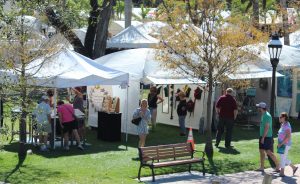 The third and final Bonita Springs National Art Festival of the 2018 season closed today with the announcement of winners in several categories.
The third and final Bonita Springs National Art Festival of the 2018 season closed today with the announcement of winners in several categories.
Sculptor Riza Pishgahi took honors as the overall Best of Show. Oil/acrylic painter Ziao Jiang was chosen as Best of 2D, with mixed media 3D artist Sabra Richards garnering Best of 3D honors.
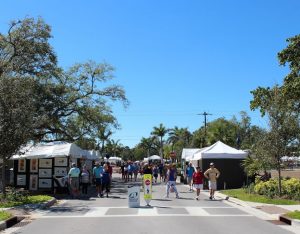 The following 12 artists received Awards of Distinction:
The following 12 artists received Awards of Distinction:
- Kimberly Wilcox, sculpture
- Antanas Ulevicius, sculpture
- Lyn Sedlak-Ford, mixed media 2D
- Abby Warman, oil/acrylics
- Kue King, metal
- Boris Kramer, sculpture
- Wooster & Peaselee, graphics
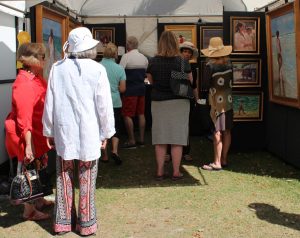 Tricia Young, jewelry
Tricia Young, jewelry- John Furches, graphics
- Don Plumridge, oil/acrylics
- Wayne Gao, mixed media 3D
- Massie Wang, oil/acrylics
The Center for Visual Arts Bonita Springs extends its sincere thanks to every artist who participated in its nationally-ranked art festivals this season, to the hundreds of volunteers who made the shows possible, and the tens of thousands of patrons who attended them and made the events so successful.
________________________________________________________________________
Spotlight on Bonita National March overall Best of Show winner, Reza Pishgahi (03-04-18)
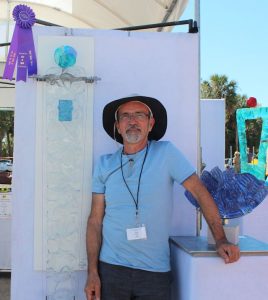 Sculptor Reza Pishgahi took overall Best of Show honors at March’s edition of the Bonita Springs National Art Festival.
Sculptor Reza Pishgahi took overall Best of Show honors at March’s edition of the Bonita Springs National Art Festival.
Reza Pishgahi creates abstract sculpture that represent opposites within nature – the transparent fragility of glass juxtaposed by the opacity and strength of steel and stone. “Despite their differences, these elements complement one another as all are needed to create beauty and balance,” relates the artist. “Cast, cut, and carved glass is joined with cut, shaped and welded steel to create both wall pendants and table top sculptures.
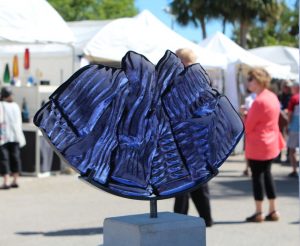 Reza draws inspiration for his wall sculptures from the poet Rumi. “His poetry represents a mystical journey where the seeker symbolically turns towards the truth, grows through love, abandons the ego, and finds truth in order to be of service to the whole of creation without discrimination with regard to beliefs, races, classes and nations,” Reza explains. “Rumi wrote, ‘When you do things from your soul, you feel a river moving in you, a joy.’”
Reza draws inspiration for his wall sculptures from the poet Rumi. “His poetry represents a mystical journey where the seeker symbolically turns towards the truth, grows through love, abandons the ego, and finds truth in order to be of service to the whole of creation without discrimination with regard to beliefs, races, classes and nations,” Reza explains. “Rumi wrote, ‘When you do things from your soul, you feel a river moving in you, a joy.’”
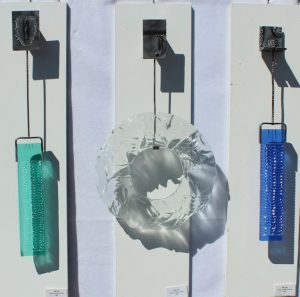 The desire to explore his artistic abilities awakened in Pishgahi in the midst of a career in academia. “I left a full-time position after 20 years to pursue my creative path as an artist – to fulfill my dream to be involved in work that I truly enjoy and that feeds my soul while bringing beauty to others.”
The desire to explore his artistic abilities awakened in Pishgahi in the midst of a career in academia. “I left a full-time position after 20 years to pursue my creative path as an artist – to fulfill my dream to be involved in work that I truly enjoy and that feeds my soul while bringing beauty to others.”
For more on the artist and his body of work, please visit http://www.pishgahi.com/.
__________________________________________________________________
Spotlight on Bonita National March Best of 2D painter, Xiao Song Jiang (03-04-18)
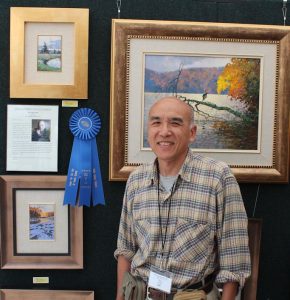 Painter X. Song Jiang was named Best of 2D at March’s edition of the Bonita Springs National Art Festival.
Painter X. Song Jiang was named Best of 2D at March’s edition of the Bonita Springs National Art Festival.
Xiao Song Jiang was born in 1955 in Wuhan, China. In 1978 he studied fine arts at the China Academy of Art, formerly the Zhejiang Art Academy, where he graduated with a Bachelor’s degree in 1982. Four years later, he was selected to further develop his skill at the provincial Hubei Art Academy. During his time there, he gained vast experience painting, sketching, and working to refine his grasp of color and 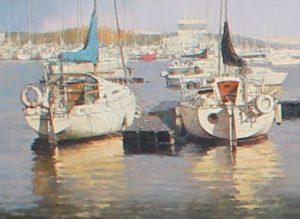 technique.
technique.
Early in his career, Song received numerous awards as a representative of Chinese painting, leading to the display of his work at international art exhibitions in the United States, Japan, Hong Kong, Turkey, and Singapore. He also enjoyed the honor of having four representative works collected and preserved at the National Art Museum of China (NAMOC) and three 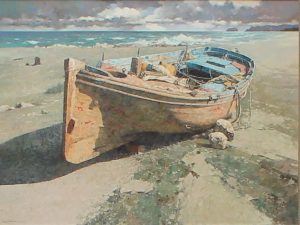 works at the Jiangsu Provincial Art Museum.
works at the Jiangsu Provincial Art Museum.
In 1988, Song immigrated to Canada and developed a passion for its vivid and broad expanses of North American landscape. While there, he travelled widely from coast to coast and gained some 20 years of experience forming his unique style, which is a mixture of brush and knife with attention to the unique 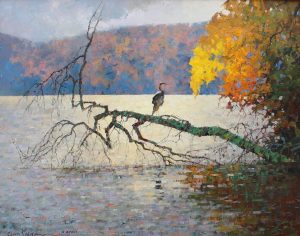 natural detail. That, plus his rich handling of light, shadow and depth, has merited numerous awards in North American exhibitions and art festivals. One that especially stands out is the $25,000 Gold Medal Award in the Signature Division at the Oil Painters of America national exhibition in Evergreen, Colorado in 2012.
natural detail. That, plus his rich handling of light, shadow and depth, has merited numerous awards in North American exhibitions and art festivals. One that especially stands out is the $25,000 Gold Medal Award in the Signature Division at the Oil Painters of America national exhibition in Evergreen, Colorado in 2012.
He now lives by the lake in Toronto, Canada with his wife and son, 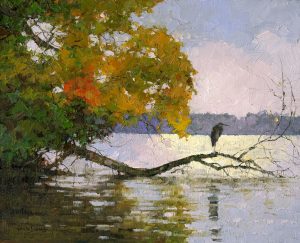 where he is influenced by the beautiful land and friendly people. Through his paintings, he wishes to express his love to the North American landscape and all its people.
where he is influenced by the beautiful land and friendly people. Through his paintings, he wishes to express his love to the North American landscape and all its people.
[Ed. – The foregoing is a modest synopsis based on the biographical information disclosed by the artist on his website, http://www.SongJiangStudio.com. However, it glosses over an inspirational story of a young artist’s drive to 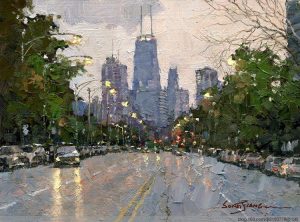 express the beauty he saw all around him notwithstanding a repressive society and work schedule that sought to quash his innate creativity. You see, Jiang grew up during the Cultural Revolution. During this time, Mao Tse-tung had closed all Chinese schools, banned all aspects of Western culture, and forced youngsters like Song to work long hours in factories and on rural farms.
express the beauty he saw all around him notwithstanding a repressive society and work schedule that sought to quash his innate creativity. You see, Jiang grew up during the Cultural Revolution. During this time, Mao Tse-tung had closed all Chinese schools, banned all aspects of Western culture, and forced youngsters like Song to work long hours in factories and on rural farms. 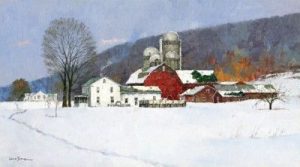 When the Cultural Revolution ended in 1978, he was the only once accepted from the hundreds of applications from his home province to into the Zhejiang Art Academy (now the China Academy of Art). He was in Alberta, Canada attending a solo show of his art during the riots in Tiananmen
When the Cultural Revolution ended in 1978, he was the only once accepted from the hundreds of applications from his home province to into the Zhejiang Art Academy (now the China Academy of Art). He was in Alberta, Canada attending a solo show of his art during the riots in Tiananmen 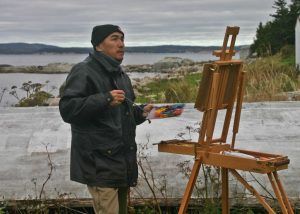 Square in 1988. He did not simply immigrate at that time. Because he had written articles critical of the government, he obtained asylum, where he was joined by his wife and son. Gussie Fauntleroy tells Jiang’s full story in Southwest Art. You can find the article here: http://www.southwestart.com/featured/jiang-xs-nov2012.]
Square in 1988. He did not simply immigrate at that time. Because he had written articles critical of the government, he obtained asylum, where he was joined by his wife and son. Gussie Fauntleroy tells Jiang’s full story in Southwest Art. You can find the article here: http://www.southwestart.com/featured/jiang-xs-nov2012.]
___________________________________________________
Spotlight on Best of 3D glass sculptor Sabra Richards (03-04-18)
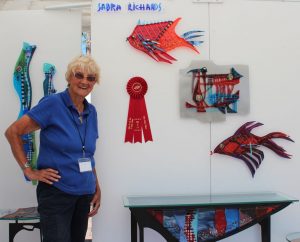 Glass sculptor Sabra Richards was named Best of 3D at March’s edition of the Bonita Springs National Art Festival.
Glass sculptor Sabra Richards was named Best of 3D at March’s edition of the Bonita Springs National Art Festival.
After working in several media, Richards has settled on kiln-formed glass as her medium of choice. “I find the challenge of glass, and the combination of other materials to enhance the glass, very exciting and challenging,” Sabra states.
She 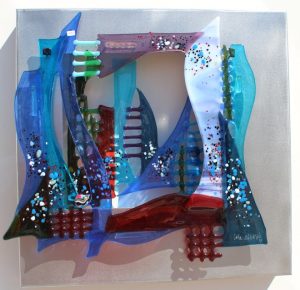 starts with sheets of Bullseye Fusible Glass. Her method is very bold and direct.
starts with sheets of Bullseye Fusible Glass. Her method is very bold and direct.
“I choose the color, individual ones and others layered to achieve other colors,” she explains. “I create the design, adding and subtracting glass and, most importantly, adding cane and components made at the furnace, usually at the Corning Glass Museum. Sixteen pieces of glass, formed into a block, fired and then put into the furnace, turned and heated until malleable, and then pulled into the cane that you see in my work.”
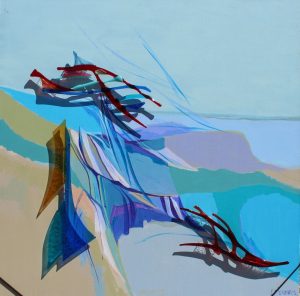 Richards then combines the finished glass with previously welded steel, or layers of metal or constructions for wall pieces. The process is long and involved, but the results are wonderful to behold.
Richards then combines the finished glass with previously welded steel, or layers of metal or constructions for wall pieces. The process is long and involved, but the results are wonderful to behold.
Her work includes glass wall sculpture, free-standing outdoor sculpture, designer tables, steel and glass fish and commissioned public art installations.
Richards has a BFA Cum Laude from Syracuse University, 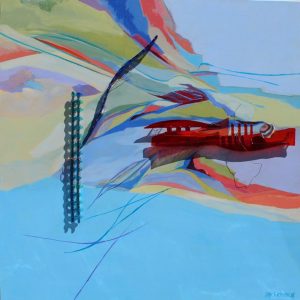 and had done graduate work at Parsons School of Design, SUNY Cortland, Syracuse and Bennington College. She is in the Who’s Who in American Art, Printworld Who’s Who, and American Art Collector (2005, 2006).
and had done graduate work at Parsons School of Design, SUNY Cortland, Syracuse and Bennington College. She is in the Who’s Who in American Art, Printworld Who’s Who, and American Art Collector (2005, 2006).
Her work can be found in private collections throughout the country as well as U.S. State Department (Collection of Heads of State), the Lipson Cancer Center at Rochester General Hospital, Northwest Airlines Terminal in Portland, Oregon, the Ann Arbor Public Library, Blue Cross 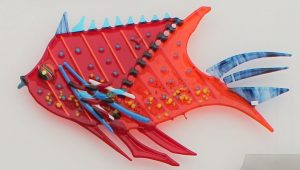 & Blue Shield in Rochester and in Lansing, Michigan, the Eastman Kodak building in Rochester and IBM Atlanta.
& Blue Shield in Rochester and in Lansing, Michigan, the Eastman Kodak building in Rochester and IBM Atlanta.
In January, Richards was one of two artists receiving overall Best of Show honors at the Estero Fine Art Show.
_______________________________________________________
Spotlight on Award of Distinction winner Tara Funk Grim (03-04-18)
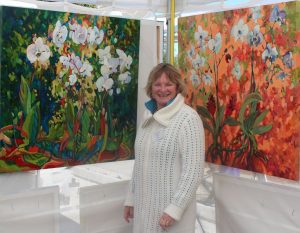 One of the artists who received an Award of Distinction at this weekend’s Bonita Springs National Art Festival is Tara Funk Grim.
One of the artists who received an Award of Distinction at this weekend’s Bonita Springs National Art Festival is Tara Funk Grim.
Tara layers and weaves acrylic with a wide of variety of handmade and altered papers and found fabrics to open doorways to a journey into the imagination. Intuitive choices, thoughts and ideas are expanded and the many layers provide pathways to invention, innovation and discovery.
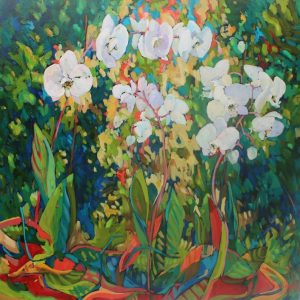 Grim renders her most imaginative work in the studio, where she works with a variety of materials including acrylics, collage paper and fabric. “My paintings start with an idea, color and composition,” says Grim. From there, her paintings evolve through a process of intuition, experience and a degree of chance. As she applies and manipulates her media to the canvas, she allows the subject to unfold organically, adding pieces of paper, fabric and even sheet music to the background to construct a collage that creates interest and curiosity and keeps the
Grim renders her most imaginative work in the studio, where she works with a variety of materials including acrylics, collage paper and fabric. “My paintings start with an idea, color and composition,” says Grim. From there, her paintings evolve through a process of intuition, experience and a degree of chance. As she applies and manipulates her media to the canvas, she allows the subject to unfold organically, adding pieces of paper, fabric and even sheet music to the background to construct a collage that creates interest and curiosity and keeps the 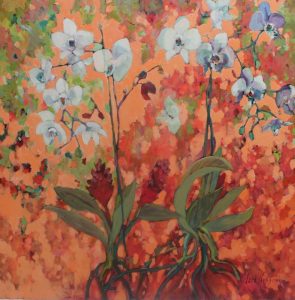 painting fresh with each new viewing.
painting fresh with each new viewing.
“This method of working allows my imagination to soar,” says Tara.
A different constellation of influences and motivations come into play, however, where Grim’s plein air painting is concerned. Here, the artist combines her passion for the visual world with that of the world of the imagination. “Each painting is a journey into the unknown,” Tara says expansively.
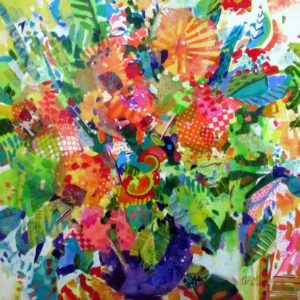 “The heart and mind become one with inspiration, imagination and materials. It is this world of endless possibilities and discovery that beckons me.”
“The heart and mind become one with inspiration, imagination and materials. It is this world of endless possibilities and discovery that beckons me.”
Grim began her art career inauspiciously painting seasonal themes in Atlantic City boardwalk store windows. From there, she continued her education at Chestnut Hill College, where she obtained a Bachelor of Arts, before going on to earn her teacher’s certification from Kutztown University.
Tara 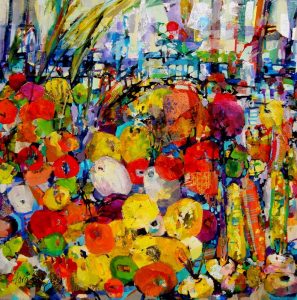 has now been painting for more than 30 years. She is a signature member of the Pennsylvania Watercolor Society, and has work featured in several publications, including 100 Plein Air Painters of the Mid-Atlantic, AcrylicWorks 2: Radical Breakthroughs, AcrylicWorks 3: Celebrating Texture, and Art Journal Animals: A Collection of Inspiring Contemporary Masterworks. However, one of her proudest moments was having her painting Ali Gator selected by ArtFest Fort Myers for its 2017 poster. In fact, it is an honor she’s experienced twice. In 2014, ArtFest chose her painting Flamingo Foliage for its official poster.
has now been painting for more than 30 years. She is a signature member of the Pennsylvania Watercolor Society, and has work featured in several publications, including 100 Plein Air Painters of the Mid-Atlantic, AcrylicWorks 2: Radical Breakthroughs, AcrylicWorks 3: Celebrating Texture, and Art Journal Animals: A Collection of Inspiring Contemporary Masterworks. However, one of her proudest moments was having her painting Ali Gator selected by ArtFest Fort Myers for its 2017 poster. In fact, it is an honor she’s experienced twice. In 2014, ArtFest chose her painting Flamingo Foliage for its official poster.
_________________________________________________________________
Wyoming bronze sculptor Ben Foster back at Bonita Springs National (03-02-18)
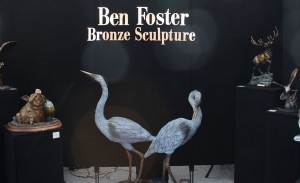 One of the artists participating in this weekend’s Bonita Springs National Art Festival is bronze sculptor Ben Foster. Foster’s bronze sculptures are collected internationally, and the artist has designed and installed monumental works at universities, schools, municipalities, parks and corporations throughout the United States. Among his commissioned pieces is a “Gemsbok” onyx
One of the artists participating in this weekend’s Bonita Springs National Art Festival is bronze sculptor Ben Foster. Foster’s bronze sculptures are collected internationally, and the artist has designed and installed monumental works at universities, schools, municipalities, parks and corporations throughout the United States. Among his commissioned pieces is a “Gemsbok” onyx 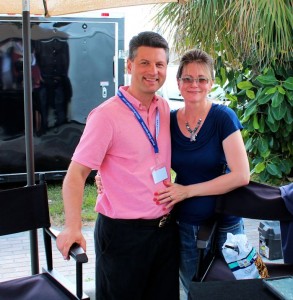 which was presented to ten different heads of state in the middle east, a bighorn bust that serves as the logo for a company in Cody, Wyoming, a five-foot-tall breaching humpback whale and a piece titled Morning Strut for the Lander chapter of the National Wild Turkey Federation. Ben’s sculptures have been purchased by major fly fishing companies, outfitters, resorts, and private art collectors both in the United States and Japan, Australia and Scotland.
which was presented to ten different heads of state in the middle east, a bighorn bust that serves as the logo for a company in Cody, Wyoming, a five-foot-tall breaching humpback whale and a piece titled Morning Strut for the Lander chapter of the National Wild Turkey Federation. Ben’s sculptures have been purchased by major fly fishing companies, outfitters, resorts, and private art collectors both in the United States and Japan, Australia and Scotland.
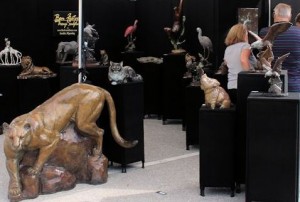 Foster has been featured in numerous one-man shows, group exhibitions, as well as select juried exhibitions across the nation. His work has been profiled by magazines such as Southwest Art, Wildlife Art, Sporting Classics, Private Air, Fly Rod and Reel and The Dupont Registry. In 1997, Ben’s sculpture First Catch of the Day won “Best of Show” at the Eighteenth Annual Audubon Wildlife
Foster has been featured in numerous one-man shows, group exhibitions, as well as select juried exhibitions across the nation. His work has been profiled by magazines such as Southwest Art, Wildlife Art, Sporting Classics, Private Air, Fly Rod and Reel and The Dupont Registry. In 1997, Ben’s sculpture First Catch of the Day won “Best of Show” at the Eighteenth Annual Audubon Wildlife 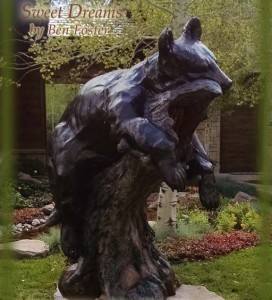 Art Show. He credits his ability to capture the grace and movement of his subjects to his love of fishing and the outdoors.
Art Show. He credits his ability to capture the grace and movement of his subjects to his love of fishing and the outdoors.
In 2015, Ben made the local news when a 20-foot trailer packed with his sculpture was stolen three days before Christmas from a Naples storage facility off Collier Boulevard. Along with 45 bronzes worth an estimated $230,000, the thieves took everything Foster and his wife, Andrea, needed to set up their booth at each of the outdoor art shows they were planning to attend, including his pop-up tent, pedestals, wall c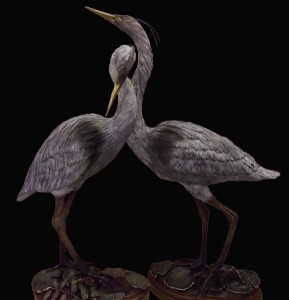 overings and signs. But with the help of his fellow exhibitors and collectors from across the country, Foster was able to piece together enough of a collection to prevent him from having to pull out of that season’s shows. Regrettably, neither the trailer nor the artworks has ever been recovered.
overings and signs. But with the help of his fellow exhibitors and collectors from across the country, Foster was able to piece together enough of a collection to prevent him from having to pull out of that season’s shows. Regrettably, neither the trailer nor the artworks has ever been recovered.
While Foster garnered a considerable number of commissions from 2016’s shows, it will take years to replace the 45 artworks that were inside the stolen trailer. Some of Foster’s larger bronzes take more than nine months to complete from inception to casting and fabrication 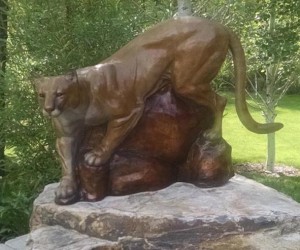 at the foundry. “There are a limited number of foundries, and they are all really busy. Most can only handle six to nine pieces a year, so there’s a limit to how many bronzes I can create each year,” Foster concedes.
at the foundry. “There are a limited number of foundries, and they are all really busy. Most can only handle six to nine pieces a year, so there’s a limit to how many bronzes I can create each year,” Foster concedes.
But Foster is not easily discouraged, and he will be back in Southwest Florida for this weekend’s Bonita Springs National Art Festival. Be sure to drop by his booth and offer him and Andrea your best wishes. Better still, pick up a bronze for your private collection.
_____________________________________________________
Edward Loedding – are they paintings or a photographs (03-02-18)
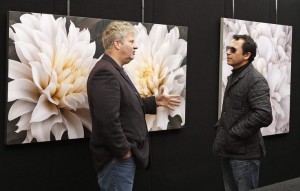 Award of Distinction winner Edward Loedding is one of the artists bringing work to this weekend’s Bonita Springs National Art Festival. On first view, most people encountering a Loedding composition ask themselves, if not the artist himself, “Is this a painting or a photograph?”
Award of Distinction winner Edward Loedding is one of the artists bringing work to this weekend’s Bonita Springs National Art Festival. On first view, most people encountering a Loedding composition ask themselves, if not the artist himself, “Is this a painting or a photograph?”
Loedding would probably bristle at being 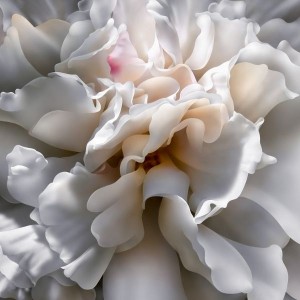 pigeonholed as a digital artist. You see, that’s just medium as far as he is concerned. His art, by contrast, seeks to bridge the gap between realism and abstraction. He merely uses a smattering of digital tools to edit his photographs in order to accomplish this overarching goal. “Elements of both [painting and photography] are merged together using digital tools to form a totally new way of creating art,” the artist explains on his website. “The tools I use are a digital SLR camera, computer, Adobe PhotoShop, digitizing tablet and
pigeonholed as a digital artist. You see, that’s just medium as far as he is concerned. His art, by contrast, seeks to bridge the gap between realism and abstraction. He merely uses a smattering of digital tools to edit his photographs in order to accomplish this overarching goal. “Elements of both [painting and photography] are merged together using digital tools to form a totally new way of creating art,” the artist explains on his website. “The tools I use are a digital SLR camera, computer, Adobe PhotoShop, digitizing tablet and 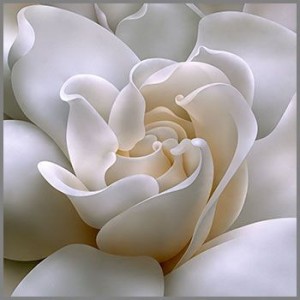 stylus, and a modified Roland Symphony12 color printer.”
stylus, and a modified Roland Symphony12 color printer.”
Loedding’s subjects include flowers and scenes of the Vermont countryside. “I choose my subjects based on geometries that provide potential for rhythm and harmony,” says Loedding. “Each piece of my art is a composite of multiple photos and additional elements that I create directly in the computer. The second step is orchestrating all of the gathered elements; deciding which elements to include and where they should be placed on the 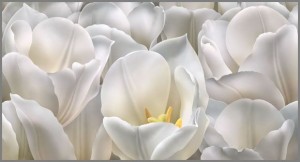 digital canvas. Once all of the pieces are in place, it’s time to make them work together. I transform all of the pieces individually, changing their size, orientation, color, shadows, highlights – everything – until they form a cohesive and lyrical composition.”
digital canvas. Once all of the pieces are in place, it’s time to make them work together. I transform all of the pieces individually, changing their size, orientation, color, shadows, highlights – everything – until they form a cohesive and lyrical composition.”
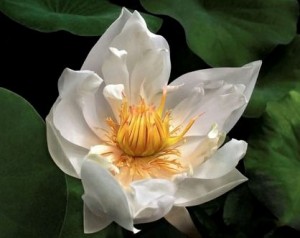 Once he is satisfied with the structure of his composition, Loedding is ready to begin the painting. First, he breaks down the photographic qualities of the image and reduces it to very smooth areas of color. Then, using a combination of different digital paintbrushes, he begins to reshape those areas back into focus, changing every line, every curve, every detail, making them say exactly what he wants them to say, creating a
Once he is satisfied with the structure of his composition, Loedding is ready to begin the painting. First, he breaks down the photographic qualities of the image and reduces it to very smooth areas of color. Then, using a combination of different digital paintbrushes, he begins to reshape those areas back into focus, changing every line, every curve, every detail, making them say exactly what he wants them to say, creating a 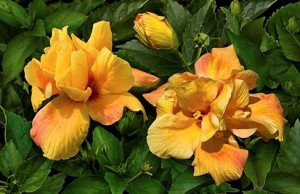 perfect balance and harmony among all of the elements in the artwork. Finally, the art is printed on canvas using archival pigmented ink, varnished, and stretched. All of the images are presented as signed and numbered limited editions.
perfect balance and harmony among all of the elements in the artwork. Finally, the art is printed on canvas using archival pigmented ink, varnished, and stretched. All of the images are presented as signed and numbered limited editions.
Although Loedding comes from a painting tradition, he finds that digital tools 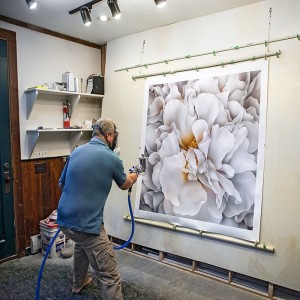 uniquely enable him to bridge the abstract/realism divide. “Abstract art is a re-creation of the process of conceptualization,” Loedding points out. “It has often failed because it is spoken in a strange and personal language that offers no common point of reference to the uninitiated observer. Abstract art has been esoteric at its best, intimidating and alienating at its worst. [At the same time], in our society, where an overabundance of imagery and information is easily accessible, realism is demoted to the status of data. Without a corresponding
uniquely enable him to bridge the abstract/realism divide. “Abstract art is a re-creation of the process of conceptualization,” Loedding points out. “It has often failed because it is spoken in a strange and personal language that offers no common point of reference to the uninitiated observer. Abstract art has been esoteric at its best, intimidating and alienating at its worst. [At the same time], in our society, where an overabundance of imagery and information is easily accessible, realism is demoted to the status of data. Without a corresponding 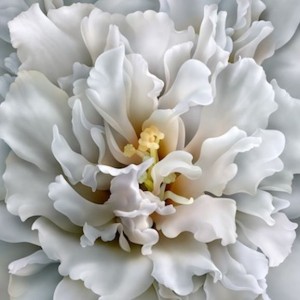 value judgment, its primary merit is merely its degree of accuracy …. My approach is not to blur the edges of realism or sharpen the focus of abstraction, but to create a common ground where the two can meet; not as opponents coerced into an uneasy balance, but as equal partners singing a new song with one voice.”
value judgment, its primary merit is merely its degree of accuracy …. My approach is not to blur the edges of realism or sharpen the focus of abstraction, but to create a common ground where the two can meet; not as opponents coerced into an uneasy balance, but as equal partners singing a new song with one voice.”
The resulting images are as layered and complex as the artist himself. “People generally don’t buy my work the first time they see it—they really need to see it a couple of times before they make that 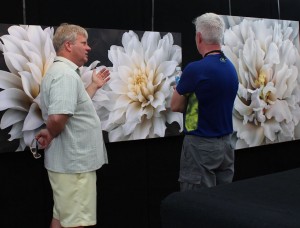 decision,” Loedding concedes. “And, I’ve been doing it long enough to understand that today’s enthusiasts are tomorrow’s customers.”
decision,” Loedding concedes. “And, I’ve been doing it long enough to understand that today’s enthusiasts are tomorrow’s customers.”
Toward that end, Loedding returns to Southwest Florida periodically throughout its annual art fair and festival season and, in addition to finding growing acceptance by area art collectors, he is winning critical acclaim as well. In November of 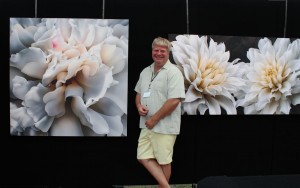 2015, he was one of ten artists who received a coveted Award of Distinction at the Estero Fine Art Show at the Miromar Design Center. In 2016 he repeated the feat at the Bonita Springs National Art Festival that took place on January 30 & 31. This weekend, you can meet the artist and examine his work in Riverside Park at the Bonita Springs National Art Festival. The show opens at 10 a.m. and closes at 5 p.m. each day.
2015, he was one of ten artists who received a coveted Award of Distinction at the Estero Fine Art Show at the Miromar Design Center. In 2016 he repeated the feat at the Bonita Springs National Art Festival that took place on January 30 & 31. This weekend, you can meet the artist and examine his work in Riverside Park at the Bonita Springs National Art Festival. The show opens at 10 a.m. and closes at 5 p.m. each day.
_____________________________________________________________________
Bonita artist Kimberly Marshall exhibiting at Bonita National this weekend (01-11-18)
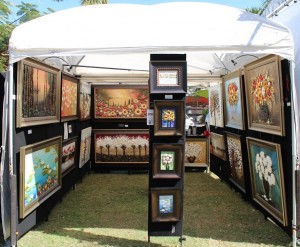 One of the artists taking part in this weekend’s Bonita Springs National Art Festival in historic Riverside Park is Kimberly Marshall, an internationally-renowned Bonita Springs artist who has won several awards for her creative talents in painting and mixed media. Though her subject matter is vast, some of Kimberly’s favorite motifs are flowers, seascapes and landscapes. Her paintings inspire simple beauty, serenity, and joy. Her motifs
One of the artists taking part in this weekend’s Bonita Springs National Art Festival in historic Riverside Park is Kimberly Marshall, an internationally-renowned Bonita Springs artist who has won several awards for her creative talents in painting and mixed media. Though her subject matter is vast, some of Kimberly’s favorite motifs are flowers, seascapes and landscapes. Her paintings inspire simple beauty, serenity, and joy. Her motifs 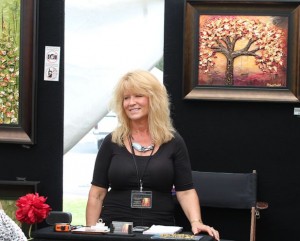 are inspired by nature, her travels and photography.
are inspired by nature, her travels and photography.
Marshall specializes in impasto painting with acrylics and oils, which she applies to her canvas with a palette knife. “I refer to my style as sculpting in paint,” says Kimberly, who graduated with a degree in Fine Arts in Toronto, Canada
She painstakingly combines up to 50 layers of acrylics and 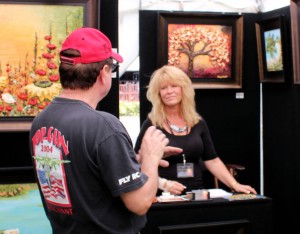 oils in a single painting, emphasizing different impasto textures to produce a 3-dimensional, sculptural effect on canvas that makes her flowers, fields, landscapes and seascapes really come alive. In fact, if you’ve ever wondered what a van Gogh sunflower painting, floral composition or water lilies would look like with 3-D glasses, then you’ll revel in Marshall’s luminous homages.
oils in a single painting, emphasizing different impasto textures to produce a 3-dimensional, sculptural effect on canvas that makes her flowers, fields, landscapes and seascapes really come alive. In fact, if you’ve ever wondered what a van Gogh sunflower painting, floral composition or water lilies would look like with 3-D glasses, then you’ll revel in Marshall’s luminous homages.
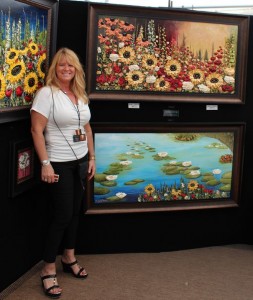 “By combining several techniques together, I can expound on my creativity and allow my art to flow like the textures which surround our world,” Kimberly expounds. Of course, her approach comes at a cost. “I’ve had to drastically reduce the number of shows at which I can exhibit,” the artist points out. It takes a mindboggling amount of time to engraft layer upon layer of paint to build an impasto that juts as much as half an inch off the surface of the canvas. As a consequence, Kimberly finds it necessary to spend more time in the studio and less time on the festival circuit, appearing in only 14 or 15 each year instead of the nearly three dozen festivals that once monopolized her busy schedule.
“By combining several techniques together, I can expound on my creativity and allow my art to flow like the textures which surround our world,” Kimberly expounds. Of course, her approach comes at a cost. “I’ve had to drastically reduce the number of shows at which I can exhibit,” the artist points out. It takes a mindboggling amount of time to engraft layer upon layer of paint to build an impasto that juts as much as half an inch off the surface of the canvas. As a consequence, Kimberly finds it necessary to spend more time in the studio and less time on the festival circuit, appearing in only 14 or 15 each year instead of the nearly three dozen festivals that once monopolized her busy schedule.
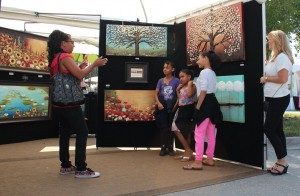 But that’s fine with the artist, who feels a consuming need to create. “My art is an expression of my passion and love for life and all its gifts and amazing beauty,” she acknowledges. Kimberly Marshall is located in Bonita Springs, Florida, and sells her original paintings at juried fine art shows and exhibitions nationwide.
But that’s fine with the artist, who feels a consuming need to create. “My art is an expression of my passion and love for life and all its gifts and amazing beauty,” she acknowledges. Kimberly Marshall is located in Bonita Springs, Florida, and sells her original paintings at juried fine art shows and exhibitions nationwide.
________________________________________________________
Local photographer Jack Megela returns to Bonita National (03-02-18)
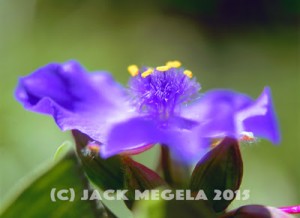 Bonita Springs National Art Festival reconvenes in picturesque Riverside Park on the weekend of March 3 & 4. Among the area artists who have been accepted into this juried show is Naples fine art photographer Jack Megela.
Bonita Springs National Art Festival reconvenes in picturesque Riverside Park on the weekend of March 3 & 4. Among the area artists who have been accepted into this juried show is Naples fine art photographer Jack Megela.
Born in Youngstown, Ohio, Megela studied Criminal Justice at Lorain County Community College while working as a State Trooper with the 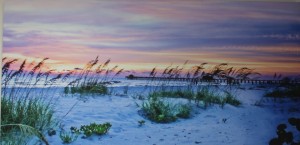 Ohio Highway Patrol. Later, he attended Kent State University and while working as a Detective Sergeant with the Canton, Ohio Sheriff’s Department, he earned a Bachelor’s Degree in Law Enforcement Administration. Having extensive training in all aspects of photography from camera
Ohio Highway Patrol. Later, he attended Kent State University and while working as a Detective Sergeant with the Canton, Ohio Sheriff’s Department, he earned a Bachelor’s Degree in Law Enforcement Administration. Having extensive training in all aspects of photography from camera 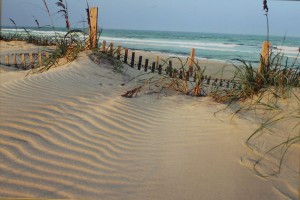 work to darkroom developing and printing, he put his skills to work during his daily regiment in everything from traffic fatalities to major crime scenes of all types, including numerous homicide investigations.
work to darkroom developing and printing, he put his skills to work during his daily regiment in everything from traffic fatalities to major crime scenes of all types, including numerous homicide investigations.
After retiring from law enforcement, Jack returned to Kent State University to pursue a 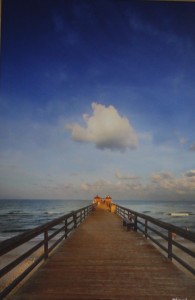 curriculum in Art and Fine Art Photography. He then travelled the United States by recreational vehicle, visiting all 49 land bound states before he and his wife, Marianne, settled in Naples near the edge of the Fakahatchee Strand and The Big Cypress National Preserve.
curriculum in Art and Fine Art Photography. He then travelled the United States by recreational vehicle, visiting all 49 land bound states before he and his wife, Marianne, settled in Naples near the edge of the Fakahatchee Strand and The Big Cypress National Preserve.
Megela now spends many hours each week photographing in the Florida Everglades and on the beaches in the Gulf of Mexico, where he directs his photographic experience toward nature and landmarks in and around the City Of Naples. “It has been a long road from investigating, documenting and photographing human tragedy as a law enforcement officer to photographing in the quiet magnificence of nature,” Jack shares. “It’s been a transition from a world of violence, chaos and 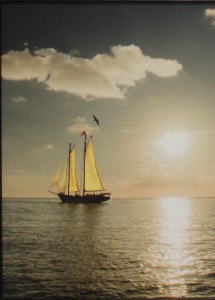 tragedy to a world of peace and tranquility, a world that makes sense. Art makes sense, embracing us as it gives us refuge from catastrophe and despair.”
tragedy to a world of peace and tranquility, a world that makes sense. Art makes sense, embracing us as it gives us refuge from catastrophe and despair.”
Over the past 20-plus years, Megela has participated in hundreds of juried outdoor art shows and exhibitions at venues throughout the United States. He has received more than 45 awards for his photographs and his work is held in numerous corporate and private collections all over the world. You can see his work this weekend at the Bonita Springs National Art Festival in Riverside Park.
____________________________________________________________________
Sculptor Peter Rujuwa bringing Shona-inspired pieces to Bonita National (03-02-18)
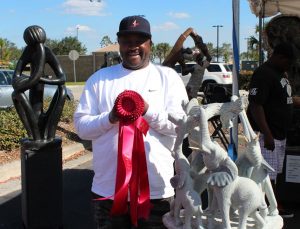 Sculptor Peter Rujuwa was one of ten artists receiving Awards of Distinction at the Estero Fine Art Show on January 6 & 7. He’s bringing his distinctive sculpture back to Riverside Park, where he will be part of this weekend’s Bonita Springs National Art Festival.
Sculptor Peter Rujuwa was one of ten artists receiving Awards of Distinction at the Estero Fine Art Show on January 6 & 7. He’s bringing his distinctive sculpture back to Riverside Park, where he will be part of this weekend’s Bonita Springs National Art Festival.
Rujuwa comes from the Shona tribe in Zimbabwe, and his stone sculptures are influenced by the tribal art of the Shona 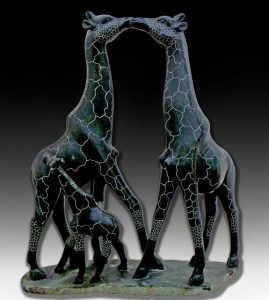 tribe. (Zimbabwe, by the way, means “houses made of stone.”)
tribe. (Zimbabwe, by the way, means “houses made of stone.”)
“At around age six,” Rujuwa confides, “my friends and I made our own carved toys using soapstone, which was abundant in the mountains.” Their improvised chisels were dry sticks split in half and their files were rough stone surfaces. Today, serpentine stone is more suitable to Rujuwa’s sculpture because it is harder than alabaster, marble and soapstone. It’s hardness makes it easier to work with because it does not crumble under the chisel.
Rujuwa lives and maintains his studio in Greenwood, Indiana. For more information about him and his sculpture, please visit http://www.UniqueRockArt.com.
__________________________________________________________________________
Award of Distinction winner Thomas Sanders returns to Bonita Springs National (03-02-18)
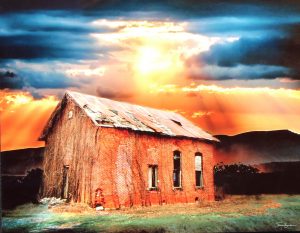 One of the artists taking part in this weekend’s Bonita National Art Festival is photographer Thomas Sanders, a previous Award of Distinction winner.
One of the artists taking part in this weekend’s Bonita National Art Festival is photographer Thomas Sanders, a previous Award of Distinction winner.
“From the time I bought my first camera for a photojournalism class in college, I realized I had a passion for photography,” relates Sanders. “Since then I have been comfortable with a camera in my hands whether I 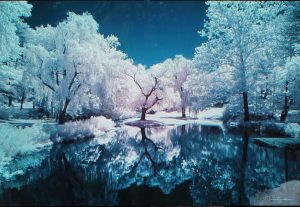 was taking shots of vacation or on mission trips to Africa or Southeast Asia.”
was taking shots of vacation or on mission trips to Africa or Southeast Asia.”
Sanders’ family and friends continually validated his eye for photography, encouraging him to follow his passion. In the Spring of 2012, he finally began formulating a plan to leave the corporate world behind in favor of a career in fine art photography.
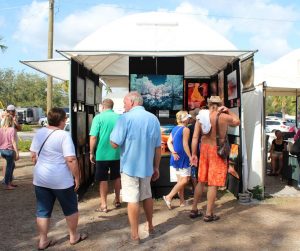 “I upgraded my equipment and software and began a crash course to try to shorten the learning curve I was facing,” Sanders reflects. His plans came to fruition two springs ago. He retired. He and his wife purchased a motorhome. And with a full tank of freedom, they headed out to photograph the country and share Thomas’ images with enthusiasts at art shows.
“I upgraded my equipment and software and began a crash course to try to shorten the learning curve I was facing,” Sanders reflects. His plans came to fruition two springs ago. He retired. He and his wife purchased a motorhome. And with a full tank of freedom, they headed out to photograph the country and share Thomas’ images with enthusiasts at art shows.
Along the way, Sanders has come to realize that photography is a life-long learning process.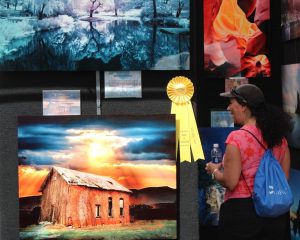 “No matter where you are in the process, there is always more to learn should you care to do so,” Sanders avows. “Technology is constantly evolving bringing new and innovative processes.”
“No matter where you are in the process, there is always more to learn should you care to do so,” Sanders avows. “Technology is constantly evolving bringing new and innovative processes.”
Sanders has also come to realize that photography requires more than book learning. While it is unquestionably possible to learn a ton of technical skills from perusing books, manuals, and tutorials, there is an intangible 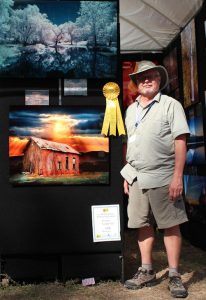 that all the technical books or rules of composition can’t teach. It’s the ability to convey emotion through a two dimensional medium.
that all the technical books or rules of composition can’t teach. It’s the ability to convey emotion through a two dimensional medium.
“It’s the sound of the waves crashing into a rocky shoreline, the silent beauty of a meadow filled with spring flowers or the unexpected joy of an orphan child living in the most primitive conditions,” Sanders proclaims, waxing philosophical.
“All elicit different feelings deep within us. I believe what makes a great photographer is the ability to convey those feelings, calling on all the technical skills they possess, and transferring their own emotions to the image they are creating.”
And 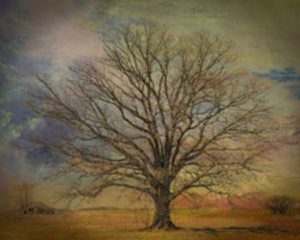 that’s the challenge and goal that Sanders embraces each day through his work.
that’s the challenge and goal that Sanders embraces each day through his work.
“I want you to hear the crashing of the waves, smell the summer flowers, or feel the innocent joy of that orphan child. To the extent I am able to do so, [that] will, for me, be the measure of my success as a photographer. I consider myself a work in process. Constantly trying to hone my craft and improve the images I create.”
_____________________________________________________________________
Rolling waves, sea life and sunsets inspires Anisa Stewart’s fine art jewelry (03-02-18)
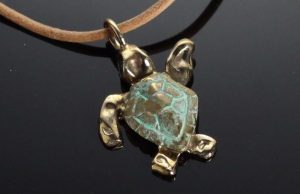 One of the artists taking part in this weekend’s Bonita National Art Festival is Southwest Florida native Anisa Stewart.
One of the artists taking part in this weekend’s Bonita National Art Festival is Southwest Florida native Anisa Stewart.
“I am obviously and whole-heartedly in love with this area,” the fine art jeweler confides. “And this area is what gives me great inspiration for the jewelry we do. Rolling waves, intense sunsets, incredible wildlife, 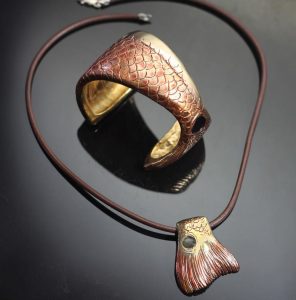 sea life… how can you not be inspired! Not to mention having kids that love being on the water and watching them experience nature is, in itself, amazingly inspirational.”
sea life… how can you not be inspired! Not to mention having kids that love being on the water and watching them experience nature is, in itself, amazingly inspirational.”
Stewart started making jewelry as an apprentice for a local award-winning jeweler, Mark Loren, when she was still in high school. She had the great privilege of working with him for a total of 15 years. Thanks in large part to his mentorship, she won four highly-coveted National Design Awards during that time.
“After 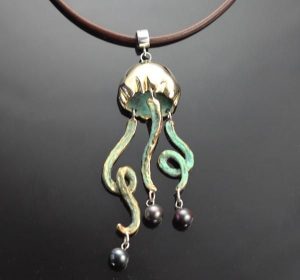 my second child was born, I decided it was time to do my own thing and make the jewelry that I wanted to do,” reports Anisa. So in 2006, she launched Anisa Stewart Designs. Over the past decade, the company has grown, a reflection of Stewart’s focus on the importance of customer service and satisfaction.
my second child was born, I decided it was time to do my own thing and make the jewelry that I wanted to do,” reports Anisa. So in 2006, she launched Anisa Stewart Designs. Over the past decade, the company has grown, a reflection of Stewart’s focus on the importance of customer service and satisfaction.
“My Mother and I make all the jewelry with the lost wax casting method, which means I start off carving an original wax model that I then mold, burn out the wax 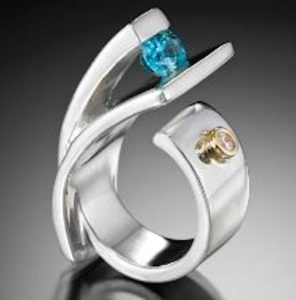 and then pour molten metal into the void,” Anisa explains. “This process allows us to get great detail into the piece.’
and then pour molten metal into the void,” Anisa explains. “This process allows us to get great detail into the piece.’
Anisa believes jewelry should be worn daily and for a lifetime. She keeps that in mind when she makes a piece, making sure it is extremely comfortable and of substantial weight.
“Jewelry is a great way to express yourself,” Anisa expounds. “Let’s live life together in a big, bold, funky and fun way through great jewelry … I’ll make it and you wear it!”
________________________________________________________________________
Clayton Swartz bringing metal sculpture to Riverside Park for Naples National (03-02-18)
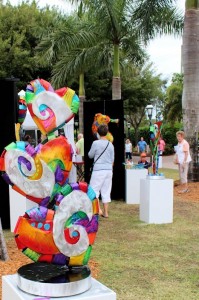 One of the artists taking part in the Bonita Springs National Art Festival on March 3 & 4 is sculptor Clayton Swartz, whose piece Skyward is part of the Florida Gulf Coast University public art collection. Although he is an accomplished public artist with instantly-recognizable pieces in a number of municipal and county public art collections, Swartz relishes the opportunity to talk art with enthusiasts and collectors at outdoor art fairs and festivals like this weekend’s Bonita Springs National Art Festival.
One of the artists taking part in the Bonita Springs National Art Festival on March 3 & 4 is sculptor Clayton Swartz, whose piece Skyward is part of the Florida Gulf Coast University public art collection. Although he is an accomplished public artist with instantly-recognizable pieces in a number of municipal and county public art collections, Swartz relishes the opportunity to talk art with enthusiasts and collectors at outdoor art fairs and festivals like this weekend’s Bonita Springs National Art Festival.
Swartz started out as an abstract painter, a hobby he pursued while attending St. Petersburg College. After receiving his BFA in painting and sculpture from the University of South Florida, he began a five-year tenure as an 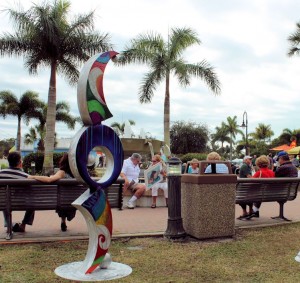 art teacher at St. Petersburg’s Northeast High School. While he continued to paint, and even dabble a bit in photography, he increasingly favored metal sculpture, developing a unique style that concentrated on colorful biomorphic and abstract shapes that ranged from sea life to cityscapes. He then took to the road, exhibiting at art festivals throughout the state, quickly gaining a reputation and following that has enabled him to pursue art professionally since 2005.
art teacher at St. Petersburg’s Northeast High School. While he continued to paint, and even dabble a bit in photography, he increasingly favored metal sculpture, developing a unique style that concentrated on colorful biomorphic and abstract shapes that ranged from sea life to cityscapes. He then took to the road, exhibiting at art festivals throughout the state, quickly gaining a reputation and following that has enabled him to pursue art professionally since 2005.
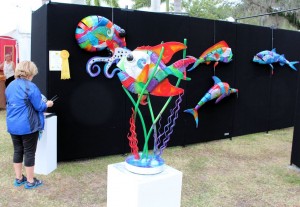 “My medium lends itself more to public art,” Swartz told Tampa Bay Times Staff Writer Mike Brassfield in September of 2010. “It withstands the elements, and I tend to like to work big.” He was referring at the time to an 18-foot-tall aluminum sculpture by the name of Constellation that was on display in the landscaped medians of Cleveland Street as part of Clearwater’s Sculpture 360 public
“My medium lends itself more to public art,” Swartz told Tampa Bay Times Staff Writer Mike Brassfield in September of 2010. “It withstands the elements, and I tend to like to work big.” He was referring at the time to an 18-foot-tall aluminum sculpture by the name of Constellation that was on display in the landscaped medians of Cleveland Street as part of Clearwater’s Sculpture 360 public 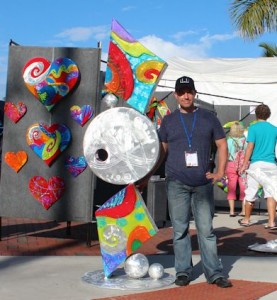 art program.
art program.
Swartz is perhaps best known for his 1,200 pound, 20-foot-tall sculpture The Heart of Pinellas, which is located at Park Station in Largo. This monumental work aptly illustrates Swartz’s signature style. The piece is crafted of brushed aluminum and features as host of interwoven geometric and biomorphic shapes. His works are finished with painted surfaces which he creates with a host of air and other brushes and utilize an automotive finish that gives the topography of his sculpture dynamic colors and an iridescent sheen.
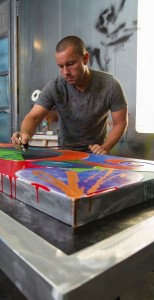 In addition to Florida Gulf Coast University, Sculpture 360 and Largo’s Park Station, Swartz’s work has been included in such major public and corporate collections as the City of Pinellas Park, Pinellas Gateway Chamber of Commerce, Pinellas Sun Coast Transit Authority PSTA, All Children’s Hospital in St. Petersburg (which has 20 of Swartz’s signature brightly-colored creations), Gateway Apartments, Marriott Ocean Pointe Hotel, Barrymore Hotel, 400 Beach Seafood & Tap House Restaurant, Salt Rock Grill, Pinnacle Hosting Group, Harrison School of the Arts, and Homewood Suites Tampa/Brandon (which features Swartz’s 7-foot sculpture Shades of the Florida Reef to better connect extended-stay travelers with the community in which they are staying).
In addition to Florida Gulf Coast University, Sculpture 360 and Largo’s Park Station, Swartz’s work has been included in such major public and corporate collections as the City of Pinellas Park, Pinellas Gateway Chamber of Commerce, Pinellas Sun Coast Transit Authority PSTA, All Children’s Hospital in St. Petersburg (which has 20 of Swartz’s signature brightly-colored creations), Gateway Apartments, Marriott Ocean Pointe Hotel, Barrymore Hotel, 400 Beach Seafood & Tap House Restaurant, Salt Rock Grill, Pinnacle Hosting Group, Harrison School of the Arts, and Homewood Suites Tampa/Brandon (which features Swartz’s 7-foot sculpture Shades of the Florida Reef to better connect extended-stay travelers with the community in which they are staying).
His credits include honors at ArtFest Fort Myers 2011 (where his art was used as the 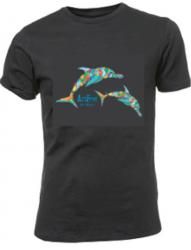 design logo for the event’s T-shirts), the Award of Merit at the 34th Annual Mainsail Arts Festival in St. Petersburg in 2009 and a feature in The Tampa Tribune. Today, he showcases his work in his Pinellas Park studio, select galleries, art festivals and at selected Tampa Bay charities.
design logo for the event’s T-shirts), the Award of Merit at the 34th Annual Mainsail Arts Festival in St. Petersburg in 2009 and a feature in The Tampa Tribune. Today, he showcases his work in his Pinellas Park studio, select galleries, art festivals and at selected Tampa Bay charities.
“My work blends modern abstract sensibilities with formal subjects.” His current work often contains ocean life, expressing Swartz’s abiding fascination with the sea and hobbies including scuba diving, spear fishing and boating. His sculptures often incorporate hearts, which symbolize his strong connection to his family and deep respect for life. “My modern abstracts illustrate a passion for vibrant color and form.”
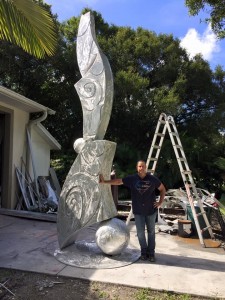 Interested in the physical act that goes into creating his work, Clayton describes his art as a performance or dance with the material – changing something raw into something beautiful.
Interested in the physical act that goes into creating his work, Clayton describes his art as a performance or dance with the material – changing something raw into something beautiful.
Swartz prefers brushed aluminum because the bright white metal shows off the layers of translucent color that he favors. “Stainless steel tends to mute the colors,” he explains. “Besides, it’s hard to transport and hang because it’s so heavy, and isn’t nearly as weather resistant as aluminum is.” Of course, aluminum is less forgiving. “Steel is more pliable and easier to weld. If you overheat aluminum, it just falls apart. But aluminum suits the bright, happy, saturated colors that I really, really like.”
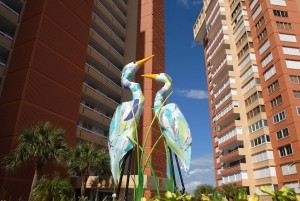 Swartz uses an array of techniques and processes to create his aluminum sculptures. “My metal working process employs MIG and TIG welding, plasma cutting, and grinding. When fabrication is complete, the color process begins. Using an array of brushes, airbrushes and paint moving tools, I coat my work with a saturated translucent automotive finish. These special techniques are used to
Swartz uses an array of techniques and processes to create his aluminum sculptures. “My metal working process employs MIG and TIG welding, plasma cutting, and grinding. When fabrication is complete, the color process begins. Using an array of brushes, airbrushes and paint moving tools, I coat my work with a saturated translucent automotive finish. These special techniques are used to 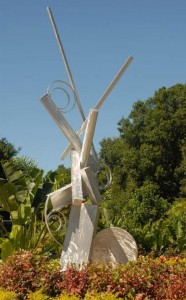 create vital effects in the work that treat each shape as its own abstract painting while simultaneously working in conjunction with the whole sculpture.”
create vital effects in the work that treat each shape as its own abstract painting while simultaneously working in conjunction with the whole sculpture.”
“Because I have a specific style, when somebody sees a sculpture that I create, if they know my work, they know I did it – even if they’re driving by it at 80 miles per hour,” states the artist. “While I am continually refining my process, I stick with a specific style and color pattern so that my work continues to remain recognizable by people who are familiar with my work.” Toward that end, he steadfastly refuses to sacrifice his individual style in order to make his public artworks site specific, “something that tends to make public art feel stilted and anonymous in way too many instances.”
_______________________________________________________________________
Glimpse inspring journey of magical realist Marcus Thomas at Bonita National (03-02-18)
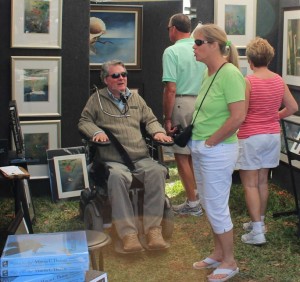 Marcus C. Thomas discovered the joy of painting after a snow skiing accident in 1986 left him paralyzed from the shoulders down. It would have been understandable if he had given in to self-pity. After all, at the time it happened he was an athletic, physically-active college grad with a new degree in commercial recreation who had just taken a job as activities director at a vacation resort.
Marcus C. Thomas discovered the joy of painting after a snow skiing accident in 1986 left him paralyzed from the shoulders down. It would have been understandable if he had given in to self-pity. After all, at the time it happened he was an athletic, physically-active college grad with a new degree in commercial recreation who had just taken a job as activities director at a vacation resort.
“That Christmas,” Marcus tells, “I received a set of Crayola watercolors.” 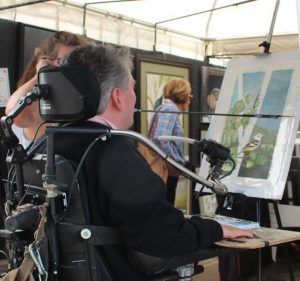 Although he had no background in art, he launched himself into a new adventure. He became not just a painter, but an artist whose works are so realistic, you’d swear you were looking at a photograph rather than an oil on canvas or panel.
Although he had no background in art, he launched himself into a new adventure. He became not just a painter, but an artist whose works are so realistic, you’d swear you were looking at a photograph rather than an oil on canvas or panel.
“I like realism and the edginess of surrealism,” Marcus notes, and toward that end, his paintings combine hyper-realistic technique with magical surrealism imagery.
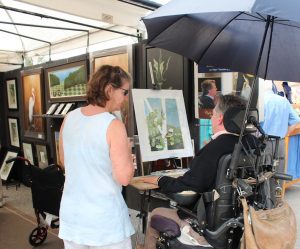 Dating as far back as van Eyck and Vermeer, artists have used various techniques including camera obscura in order to achieve a photographic quality in their finished work. But not Marcus Thomas. He paints free hand, except in his case, he uses a brush rigged to a mouthpiece that he clenches between his teeth. But as a result, he’s required to make adaptations in the process to which classically-trained artists religiously adhere.
Dating as far back as van Eyck and Vermeer, artists have used various techniques including camera obscura in order to achieve a photographic quality in their finished work. But not Marcus Thomas. He paints free hand, except in his case, he uses a brush rigged to a mouthpiece that he clenches between his teeth. But as a result, he’s required to make adaptations in the process to which classically-trained artists religiously adhere.
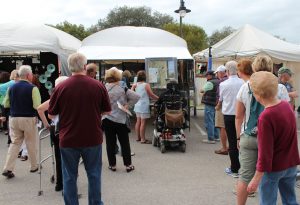 He cannot render a drawing of his motif or subject matter in pencil or charcoal. “I have to use a small, fine point brush instead.” And once he places the outline of his composition on canvas, he can’t hone the image with a Sharpie or magic marker. “I just start applying the paint,” he mentally shrugs.
He cannot render a drawing of his motif or subject matter in pencil or charcoal. “I have to use a small, fine point brush instead.” And once he places the outline of his composition on canvas, he can’t hone the image with a Sharpie or magic marker. “I just start applying the paint,” he mentally shrugs.
His results are spectacular. His paintings regularly stop festival-goers dead in their tracks. 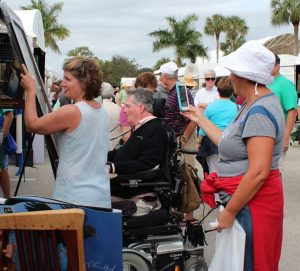 Only then do they notice Marcus parked in his wheelchair, meticulously daubbing paint on a canvas and stroking it into place.
Only then do they notice Marcus parked in his wheelchair, meticulously daubbing paint on a canvas and stroking it into place.
Not only are his works a true crowd pleaser, they have garnered him a number of Best of Shows. “I like art festivals,” says the artist. “They allow me to travel and be outdoors.”
Marcus is quick to give credit to the love of his life. “Without 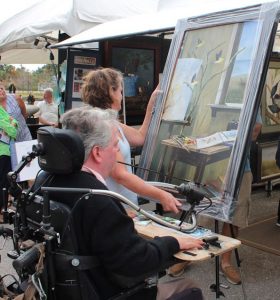 my wife, Anne, this wouldn’t be possible. In fact, a new pictorial biography titled Flight of the Mind: A Painter’s Journey through Paralysis gives a compelling glimpse into how Anne and Marcus have established daily rituals that sustain their creative journey. The book also treats readers to more than 200 color-plate photographs of Thomas’ work from his early watercolor wildlife renderings to his recent magical realism oil narratives, underscoring how the themes of flight, adventure and the natural world have remained constants in Marcus’ life since his childhood.
my wife, Anne, this wouldn’t be possible. In fact, a new pictorial biography titled Flight of the Mind: A Painter’s Journey through Paralysis gives a compelling glimpse into how Anne and Marcus have established daily rituals that sustain their creative journey. The book also treats readers to more than 200 color-plate photographs of Thomas’ work from his early watercolor wildlife renderings to his recent magical realism oil narratives, underscoring how the themes of flight, adventure and the natural world have remained constants in Marcus’ life since his childhood.
_____________________________________________________________________
Award of Distinction winner Antanas Ulevicius returning to Bonita National (03-02-18)
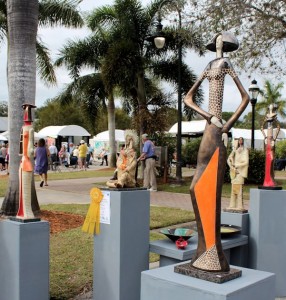 Antanas Ulevicius is a past Bonita National Award of Distinction winner. The sculptor creates hand-built stoneware and porcelain figures. Each colorful piece is embellished with copper slips and glazes that add to their distinctive quality and appearance. It’s a process that Ulevicius has been refining over the 15 years he has been exhibiting at art fairs and festivals across the country. You can see the St. Petersburg sculptor’s latest work this weekend at the Bonita Springs National Art Festival. It takes place from 10 a.m. to 5 p.m. this Saturday and Sunday in picturesque Riverside Park on Old 41 in historic Bonita Springs.
Antanas Ulevicius is a past Bonita National Award of Distinction winner. The sculptor creates hand-built stoneware and porcelain figures. Each colorful piece is embellished with copper slips and glazes that add to their distinctive quality and appearance. It’s a process that Ulevicius has been refining over the 15 years he has been exhibiting at art fairs and festivals across the country. You can see the St. Petersburg sculptor’s latest work this weekend at the Bonita Springs National Art Festival. It takes place from 10 a.m. to 5 p.m. this Saturday and Sunday in picturesque Riverside Park on Old 41 in historic Bonita Springs.
________________________________________________
A look at Bonita National exhibitor Abby Warman (03-02-18)
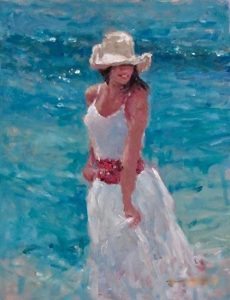 One of the artists taking part in this weekend’s Bonita National Art Festival is local painter Abby Warman.
One of the artists taking part in this weekend’s Bonita National Art Festival is local painter Abby Warman.
Warman is an impressionist painter whose subject matter includes still-life, figurative and landscape motifs. “My goal is to capture the spirit and vitality of my subject when painting,” Abby notes. “I strive to omit certain details in an effort to lend some mystery and interest to my work.”
She is a Signature Member of the American Women Artists Association, Women Painters of the Southeast, and the Knickerbocker Artists, and an Associate member of the American Impressionist Society and Oil 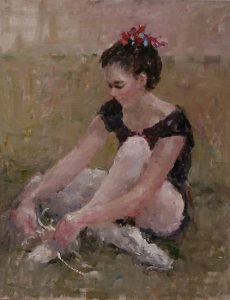 Painters of America.
Painters of America.
Abby received a Bachelor of Fine Arts degree from Skidmore College, and has studied painting with Charles Reid, Raymond Everett Kintsler, Charles Movalli, Laura Robb, C.W. Mundy, Kevin Macpherson, Joe Anna Arnett, Kim English and Carolyn Anderson. Her work is included in the permanent collection of the Everhart Museum in Scranton, Pennsylvania and exhibited in numerous national juried shows including the Salmagundi Club and the National Arts Club in New York City.
___________________________________________________
A look at Bonita National exhibitor Kimberly Willcox (03-02-18)
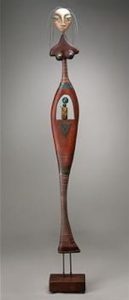 One of the artists taking part in this weekend’s Bonita National Art Festival is Gainesville, Florida sculptor Kimberly Willcox, who is a previous Award of Distinction recipient. Her sculptures consist of wood carving, bronze casting and forged steel with patina finishes.
One of the artists taking part in this weekend’s Bonita National Art Festival is Gainesville, Florida sculptor Kimberly Willcox, who is a previous Award of Distinction recipient. Her sculptures consist of wood carving, bronze casting and forged steel with patina finishes.
“All my life I have been fascinated by the human form,” reveals Willcox. “My aesthetic decisions are based on intuition and driven by my obsession to constantly make and create art. I love the creative process of problem solving.”
Throughout time, 3-dimensional objects have been part of the human experience. With sculpture, we visually experience the artist’s world by absorbing the entire artwork and interacting with its space. In that tradition, Willcox creates 3-dimensional objects from transformed materials to create that space.
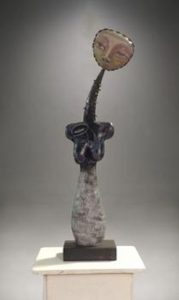 “My sculptures have grown into kinetically alive figures that tell their story of renewal,” Kimberly relates. “My ideas stem from the world around me, a blend of conscious and sub-conscious imagery. My work has never been constrained to a single medium. I work within a vast range of materials and techniques.”
“My sculptures have grown into kinetically alive figures that tell their story of renewal,” Kimberly relates. “My ideas stem from the world around me, a blend of conscious and sub-conscious imagery. My work has never been constrained to a single medium. I work within a vast range of materials and techniques.”
Willcox loves to discover the unexpected and to leave room for spontaneity. Toward that end, she has created multiple working stations within her studio to accommodate the vast range of techniques and materials she employs.
“The technique I use to create my work is a blend of old and new practices,” the artist amplifies.
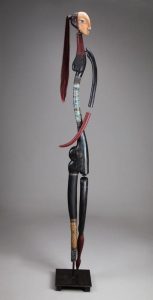 “I begin with transforming wood using hand carving tools. I sculpt the face out of clay, fire it, and then using various molding techniques, a resin model is created for bonded bronze casting. After the face is cast, it is treated with a patina before it is buffed. The steel parts are then hand forged and welded. The carved wood is finished with detailed painting. All of the elements are joined together with other found objects. My goal is to create a unique art form that shares a seamless integration between the world and the human spirit.”
“I begin with transforming wood using hand carving tools. I sculpt the face out of clay, fire it, and then using various molding techniques, a resin model is created for bonded bronze casting. After the face is cast, it is treated with a patina before it is buffed. The steel parts are then hand forged and welded. The carved wood is finished with detailed painting. All of the elements are joined together with other found objects. My goal is to create a unique art form that shares a seamless integration between the world and the human spirit.”
For Willcox, creativity reaches beyond technique. “Creativity is my life; my way of perceiving the world and touching others with inspiration and awakening.”
________________________________________________________________________________
Paul Willsea and Carol O’Brien bringing blown works and cast base bowls and vases to Bonita National (03-02-18)
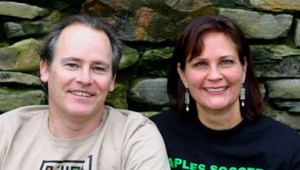 Paul Willsea and Carol O’Brien have worked together since 1983. They combine blown and cast glass to create timeless contemporary works of art. “Our work is a response to what we love in our world: the bloom of a flower, the movement of water,” Paul and Carol note. “There is an element of mystery in the creative process. Working with
Paul Willsea and Carol O’Brien have worked together since 1983. They combine blown and cast glass to create timeless contemporary works of art. “Our work is a response to what we love in our world: the bloom of a flower, the movement of water,” Paul and Carol note. “There is an element of mystery in the creative process. Working with 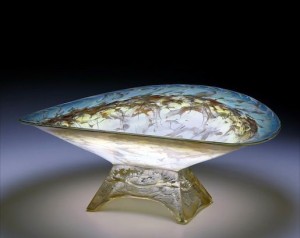 glass, we always anticipate a satisfying discovery that we can share with others.”
glass, we always anticipate a satisfying discovery that we can share with others.”
Their output consists of two distinct lines or work. The one is made up of blown works for wall or tabletop. Made in cohesive groups, they are studies in color and how color affects form.
The other consists of bowls and vases which combine a blown vessel with a cast base. The base 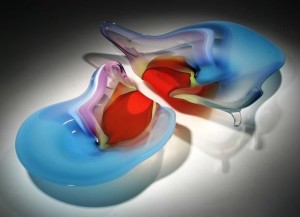 is cast in a mold to give the pieces a stable foundation while drawing references to architecture. The blown bowl is joined hot so that it appears to seamlessly emerge from the base and is a fluid and graceful counterpoint.
is cast in a mold to give the pieces a stable foundation while drawing references to architecture. The blown bowl is joined hot so that it appears to seamlessly emerge from the base and is a fluid and graceful counterpoint.
Both groups are elegant and refined, and make a stunning complement to a contemporary or traditional decor.
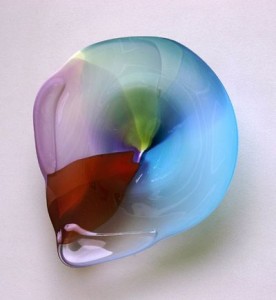 Willsea and O’Brien’s glass works have been shown and represented at galleries and juried exhibitions throughout the United States, including the California Crafts Museum in San Francisco, the store at the American Crafts Museum in New York City, and the store at the Corning Museum of Glass. Their work can be found in numerous private and corporate collections, including those of Corning, Inc., United Airlines, Kawasaki, Dean Witter Reynolds, Hyatt Regency Maui, Dick’s Sporting Goods, Nestle, Citibank San Francisco, Hartford Hospital Cancer Center, Coverys Insurance
Willsea and O’Brien’s glass works have been shown and represented at galleries and juried exhibitions throughout the United States, including the California Crafts Museum in San Francisco, the store at the American Crafts Museum in New York City, and the store at the Corning Museum of Glass. Their work can be found in numerous private and corporate collections, including those of Corning, Inc., United Airlines, Kawasaki, Dean Witter Reynolds, Hyatt Regency Maui, Dick’s Sporting Goods, Nestle, Citibank San Francisco, Hartford Hospital Cancer Center, Coverys Insurance 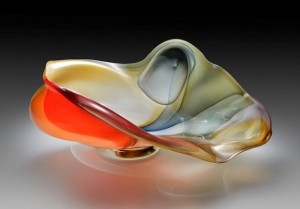 and the Saudi Royal Family. They live in the Finger Lakes Region of Western New York. Life partners, they have three children and enjoy a rural lifestyle while they work from their home studio on their wooded property.
and the Saudi Royal Family. They live in the Finger Lakes Region of Western New York. Life partners, they have three children and enjoy a rural lifestyle while they work from their home studio on their wooded property.
They will be on hand at the Bonita Springs National Art Festival on March 3 & 4. The show opens at 10 a.m. and closes at 5 p.m. both days.
____________________________________________________________________
Maine artist Anne Wooster brings botanical monotypes to Bonita National (03-02-18)
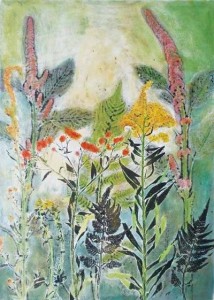 Maine artist Anne Wooster is a past Bonita Springs National Art Festival Award of Distinction recipient. She creates botanical monotypes made with oil based etching inks. On March 3 & 4, you can see her latest work at the Bonita Springs National Art Festival in Riverside Park in historic Bonita Springs.
Maine artist Anne Wooster is a past Bonita Springs National Art Festival Award of Distinction recipient. She creates botanical monotypes made with oil based etching inks. On March 3 & 4, you can see her latest work at the Bonita Springs National Art Festival in Riverside Park in historic Bonita Springs.
Anne Wooster has been an artist and nature lover since she painted her entire body at the age of two. A Waldoboro native, she took art lessons from established artists and attended Medomak Valley High School before matriculating at the Maryland Institute College of Art in Baltimore. While an art instructor at Warren Community School between 2000 and 2006, Anne 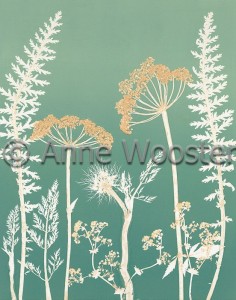 attended Hay Stack School of Arts every fall with other Maine art teachers. That’s where she fell in love with printing the flora of Maine.
attended Hay Stack School of Arts every fall with other Maine art teachers. That’s where she fell in love with printing the flora of Maine.
“Monotypes are reminiscent of photography and yet feel like painting,” says Anne. “Each print uses live plant material and no two prints are ever the same.”
Today, Anne devotes herself to art full-time, gathering the subjects and material for her prints from her gardens, her friends’ gardens, and the local fields, forest and seashore. “Art is a necessary expression of the beauty in my life.”
Four years ago, Anne met her partner Steven Peaslee. They decided soon after to take their artwork on the road across the country full time. Steve was very inspired by the process and has been printing since 2012, developing his own technique along the way.
_________________________________________________________________
Virginia fine art jeweler Tricia Young participating in Bonita National (03-02-18)
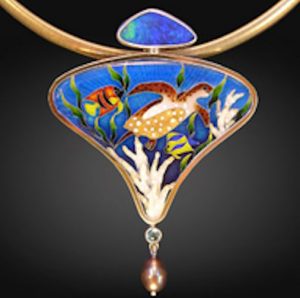 One of the artists taking part in this weekend’s Bonita National Art Festival is Viginia-based fine art jeweler Tricia Young. She creates hand-fabricated Cloisonne Enamel Jewelry set in 18 k gold and/or sterling silver. “I hand fabricate all my creations utilizing enamel, Cloisonne, plique-a-jour, and three dimensional anticlastic enameling. The settings of 18 k gold, sterling silver, or a combination of the two, are often hand engraved, etched, and/or embossed with chasing and repousse.”
One of the artists taking part in this weekend’s Bonita National Art Festival is Viginia-based fine art jeweler Tricia Young. She creates hand-fabricated Cloisonne Enamel Jewelry set in 18 k gold and/or sterling silver. “I hand fabricate all my creations utilizing enamel, Cloisonne, plique-a-jour, and three dimensional anticlastic enameling. The settings of 18 k gold, sterling silver, or a combination of the two, are often hand engraved, etched, and/or embossed with chasing and repousse.”
See her this weekend in Booth 120.
_________________________________________________________________________
Internationally-recognized sculptor John Zidek participating in Bonita National (03-02-18)
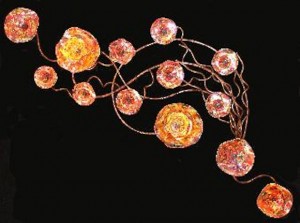 One of the local artists participating in the Bonita Springs National Art Festival this weekend is John Zidek. John is an internationally-acclaimed sculptor who has worked over the years in numerous mediums, including bronze, wood, resin, ultra-violet minerals, and a line of gold and sterling silver jewelry.
One of the local artists participating in the Bonita Springs National Art Festival this weekend is John Zidek. John is an internationally-acclaimed sculptor who has worked over the years in numerous mediums, including bronze, wood, resin, ultra-violet minerals, and a line of gold and sterling silver jewelry.
John’s wall sculptures combine fabricated 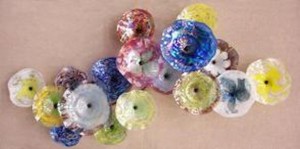 copper and hand-blown glass. “Blown glass is a process. It starts as clear crystal and frits are rolled into it for color and pattern. The frits come from two companies in Germany, which Chihuly claims are the best in the world,” says Zidek. “While the glass is still hot, it is fumed with
copper and hand-blown glass. “Blown glass is a process. It starts as clear crystal and frits are rolled into it for color and pattern. The frits come from two companies in Germany, which Chihuly claims are the best in the world,” says Zidek. “While the glass is still hot, it is fumed with 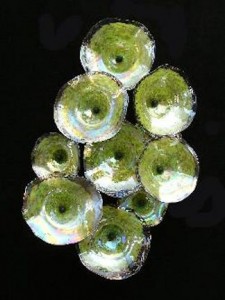 titanium, a Tiffany technique with a space age metal. It was chosen for its overall reflection and iridescence. The quality of the glass blowing is determined by not only the thickness but also its overall uniformity. In other words, it is thin and uniform from its center to the edge.”
titanium, a Tiffany technique with a space age metal. It was chosen for its overall reflection and iridescence. The quality of the glass blowing is determined by not only the thickness but also its overall uniformity. In other words, it is thin and uniform from its center to the edge.”
Zidek enlisted his friend and fellow artist Ron Hinkle, owner of Dying Art Glass Works in West Virginia, to develop and refine his process. “I had the design and Ron had the expertise to help me put it together.”
“My copper designs are generally in my mind,” Zikek explains. 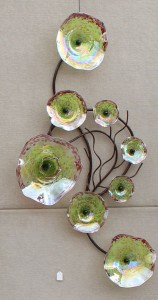 “Occasionally I may make a basic sketch to retain an idea, but that is rare. I selected copper as my metal for several reasons. It is flexible enough to be worked by hand and then through heat treating it can be made rigid.”
“Occasionally I may make a basic sketch to retain an idea, but that is rare. I selected copper as my metal for several reasons. It is flexible enough to be worked by hand and then through heat treating it can be made rigid.”
Another reason that Zidek gravitates toward copper is its permanence. “Copper is found in sheet form in Michigan. It is layered between rocks and has been there for millions of years in its natural state. Copper was chosen for the Statue of Liberty for its resistance to salt air. The only issue with the Statue to date has been the ironwork that has rotted away in the arm. Depending on formulas, bronze is 94-97% copper; the inclusions are to give it hardness.”
Zidek brazes all of his pieces at approximately 1800 degrees with 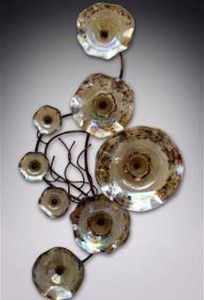 oxygen/acetylene. “The copper is at its melting point when I apply a copper rod to make the connection,” Zidek continues. “Even though I schooled in jewelry and am familiar with soldering, the process to connect copper is much more intense. I like to build up the shoulders of my joints. Consequently, the application of heat is very delicate. Too much and the entire joint dissolves and falls off. Of course, too little heat and nothing happens.”
oxygen/acetylene. “The copper is at its melting point when I apply a copper rod to make the connection,” Zidek continues. “Even though I schooled in jewelry and am familiar with soldering, the process to connect copper is much more intense. I like to build up the shoulders of my joints. Consequently, the application of heat is very delicate. Too much and the entire joint dissolves and falls off. Of course, too little heat and nothing happens.”
Zidek’s pieces have no soft solder, plumbers solder, epoxies, glues or other materials that will fail over time. The work basically becomes one piece and is permanent. His pieces are made from hollow tubing, which makes them very lightweight and easy to install. He uses a 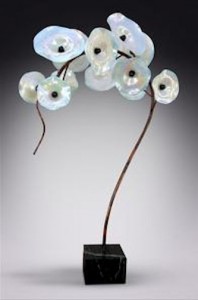 museum brown bronze chemical patina for color. The metal is then clear coated with enamel and heat treated. A large piece may weigh as little as twenty pounds.
museum brown bronze chemical patina for color. The metal is then clear coated with enamel and heat treated. A large piece may weigh as little as twenty pounds.
Zidek is also experimenting with floor, pedestal, lighting, water features and wind sculptures.
A Professional Level Member of the International Sculpture Center, Zidek periodically exhibits in International Art Expo New York. John was born and raised in Franklin, New Jersey. His father, John Zidek Sr., was first generation American, his family having come from Czechoslovakia. His mother, Edna, is a Daughter of the American Revolution.
__________________________________________________________________
Clay artist Debra Steidel adjudged Bonita Springs National Best of Show (02-12-18)
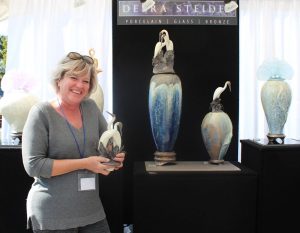 The second of three Bonita Springs National Art Festivals wrapped up on Sunday, February 11 with the announcement of winners in various categories. Clay artist Debra Steidel was chosen as the overall Best of Show for her exquisite crystalline glazed porcelain vessels. On top of that, each vessel also features a specially-designed lid which she initially sculpts in porcelain but replaces with bronze and glass toppers cast in two different foundries.
The second of three Bonita Springs National Art Festivals wrapped up on Sunday, February 11 with the announcement of winners in various categories. Clay artist Debra Steidel was chosen as the overall Best of Show for her exquisite crystalline glazed porcelain vessels. On top of that, each vessel also features a specially-designed lid which she initially sculpts in porcelain but replaces with bronze and glass toppers cast in two different foundries. 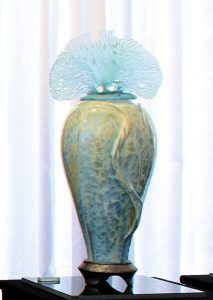 Debra Steidel’s work can be found in corporate and private collections throughout the United States and the United Kingdom. She has won numerous prestigious awards for her artwork, which continues to grow and evolve. Regardless of where Debra applies her expertise, you can be sure it will exemplify the qualities of balance, novelty and wonder.
Debra Steidel’s work can be found in corporate and private collections throughout the United States and the United Kingdom. She has won numerous prestigious awards for her artwork, which continues to grow and evolve. Regardless of where Debra applies her expertise, you can be sure it will exemplify the qualities of balance, novelty and wonder.
For more about Debra, please scroll down for an article devoted entirely to her work and process.
____________________________________________________________________
Seascape photographer David Sieczkiewicz is Best of 2D at Bonita National (02-11-18)
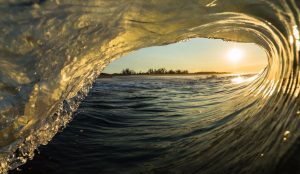 The second of three Bonita Springs National Art Festivals wrapped up on Sunday, February 11 with the announcement of winners in various categories. Naples pastel artist Cheri Dunnigan judged the two-dimensional work exhibited by the artists participating in the show and she selected seascape photographer David Sieczkiewicz as Best of 2D.
The second of three Bonita Springs National Art Festivals wrapped up on Sunday, February 11 with the announcement of winners in various categories. Naples pastel artist Cheri Dunnigan judged the two-dimensional work exhibited by the artists participating in the show and she selected seascape photographer David Sieczkiewicz as Best of 2D.
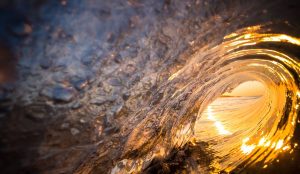 Whether it’s a calm or turbulent body of water, a picturesque landscape, or a form of life, respectable elements of beauty are the overarching theme and unifying aspect of the images that flow from Sieczkiewicz’s lens. “These natural elements can also serve as a happy place, an area where we can go and be alone or sometimes share with a companion,”
Whether it’s a calm or turbulent body of water, a picturesque landscape, or a form of life, respectable elements of beauty are the overarching theme and unifying aspect of the images that flow from Sieczkiewicz’s lens. “These natural elements can also serve as a happy place, an area where we can go and be alone or sometimes share with a companion,” 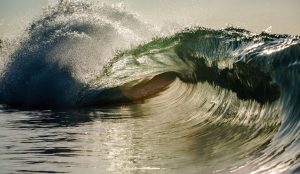 David expounds. “This retreat is where we can embark on what brings us happiness, where we allow ourselves to forget the problems in our universe. Nature, and the ocean specifically, creates that atmosphere for me.” And it’s something Sieczkiewicz wants to recreate for his collectors and other folks who encounter his photographs.
David expounds. “This retreat is where we can embark on what brings us happiness, where we allow ourselves to forget the problems in our universe. Nature, and the ocean specifically, creates that atmosphere for me.” And it’s something Sieczkiewicz wants to recreate for his collectors and other folks who encounter his photographs.
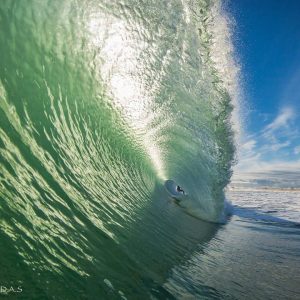 David finds catching a wave especially intriguing. “The challenge of trying to anticipate what the ocean will do next, the challenge of trying to balance composition and light with something that can be next to unpredictable, the challenge of having the dedication and drive needed to either awake at odd hours or to endure bitter cold New England winter water temperatures, the challenge to overcome defeat when things can and do go wrong, to endure the blood, sweat and sometimes tears – it all creates a love and a passion!”
David finds catching a wave especially intriguing. “The challenge of trying to anticipate what the ocean will do next, the challenge of trying to balance composition and light with something that can be next to unpredictable, the challenge of having the dedication and drive needed to either awake at odd hours or to endure bitter cold New England winter water temperatures, the challenge to overcome defeat when things can and do go wrong, to endure the blood, sweat and sometimes tears – it all creates a love and a passion!”
Sieczkiewicz 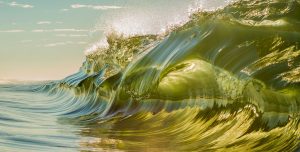 last exhibited in Southwest Florida at ArtFest Fort Myers, but Bonita Springs National is his last show in this area this season. However, you can catch him on the east coast the next four consecutive weekends. For more information, please visit http://www.dasphotogallery.com/AwardsRecognition/.
last exhibited in Southwest Florida at ArtFest Fort Myers, but Bonita Springs National is his last show in this area this season. However, you can catch him on the east coast the next four consecutive weekends. For more information, please visit http://www.dasphotogallery.com/AwardsRecognition/.
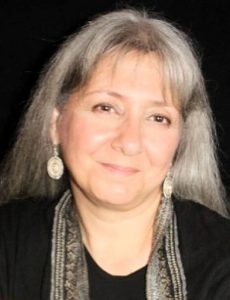 Juror Cheri Dunnigan can appreciate Sieczkiewicz’s work ethic. She was born and raised outside of Boston and familiar with the ardors of being outdoors in New England during their bitter cold winters.
Juror Cheri Dunnigan can appreciate Sieczkiewicz’s work ethic. She was born and raised outside of Boston and familiar with the ardors of being outdoors in New England during their bitter cold winters.
Cheri began to develop her artistic talents at an early age, eventually earning a Bachelor of Fine Arts Degree from the Cleveland Institute of Art in 1978. Having majored in silversmithing and jewelry design, she worked for many years as a designer craftsman, maintaining a retail studio in Hopkinton, Massachusetts. In recent years, though, Cheri has turned her talents toward pastel painting. She has exhibited her work nationally 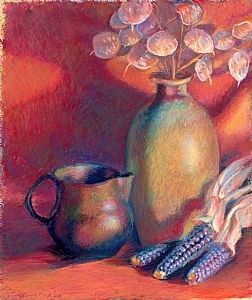 and has won numerous awards.
and has won numerous awards.
Cheri is a charter member of the Pastel Society of Southwest Florida, and a Signature Member of the Pastel Society of America. She presently teaches ongoing classes in pastel painting at the Center for the Arts Bonita Springs and at the Naples Art Association in Naples. To learn more about Cheri Dunnigan and her work, please visit http://cheridunnigan.com/.
______________________________________________________
Jeweler Seth Carlson is Best of 3D at Bonita National show (02-11-18)
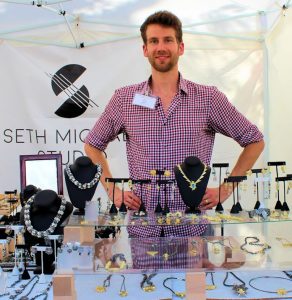 The second of three Bonita Springs National Art Festivals wrapped up on Sunday, February 11 with the announcement of winners in various categories. Seth Michael Carlson won Best of 3D honors.
The second of three Bonita Springs National Art Festivals wrapped up on Sunday, February 11 with the announcement of winners in various categories. Seth Michael Carlson won Best of 3D honors.
Carlson traces the beginning of his career in fine art jewelry to his father’s stained glass studio, where he fashioned jewelry from scraps of discarded glass which he wrapped in wire.
“ I decided at an early age that I wanted to be a jeweler,” he confides. “The thought of making objects of adornment for the human body was alluring.”
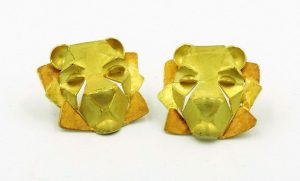 Seth attended the Savannah College of Art and Design and earned a BFA in metals and jewelry in 2007. While at SCAD, he developed a passion for forming and silversmithing. “The meditative process of vessel making has been the cornerstone of my current philosophy of jewelry and object making,” he expounds. “Having spent a lifetime devoted to learning
Seth attended the Savannah College of Art and Design and earned a BFA in metals and jewelry in 2007. While at SCAD, he developed a passion for forming and silversmithing. “The meditative process of vessel making has been the cornerstone of my current philosophy of jewelry and object making,” he expounds. “Having spent a lifetime devoted to learning 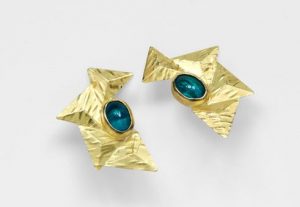 the craft of metalsmithing, I believe there is always something to learn and contribute to the craft, as is the voice through which I speak. The performance of making gives way to the metal itself performing your inner expression.”
the craft of metalsmithing, I believe there is always something to learn and contribute to the craft, as is the voice through which I speak. The performance of making gives way to the metal itself performing your inner expression.”
Carlson credits the artist in residency program at the Rochester Institute of Technology with providing him the 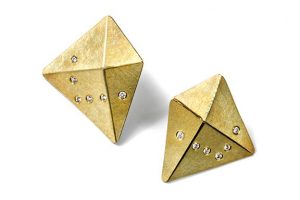 opportunity to think critically about his art practice. “After working as a goldsmith for other jewelers, I decided to pursue a graduate program in art therapy,” he continues. “I have always found the experiences of creating to be beneficial and empowering. I wanted to help others have those experiences as well.”
opportunity to think critically about his art practice. “After working as a goldsmith for other jewelers, I decided to pursue a graduate program in art therapy,” he continues. “I have always found the experiences of creating to be beneficial and empowering. I wanted to help others have those experiences as well.”
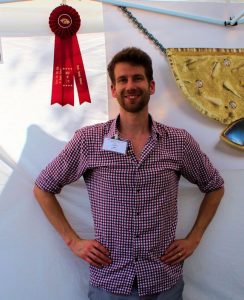 While a graduate student at the School of the Art Institute of Chicago, Seth started a metalsmithing group on Chicago’s south side for teenagers. “I have always believed that being a craftsperson and being altruistic are synonymous. Giving back to a community is an essential part of mastering a craft, a process that will take me a lifetime and beyond.”
While a graduate student at the School of the Art Institute of Chicago, Seth started a metalsmithing group on Chicago’s south side for teenagers. “I have always believed that being a craftsperson and being altruistic are synonymous. Giving back to a community is an essential part of mastering a craft, a process that will take me a lifetime and beyond.”
Want to know more about Seth and the jewelry he makes? Please visit https://www.sethmichaelstudio.com/.
Tim Smith judged the 3D works in this show.
_________________________________________________________
Bonita National names 12 recipients of Awards of Distinction (02-11-18)
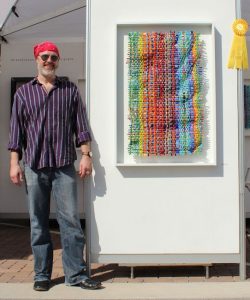 The second of three Bonita Springs National Art Festivals wrapped up on Sunday, February 11 with the announcement of winners in various categories. Twelve artists received Awards of Distinction, namely:
The second of three Bonita Springs National Art Festivals wrapped up on Sunday, February 11 with the announcement of winners in various categories. Twelve artists received Awards of Distinction, namely:
- Steven Potts, wood;
- Andrew Wender, clay,
- Patrick Whalen, photography,
- Abby Warman, oil/acrylics;
- Kue King, metal;
- Marie Rust, pastels;
- Dahlia Popovits, fiber;
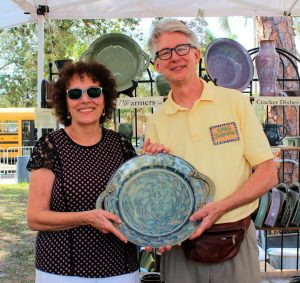 William Cantwell, oil/acrylics;
William Cantwell, oil/acrylics;- Mark Lewanski, glass (top photo);
- Kevin Liang, oil/acrylics;
- Thomas Sanders, photography; and
- Johnson & Gilbert, clay (right).
___________________________________________________
Bonita National Art Festival returns February 10 & 11 (02-07-18)
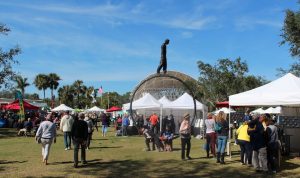 The Bonita Springs National Art Festival returns to Riverside Park on Old 41 in historic downtown Bonita Springs on Saturday and Sunday, February 10 & 11 for the second of its three fine art festivals. This festival stresses quality and originality, with the 211 artists juried into the show from across the United States, Canada, South America
The Bonita Springs National Art Festival returns to Riverside Park on Old 41 in historic downtown Bonita Springs on Saturday and Sunday, February 10 & 11 for the second of its three fine art festivals. This festival stresses quality and originality, with the 211 artists juried into the show from across the United States, Canada, South America 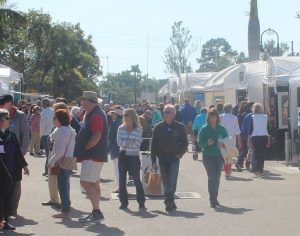 and even Europe exhibiting and selling original paintings, drawings, pastels, photography, handcrafted jewelry, clay works and ceramics, glass art, metal sculpture and more. Riverside Park is located at 10450 Reynold Street or 27000 Old 41 Road in central Bonita Springs, Florida 34135.
and even Europe exhibiting and selling original paintings, drawings, pastels, photography, handcrafted jewelry, clay works and ceramics, glass art, metal sculpture and more. Riverside Park is located at 10450 Reynold Street or 27000 Old 41 Road in central Bonita Springs, Florida 34135.
____________________________________________________________________
Collectors and connoisseurs clamoring for Dan Barnes’ glass art sculpture (02-07-18)
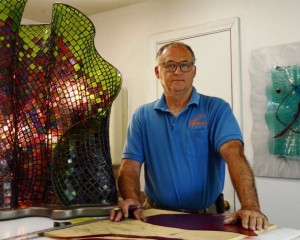 Riverside Park in old Bonita Springs hosts the Bonita Springs National Art Festival three times each year. The second edition of the show takes place this weekend, February 10 & 11. This high-quality two-day outdoor art juried fine art and fine craft show attracts some of the country’s finest artists. Among them will be glass artist Dan Neil Barnes, a mixed media sculptor with a growing reputation for thoughtfully-designed and intricately-wrought w
Riverside Park in old Bonita Springs hosts the Bonita Springs National Art Festival three times each year. The second edition of the show takes place this weekend, February 10 & 11. This high-quality two-day outdoor art juried fine art and fine craft show attracts some of the country’s finest artists. Among them will be glass artist Dan Neil Barnes, a mixed media sculptor with a growing reputation for thoughtfully-designed and intricately-wrought w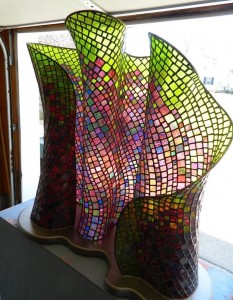 orks that combine vibrantly colored stained and fused glass with soldered bronze, copper, aluminum and other metallic accents.
orks that combine vibrantly colored stained and fused glass with soldered bronze, copper, aluminum and other metallic accents.
Barnes’ work moves the millennial-old craft of stained glass into a new creative art form – one that pushes the idea of glass in art to a whole new level. The hundreds of small stained and fused glass squares he incorporates into his three-dimensional structures imbue them with a kinetic quality. They undulate, flow and change direction and intensity as they respond to light and the movement of the viewer, almost as if they were alive and sentient.
D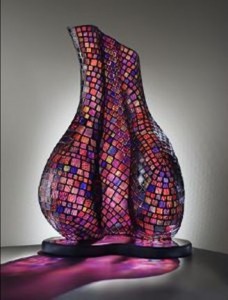 an continually pushes the limits of what an artist can accomplish with glass. Like many others in the field, innovation often comes as the result of trial, error and happy circumstance. That’s especially true of the leopard pattern that typifies much of his newer fused glass works.
an continually pushes the limits of what an artist can accomplish with glass. Like many others in the field, innovation often comes as the result of trial, error and happy circumstance. That’s especially true of the leopard pattern that typifies much of his newer fused glass works.
“I discovered that tack fusing leaves glass more tactile, so that you can build layer upon layer,” Dan explains. “Trapping air pockets between layers creates a pattern reminiscent of a leopard’s spots. I like that visual texture. It’s richer and deeper and has considerably more character than what you can get with full fusing.”
W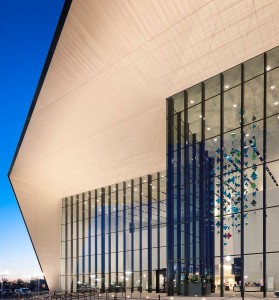 hile Dan is gratified that glass art connoisseurs and collectors are clamoring for his innovative wall hangings and freestanding pieces, he is equally proud of the growing demand for his monumental work in the realm of public art.
hile Dan is gratified that glass art connoisseurs and collectors are clamoring for his innovative wall hangings and freestanding pieces, he is equally proud of the growing demand for his monumental work in the realm of public art.
One such site-specific work is Cascade, which stands 45 feet high by 22 feet wide and 9 feet deep. Commissioned in 2013, the installation consists of 157 separate pieces of fused glass that are suspended by stainless steel cables from the ceiling in the front entrance to the new convention center in Owensboro, Kentucky. 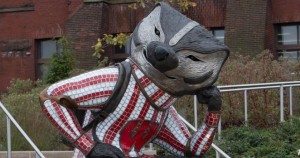 Contrasting with the building’s angular design, Cascade’s gentle curves bring both movement and color into the space, conjuring the flow of the Ohio River that runs behind the building.
Contrasting with the building’s angular design, Cascade’s gentle curves bring both movement and color into the space, conjuring the flow of the Ohio River that runs behind the building.
Last year, Barnes completed a collaborative commission f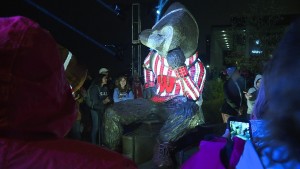 or the University of Wisconsin in Madison with renowned sculptor Douwe Blumberg. Together, they created an eight-foot-tall, 2,500-pound bronze and glass sculpture of the university’s beloved mascot, Bucky Badger. The work is innovative in a number of respects. First, the glass is lighted from within, which gives the Alumni Park centerpiece titled
or the University of Wisconsin in Madison with renowned sculptor Douwe Blumberg. Together, they created an eight-foot-tall, 2,500-pound bronze and glass sculpture of the university’s beloved mascot, Bucky Badger. The work is innovative in a number of respects. First, the glass is lighted from within, which gives the Alumni Park centerpiece titled 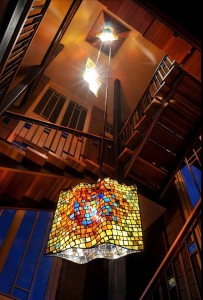 Well Red a startling appearance after dark. And thanks to a construction approach Barnes developed that enable him to weave the structural support for the glass directly into its grid, Well Red combines Barnes’ three-dimensional stained and fused glass with Blumberg’s bronze in a way that allows the material to flow seamlessly from one to the other.
Well Red a startling appearance after dark. And thanks to a construction approach Barnes developed that enable him to weave the structural support for the glass directly into its grid, Well Red combines Barnes’ three-dimensional stained and fused glass with Blumberg’s bronze in a way that allows the material to flow seamlessly from one to the other.
Public art commissions such as these not only enhance the notoriety and value of Barnes’ smaller artworks, they afford him the opportunity to discover new ways to involve his viewers with the pieces he creates.
Barnes only began working with glass several years ago. Before then, Dan o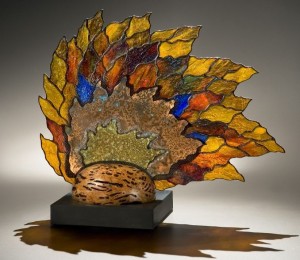 wned and operated a highly-successful upholstery and furniture design business with a reputation for design flair and top-quality craftsmanship. But that business just didn’t afford him with the creative opportunities and challenges he enjoys today. So to acclimate himself to the new medium, he sought out and studied with Laura Hallock in Lexington, Kentucky. He’s been a proven innovator ever since.
wned and operated a highly-successful upholstery and furniture design business with a reputation for design flair and top-quality craftsmanship. But that business just didn’t afford him with the creative opportunities and challenges he enjoys today. So to acclimate himself to the new medium, he sought out and studied with Laura Hallock in Lexington, Kentucky. He’s been a proven innovator ever since.
“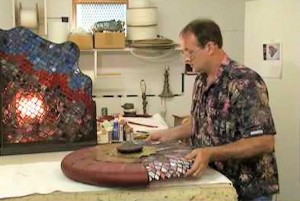 Besides, I really enjoy going to art shows around the country and meeting hundreds of people who love glass and sculpture and art, just like me.”
Besides, I really enjoy going to art shows around the country and meeting hundreds of people who love glass and sculpture and art, just like me.”
You can meet Dan Neil Barnes and view his art at the Bonita Springs National Art Festival on February 10 & 11. For more information, please visit http://www.hotworks.org or email patty@hotworks.org.
__________________________________________________________
Paula Green deco and Asian batiks display uncommon ability (02-07-18)
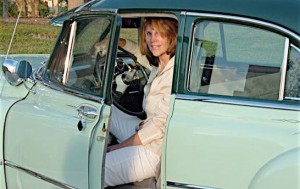 Riverside Park in old Bonita Springs will be the scene of a high-quality art show again this weekend. Perennially in the top 100 art fairs and festivals in the nation, the Bonita Springs National Art Festival features some of the best art and artists to come to Southwest Florida during festival season. Batik artist Paula Mae Green is included in this esteemed group.
Riverside Park in old Bonita Springs will be the scene of a high-quality art show again this weekend. Perennially in the top 100 art fairs and festivals in the nation, the Bonita Springs National Art Festival features some of the best art and artists to come to Southwest Florida during festival season. Batik artist Paula Mae Green is included in this esteemed group.
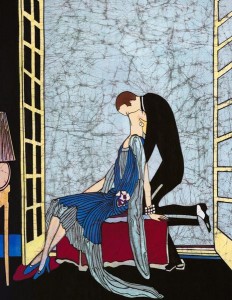 If you’re not familiar with batik (also known as rozome), it is a wax-and-dye resist process that traces its origins back to 13th century Java. Not many artists engage in the process because it is so exacting and time-consuming. But that’s part of its charm for Green, whose Swedish lineage includes several generations of crafts people who believed that “if you are going to do something, try to take it to its highest form.”
If you’re not familiar with batik (also known as rozome), it is a wax-and-dye resist process that traces its origins back to 13th century Java. Not many artists engage in the process because it is so exacting and time-consuming. But that’s part of its charm for Green, whose Swedish lineage includes several generations of crafts people who believed that “if you are going to do something, try to take it to its highest form.”
Green posits four steps in her process, vis:
- Starting with the lightest color she plans to use in her composition – the fabric is dipped into a pan of fabric dye.
- The fabric is dried.
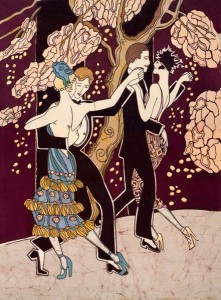 The area to remain that color is waxed over.
The area to remain that color is waxed over.- The process is then repeated with each color until the batik is completed.
While this may be true, Paula has omitted a couple of crucial, preliminary steps. First, it is incumbent upon her to choose her motif. Green’s repertoire includes Deco, Asian and Cubist compositions. The images from her Deco and Asian series in particular are sinuous, elegant and dynamic in the finest tradition of Art Nouveau masters such as Klimt, Cheret and even the ineffable Henri de Toulouse-Lautrec. But the parallels to the femme nouvelle subjects celebrated by Czech artist Alphonse Mucha in 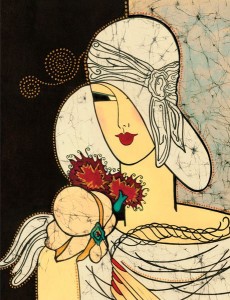 his widely-popular densely-patterned posters of the early 20th century are unmistakeable. Green’s batik renderings of Deco Dancers, At the Theater, Kiss and Evening are not just chic and sophisticated. They evoke a feel of bygone times and flappers and the Roaring ‘20s.
his widely-popular densely-patterned posters of the early 20th century are unmistakeable. Green’s batik renderings of Deco Dancers, At the Theater, Kiss and Evening are not just chic and sophisticated. They evoke a feel of bygone times and flappers and the Roaring ‘20s.
Paula uses small brushes in order to achieve impossibly fine detail in her meticulously handcrafted portraits, figurative scenes and floral designs. This level of rendition is almost unheard of in batik. Frankly, it is unattainable by artists possessing lesser talent, regardless of medium.
Once 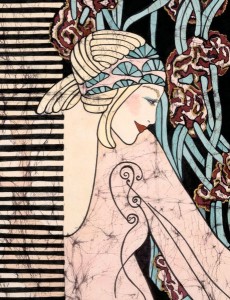 the composition has been transferred to fabric, Green is ready to begin the batik process, which starts with dipping the entire fabric into a pan of dye (see step 1, above).The color which is to be preserved is then waxed over and the process is repeated in successive layers as other colors are added to the drawing until the final composition emerges. After the last dye is applied, the cumulative layers of wax are stripped off revealing the finished work.
the composition has been transferred to fabric, Green is ready to begin the batik process, which starts with dipping the entire fabric into a pan of dye (see step 1, above).The color which is to be preserved is then waxed over and the process is repeated in successive layers as other colors are added to the drawing until the final composition emerges. After the last dye is applied, the cumulative layers of wax are stripped off revealing the finished work.
While it is clear from this simplified description, batik or rozome takes inordinate amounts of time and presupposes the patience of a saint, less apparent is the skill required during the waxing stage lest the detail 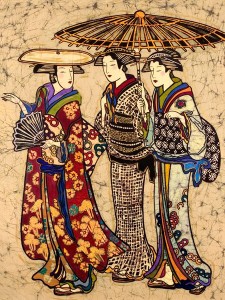 incorporated into the underlying painting be blurred, smudged or compromised.
incorporated into the underlying painting be blurred, smudged or compromised.
The spontaneous fire lines running throughout the fabric has been given the name of “crackle effect.” It is characteristic of the batik process and the difficulties associated with mastering the technique.
Paula has won numerous awards, and her work can be found in many private and corporate collections throughout the world. As a person’s surroundings are a mirror of themselves, she feels that the most important thing a person needs to know about art is how it makes them feel.
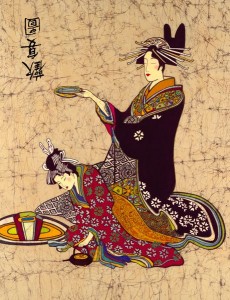 “If a person is doing something they truly love, it reflects in their life and work,” she comments.
“If a person is doing something they truly love, it reflects in their life and work,” she comments.
Now a resident of Pompano Beach, Florida, her return to the Sunshine State was rather circuitous. After graduating from FSU and doing advanced studies at the University of Miami, Paula worked as a high school art teacher in the Dade County school system for several years before leaving for New York City and additional studies at Parson’s School of Design. From there, she did a five-year stint as a gallery owner in historic South Norwalk, Connecticut, where she specialized in vintage lighting portraying antiquity and old world charm.
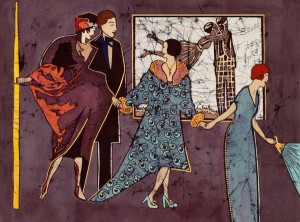 Preferring a simpler lifestyle, she relocated Woodstock, New York, where she enjoyed a home on a mountain side in the Catskills. While living a life of enchantment and creativity, Paula became involved in developing and producing a series of fine art limited edition giclees of her batik work, which provides art lovers with a more affordable option for collecting her batiks.
Preferring a simpler lifestyle, she relocated Woodstock, New York, where she enjoyed a home on a mountain side in the Catskills. While living a life of enchantment and creativity, Paula became involved in developing and producing a series of fine art limited edition giclees of her batik work, which provides art lovers with a more affordable option for collecting her batiks.
Today, 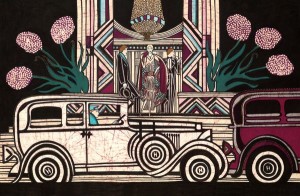 Paula’s summers are filled with art shows in Michigan and Chicago, New York and other metropolitan areas. She also works closely with designers and architects and accepts challenging commissions.
Paula’s summers are filled with art shows in Michigan and Chicago, New York and other metropolitan areas. She also works closely with designers and architects and accepts challenging commissions.
You can meet Paula and sample her work on Saturday and Sunday, February 10 & 11. The show is open from 10:00 a.m. to 5:00 p.m. both days. _______________________________________________________________
Best of Show wood sculptor Steven Potts returns to Bonita National (02-07-18)
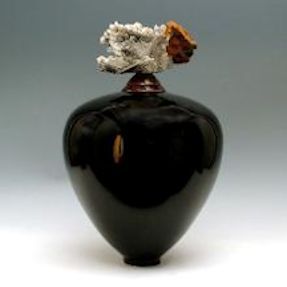 Wood sculptor Steven Potts was chosen as Best of Show at the Bonita Springs National Art Festival that took place in January of 2016. He is returning with his award-winning vessels for this weekend’s Bonita Springs National Art Festival.
Wood sculptor Steven Potts was chosen as Best of Show at the Bonita Springs National Art Festival that took place in January of 2016. He is returning with his award-winning vessels for this weekend’s Bonita Springs National Art Festival.
Potts creates lathe turned wood vessels with hand tooled designs, inlays, tints and organic elements (images 1 & 2). “I use unusual, rare domestic and exotic woods to make my unique vessels,” says Potts. “I incorporate classical shapes, inlays, sculptural 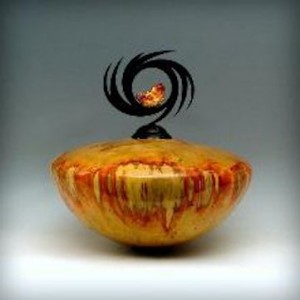 designs, and the natural inclusions and formations of the wood into my sculpted pieces.”
designs, and the natural inclusions and formations of the wood into my sculpted pieces.”
Potts also likes to use a variety of natural ornamentation with his artwork. Exotic wood finials, fossils, minerals, gems, and unusual organic elements that were collected from all over the world are used to crown many of his pieces and are also employed as an avenue for expression.
“These two seemingly different influences explore the concept of wood given to movement and new 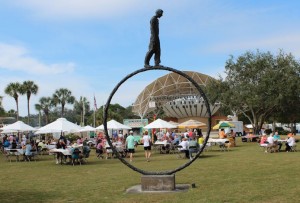 art form,” Potts explains. “They also make each piece very expressive, unpredictable, special and individualized. The glasslike finishes on my pieces are made by using a special lacquer mixture. This finish will not crack, but move as the wood moves, insuring that the sculpture will last a lifetime.”
art form,” Potts explains. “They also make each piece very expressive, unpredictable, special and individualized. The glasslike finishes on my pieces are made by using a special lacquer mixture. This finish will not crack, but move as the wood moves, insuring that the sculpture will last a lifetime.”
The Bonita Springs National Art Festival returns to Riverside Park in March. But if you want to see Potts and his work, don’t delay. Come this weekend.
________________________________________________________________
Bonita National will be homecoming for ‘Rusty’ sculptor Dale Rogers (02-07-18)
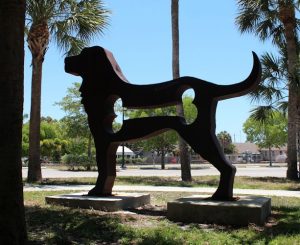 Bonita Springs National Art Festival returns to Riverside Park this weekend. It will be a homecoming of sorts for sculptor Dale Rogers. You see, his American Dog stands guard across the railroad tracks in Depot Park. Locals know the 8-foot-tall canine by the nickname they gave him. He’s called Rusty because of the rust-colored patina of the Cor-Ten sculpture.
Bonita Springs National Art Festival returns to Riverside Park this weekend. It will be a homecoming of sorts for sculptor Dale Rogers. You see, his American Dog stands guard across the railroad tracks in Depot Park. Locals know the 8-foot-tall canine by the nickname they gave him. He’s called Rusty because of the rust-colored patina of the Cor-Ten sculpture.
Rogers brought Rusty to town in 2013 as part of the Big Dog sculpture 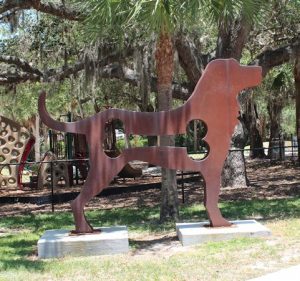 show that helped commemorate the City of Bonita Springs’ 14th birthday. Big Dog was a traveling large-scale public art exhibition that contained 15 of Rogers’ Cor-Ten steel dogs.
show that helped commemorate the City of Bonita Springs’ 14th birthday. Big Dog was a traveling large-scale public art exhibition that contained 15 of Rogers’ Cor-Ten steel dogs.
“I created this travelling exhibit in 2009 because I strongly believe that public exposure to art is a critical component to the health of our communities,” Rogers explains. “Art is a catalyst for thought, conversation and connection. Public Art goes even further by 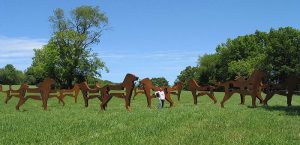 becoming a part of the community; something available for everyone. I built the exhibit for a New England tour which travelled through six cities in three states. After seeing its success, I made the exhibit available to be rented out by corporations, individuals or non-profits as a way to
becoming a part of the community; something available for everyone. I built the exhibit for a New England tour which travelled through six cities in three states. After seeing its success, I made the exhibit available to be rented out by corporations, individuals or non-profits as a way to 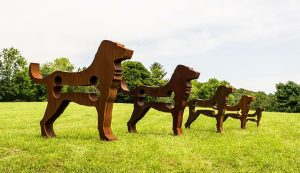 raise awareness for their own organization or one they support.”
raise awareness for their own organization or one they support.”
When the show moved on, Rusty remained behind. He became part of the Bonita Springs public art collection, joining an earlier work the City had purchased from Rogers, Away, which is located across Old 41 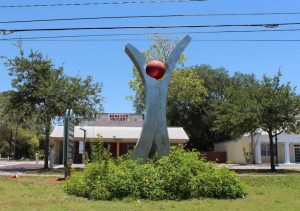 from Benson’s Grocery (which sports its own public artwork, a mural titled Mi Pueblo Bonito (My Beautiful Town)).
from Benson’s Grocery (which sports its own public artwork, a mural titled Mi Pueblo Bonito (My Beautiful Town)).
“He was supposed to go into the City’s new dog park,” notes Bonita Springs City Councilwoman Janet Martin, “but the residents out there [who have come to regard him as a member of the community] have insisted that he stay in Depot Park.” 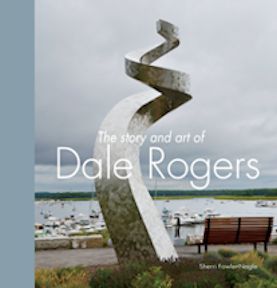 Their collective feeling demonstrates the power of public art when it comes to place making and engendering community identity and civic pride.
Their collective feeling demonstrates the power of public art when it comes to place making and engendering community identity and civic pride.
Dale Rogers is a Massachusetts metal sculptor whose career as a monumental artist spans more than a decade. Rogers works primarily with stainless Cor-Ten steel. “Stainless Steel is beautiful and versatile,” Rogers remarks. “The surface of it can be done in many different finishes, with the variations adding dimension and depth.”
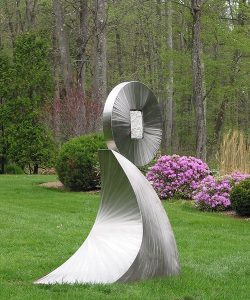 He favors Cor Ten because of its “long life/low maintenance” reputation. “It is what cities and the federal government use to make bridges out of. It oxidizes over time and then seals itself. It offers an organic and simple element to the sculptures while the stainless steel brings in a little more pizzazz and punch.”
He favors Cor Ten because of its “long life/low maintenance” reputation. “It is what cities and the federal government use to make bridges out of. It oxidizes over time and then seals itself. It offers an organic and simple element to the sculptures while the stainless steel brings in a little more pizzazz and punch.”
Rogers’ process takes at least six months from conception to completion. “When an idea comes to me I think about it for some time before moving to the next step,” he confides. “I complete a sketch and then begin the process of transferring that idea to something that can be created with metal in my studio. I use 3-D software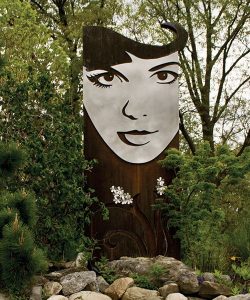 to perfect the image I want before breaking it apart into workable pieces to be laser cut.”
to perfect the image I want before breaking it apart into workable pieces to be laser cut.”
Assembly requires TIG welding. Rogers became interested in welding long before he began creating monumental artworks when he taught himself to repair metal equipment on his family’s farm. His interest in art started even before that, when he was in school.
“Art was always something I loved, but truthfully didn’t think it was a career path that could support a family,” says Rogers, echoing a sentiment voiced by the vast majority of his fellow artists. “It always struck 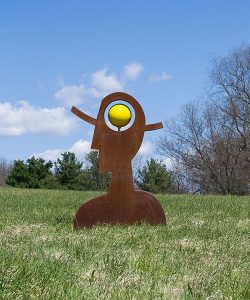 me as a hobby, and having it make sense economically didn’t seem feasible.” That sensibility has informed his artworks, helping him maintain a companionable balance between his creative impulses with the economic realities of marketing, selling, and transporting large heavy metal sculptures.
me as a hobby, and having it make sense economically didn’t seem feasible.” That sensibility has informed his artworks, helping him maintain a companionable balance between his creative impulses with the economic realities of marketing, selling, and transporting large heavy metal sculptures.
“My love for art lies in abstract geometrics, and much of my body of work encompasses the clean simple properties of that style,” the artist reveals. “Over the years, I have incorporated iconic and whimsical shapes into my sculptures that allow viewers to connect with my art on an emotional level. My public exhibits feature 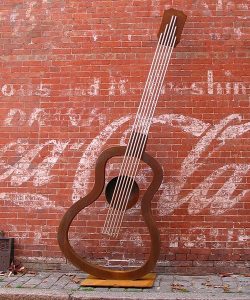 sculptures that do just this. I strive to create thought-provoking work that is sophisticated, easily recognized, and will serve as a mental postcard. I take pleasure in creating work that inspires the public to think about the world differently. I truly believe adding sculpture to the public landscape forever enhances the environment and the art serves as a reflection of the quality of the community.”
sculptures that do just this. I strive to create thought-provoking work that is sophisticated, easily recognized, and will serve as a mental postcard. I take pleasure in creating work that inspires the public to think about the world differently. I truly believe adding sculpture to the public landscape forever enhances the environment and the art serves as a reflection of the quality of the community.”
In addition to Florida, Rogers has work in public art collections in California, Connecticut, Illinois, Indiana, Maryland, Massachusetts, Michigan, Minnesota, New Jersey, New Hampshire, North Carolina, 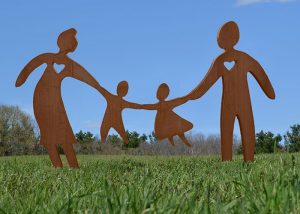 Ohio, Pennsylvania, Texas, Utah, Vermont and Virginia, as well as Ontario, Canada. Within the state, Rogers’ work can be found in Cape Coral, Coconut Creek, Delray Beach, Fort Lauderdale, Ocala, Orlando, Valrico and Winter Park.
Ohio, Pennsylvania, Texas, Utah, Vermont and Virginia, as well as Ontario, Canada. Within the state, Rogers’ work can be found in Cape Coral, Coconut Creek, Delray Beach, Fort Lauderdale, Ocala, Orlando, Valrico and Winter Park.
Over the past few years, Rogers has installed pieces on several academic and corporate campuses, including Southern New 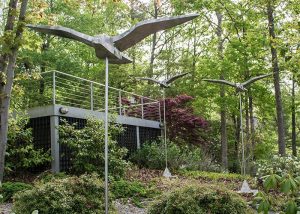 Hampshire University, Northern MI College, Haverhill High School, Pingree High School, Idexx, NE Bio-Lab and Bissell Corporation.
Hampshire University, Northern MI College, Haverhill High School, Pingree High School, Idexx, NE Bio-Lab and Bissell Corporation.
“I am honored that my large sculptures enhances many public spaces across the nation for visitors to enjoy and I hope to have a piece of public art in every state by 2015,” Rogers states.
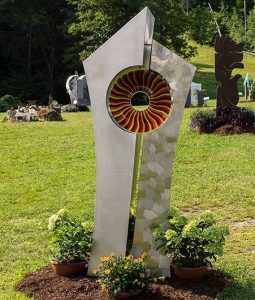 In addition to his public art pieces, Rogers also designs large-scale sculptures for individual installation. “My work includes sculptures for home and garden all of which are on display at fine galleries throughout the U.S. and are included in exclusive private and corporate collections.” This weekend, a variety of them will be on display in Riverside Park during Bonita Springs National Art Festival.
In addition to his public art pieces, Rogers also designs large-scale sculptures for individual installation. “My work includes sculptures for home and garden all of which are on display at fine galleries throughout the U.S. and are included in exclusive private and corporate collections.” This weekend, a variety of them will be on display in Riverside Park during Bonita Springs National Art Festival.
Perhaps your collection will also include a Dale Rogers sculpture after this weekend. The show takes place Saturday and Sunday, February 10 & 11.
_____________________________________________
Spotlight on porcelain sculptor Debra Steidel (02-07-18)
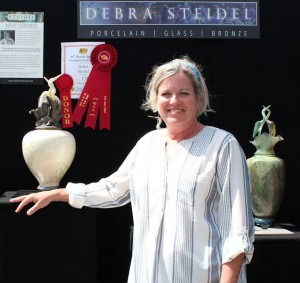 The name Debra Steidel is synonymous with exquisite porcelain vessels finished with mesmerizing crystalline glazes. She’s perfected the recipes for the latter over decades with the patience of a Julia Child or other accomplished gourmet chef. You can see Steidel’s award-winning work at the Bonita Springs National Art Festival this weekend. She’ll be among the accomplished and nationally-acclaimed artists who have been invited to exhibit and sell their original, handmade artworks at the two-day art fair, which is being held in
The name Debra Steidel is synonymous with exquisite porcelain vessels finished with mesmerizing crystalline glazes. She’s perfected the recipes for the latter over decades with the patience of a Julia Child or other accomplished gourmet chef. You can see Steidel’s award-winning work at the Bonita Springs National Art Festival this weekend. She’ll be among the accomplished and nationally-acclaimed artists who have been invited to exhibit and sell their original, handmade artworks at the two-day art fair, which is being held in 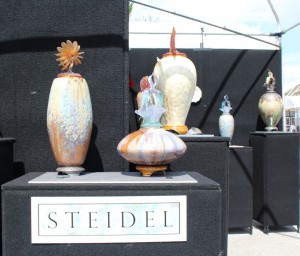 Riverside Park in Old Bonita Springs.
Riverside Park in Old Bonita Springs.
“The glazes contain minerals that promote the growth of crystals and crystal formations,” Debra is quick to point out. “The key is the way it’s fired. You have to have a really slow cool or the crystals won’t form. So I do various holds for different amounts of time as the vessel cools in the kiln.”
Because of improvements in kiln technology, Steidel can program the temperatures and times she wants as 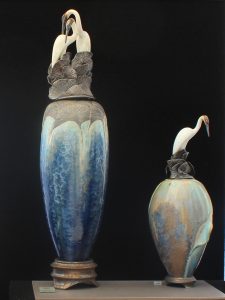 each piece cools. That wasn’t always the case. Before the new technology, she had to switch the kiln on and off. Guessing and crossed fingers were key ingredients back then.
each piece cools. That wasn’t always the case. Before the new technology, she had to switch the kiln on and off. Guessing and crossed fingers were key ingredients back then.
“Now, I can digitally program the temperatures I want, even increasing and decreasing them, which opens up the possibilities of what you can achieve with the glazes.”
The glaze itself contains a secret mixture of oxides that Debra meticulously blends together to create a range of colors and crystal formations. Once the piece has been brushed with the crystalline glaze, it is placed in a high-fire kiln oven and heated to 2300 degrees. But it’s the timed 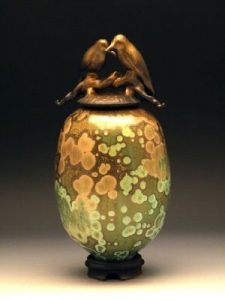 temperature holds and slow cooling process that produces the vivid colors and organic crystal formations that collectors covet.
temperature holds and slow cooling process that produces the vivid colors and organic crystal formations that collectors covet.
While Steidel’s final glazes are nothing short of spectacular, they are only the final step in a process that begins with carefully throwing and pulling the vessel on a potter’s wheel and continues with her drawing a design on the dried clay, which she carves into the surface using a range of tools to give each piece its three-dimensional texture or relief. Areas of the vessel that will eventually resemble a metallic bronze-like quality once the piece is finished are also given an under-glaze before the piece is fired for the first time at a temperature of 1800 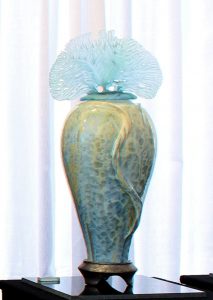 degrees in order to create a bisque model.
degrees in order to create a bisque model.
Each vessel also features a specially-designed lid. These she sculpts in porcelain first, but farms out to two different foundries, one for bronze and the other glass.
“I send the original lids to them, pick out the color combinations I want to use, and they make a mold off my original and do the casting for me,” Debra shares. Each lid is a separate and distinct sculpture, and can range from birds, leaves and sea fans to more archaic influences, such as shells, fossils and bones. Once placed atop the chosen vessel, the lid becomes the focal point of the final piece.
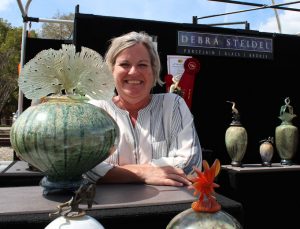 Although Debra tried her hand at painting, drawing, pen-and-ink, pastels and charcoal while in high school, she knew by her 18th birthday that clay was her medium of choice. “This really captured me, and is all I’ve ever wanted to do,” Debra acknowledges. In fact, she still has her original potter’s wheel, although it finally gave out a couple of years ago and now occupies a position of prominence outside her studio, a monument to her enduring love of
Although Debra tried her hand at painting, drawing, pen-and-ink, pastels and charcoal while in high school, she knew by her 18th birthday that clay was her medium of choice. “This really captured me, and is all I’ve ever wanted to do,” Debra acknowledges. In fact, she still has her original potter’s wheel, although it finally gave out a couple of years ago and now occupies a position of prominence outside her studio, a monument to her enduring love of 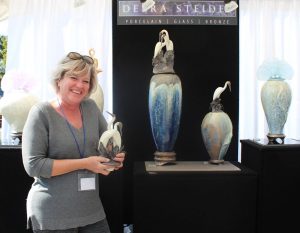 clay, ceramics and all things porcelain.
clay, ceramics and all things porcelain.
Steidel has been doing art fairs and festivals for as long as she can remember. Last year, she did 30, but because her process is so time-consuming and encompassing, she plans to reduce the number of shows at which she exhibits to between 12 and 15 annually. Even at 30 shows a year, she’s pretty choosey about 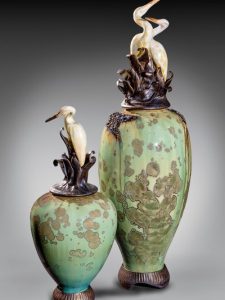 where and when to spend her weekends. Bonita Springs National makes her short list.
where and when to spend her weekends. Bonita Springs National makes her short list.
Over the years, Debra has enjoyed the pleasure of meeting thousands of art lovers. Many have become repeat collectors. But one stands out above the others.
“We were doing a show in Kansas City some fifteen years ago, and this young boy of about 10 came into the booth and, after walking around quietly for a little while, looked at me and said, ‘I would like to buy some pieces,’” recounts Debra, a broad smile extending from her face to her twinkling blue eyes.
“It was a different body of work and my price range was a little 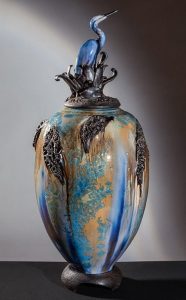 lower back then, but he bought three pieces that totaled $400. He paid me in $1 bills. They were all bound together. When he left, his mom came in and told me that he’d mowed lawns all summer so that he could come to the art fair and buy my work. I was so honored that a kid would do that.”
lower back then, but he bought three pieces that totaled $400. He paid me in $1 bills. They were all bound together. When he left, his mom came in and told me that he’d mowed lawns all summer so that he could come to the art fair and buy my work. I was so honored that a kid would do that.”
Debra saw the boy a couple of years later. He’d grown about a foot and purchased another piece. “This time, he paid in twenties,” she laughs. “He said, ‘I’m tutoring now, so I’m making more money.” One can only imagine the private collection he’s put together by now.
But finding art with which to start or enhance a collection is only part of the fun 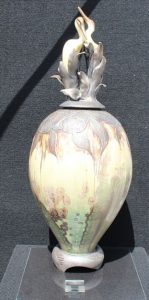 associated with art fairs and festivals. They also provide an unparalleled opportunity to meet and speak with emerging and mid-career artists about their work and inspiration.
associated with art fairs and festivals. They also provide an unparalleled opportunity to meet and speak with emerging and mid-career artists about their work and inspiration.
“Where else can you walk through such a high concentration of artworks and talk directly to the artist who created it,” asks Debra’s life and business partner, Charles. It’s so drastically different from the gallery experience, where you never see the artist and speak only to a gallery director or representative.
Debra Steidel’s work can be found in corporate and private collections throughout the United States and the United Kingdom. She has won numerous prestigious awards for her artwork, which continues to grow and evolve. Regardless of where Debra applies her expertise, you can be sure it will exemplify the qualities of balance, novelty and wonder.
________________________________________________________
Atlanta abstract artist Cat Tesla returns to Bonita National (02-07-18)
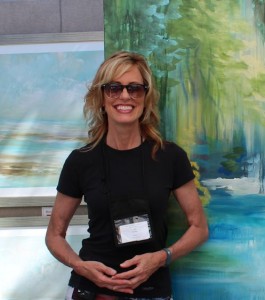 Atlanta abstract artist Cat Tesla is one of the artists exhibiting new work at this weekend’s Bonita Springs National Art Festival.
Atlanta abstract artist Cat Tesla is one of the artists exhibiting new work at this weekend’s Bonita Springs National Art Festival.
Tesla describes her work as an ongoing exploration of abstract designs “executed in mixed media on canvas and birch supports.” She is intrigued by color, texture and the juxtaposition of shapes. But new this year are some large-scale paintings from a brand new series called Chrysalis.
“The question I get most often at art festivals is ‘Where did you get your inspiration?’,” Cat shares. Her 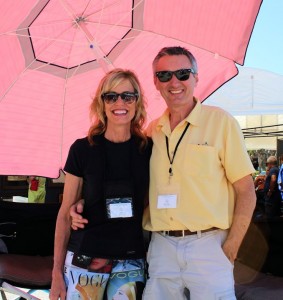 inspiration for Chrysalis emanated from a trip that she and her husband, Simon (photo 2), took to Serbia and Croatia. “We were hiking. Everything was blooming, kind of bursting open, and it made me think of a butterfly emerging from its cocoon. There were butterflies all over, but it wasn’t the butterflies themselves that served as the impetus for the titling of the series.” That flowed organically from the transitioning Cat saw all around her as nature emerged with the fanfare of color and energy from the slumber of winter into a new season of life.
inspiration for Chrysalis emanated from a trip that she and her husband, Simon (photo 2), took to Serbia and Croatia. “We were hiking. Everything was blooming, kind of bursting open, and it made me think of a butterfly emerging from its cocoon. There were butterflies all over, but it wasn’t the butterflies themselves that served as the impetus for the titling of the series.” That flowed organically from the transitioning Cat saw all around her as nature emerged with the fanfare of color and energy from the slumber of winter into a new season of life.
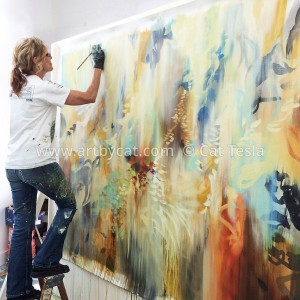 That’s a typically Cat-like realization. While the content of her paintings comes from nature, Cat begins her mornings with meditation to clear her mind so that she can focus on truth, flow and harmony. “I like to come to the canvas without any preconceived notions and see what happens. For me, this is the best way for the truth to reveal itself.”
That’s a typically Cat-like realization. While the content of her paintings comes from nature, Cat begins her mornings with meditation to clear her mind so that she can focus on truth, flow and harmony. “I like to come to the canvas without any preconceived notions and see what happens. For me, this is the best way for the truth to reveal itself.”
As a result of the meditative process that gives rise to her compositions, Cat’s paintings convey a sense of calm and respite. “I strive to communicate what 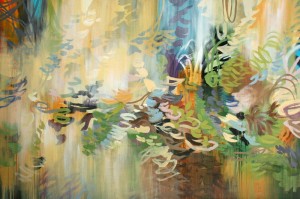 can only be felt, rather than seen,” Cat states. “The world around us provides a constant and unending display for our senses if we only slow down to take notice.” In this vein, she quotes the Persian mystic and poet Rumi, who once said, “Observe the wonders as they occur around you. Don’t claim them. Feel the artistry moving through and be silent.”
can only be felt, rather than seen,” Cat states. “The world around us provides a constant and unending display for our senses if we only slow down to take notice.” In this vein, she quotes the Persian mystic and poet Rumi, who once said, “Observe the wonders as they occur around you. Don’t claim them. Feel the artistry moving through and be silent.”
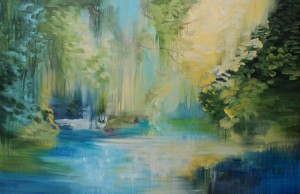 The paintings in the new series are layered abstract pieces that express this experience of nature unfolding. “They’re naturescapes,” says Cat, pointing to a soothing abstract that conveys the restful feel of a waterfall in the middle of a meadow (photo 4). “Others are more literal and depict what I actually saw while we were hiking.” (Photo 5.)
The paintings in the new series are layered abstract pieces that express this experience of nature unfolding. “They’re naturescapes,” says Cat, pointing to a soothing abstract that conveys the restful feel of a waterfall in the middle of a meadow (photo 4). “Others are more literal and depict what I actually saw while we were hiking.” (Photo 5.)
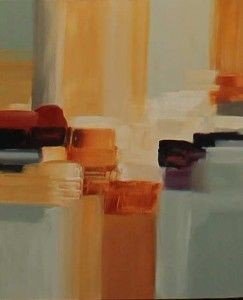 Those who’ve followed the evolution of Tesla’s work will immediately notice that her canvases have grown dramatically in scale. “I ‘ve gone much larger over the past three years. I’d been wanting to [for some time] but we just didn’t have a large enough van to carry them,” laughs Tesla, paying tribute to the logistics and practicalities of exhibiting primarily at outdoor art fairs and festivals. An upgrade in transportation now permits her to indulge the creative desire to paint larger pieces.
Those who’ve followed the evolution of Tesla’s work will immediately notice that her canvases have grown dramatically in scale. “I ‘ve gone much larger over the past three years. I’d been wanting to [for some time] but we just didn’t have a large enough van to carry them,” laughs Tesla, paying tribute to the logistics and practicalities of exhibiting primarily at outdoor art fairs and festivals. An upgrade in transportation now permits her to indulge the creative desire to paint larger pieces.
Of course, Tesla still produces smaller works, including her meditative landscapes.
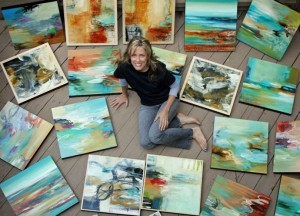 “Everyone has gifts from the Creator,” Cat professes. “I believe it is the duty of each of us to share our gifts with the planet. My paintings are a brave look inward – revealing what lies beneath both literally and spiritually. Yogis call it the ‘divine flame’ – the spark that motivates you in life. In Buddha’s words, ‘Look within, thou art the Buddha,’ while Jesus taught us that ‘the kingdom of heaven is within you.’ For me, painting is the most life affirming thing to do.”
“Everyone has gifts from the Creator,” Cat professes. “I believe it is the duty of each of us to share our gifts with the planet. My paintings are a brave look inward – revealing what lies beneath both literally and spiritually. Yogis call it the ‘divine flame’ – the spark that motivates you in life. In Buddha’s words, ‘Look within, thou art the Buddha,’ while Jesus taught us that ‘the kingdom of heaven is within you.’ For me, painting is the most life affirming thing to do.”
_____________________________________________________
Bonita Springs National Art Festival announces winners (01-14-18)
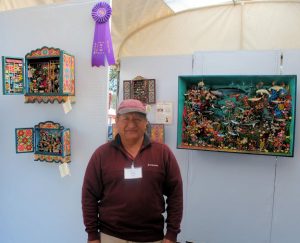 The first of three Bonita Springs National Art Festivals wrapped up on Sunday, January 14 with the announcement of winners in various categories. Naples artist Nicario Jimenez was chosen as the overall Best of Show for his three-dimensional mixed media retablos, sophisticated Peruvian folk art in the form of portable boxes filled with brightly colored figurines arranged into intricate narrative scenes.
The first of three Bonita Springs National Art Festivals wrapped up on Sunday, January 14 with the announcement of winners in various categories. Naples artist Nicario Jimenez was chosen as the overall Best of Show for his three-dimensional mixed media retablos, sophisticated Peruvian folk art in the form of portable boxes filled with brightly colored figurines arranged into intricate narrative scenes.
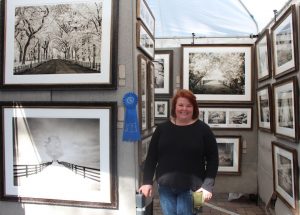 Photographer Russell Grace received Best of 2D honors with Nnamdi Okonkwo snagging honors for Best of 3D.
Photographer Russell Grace received Best of 2D honors with Nnamdi Okonkwo snagging honors for Best of 3D.
Twelve artists received Awards of Distinction:
- Tricia Young, jewelry
- Kimberly Wilcox, sculpture
- Lyn Sedlak-Ford, mixed media 2D
- Warner Whitfield, glass
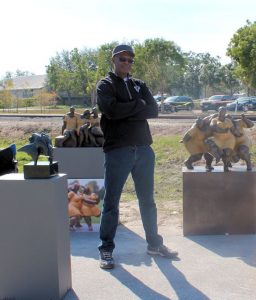 Li Li, graphics
Li Li, graphics- Robert Green, photography
- David Melnick, jewelry
- Ann Wooster/A. Peaselee, graphics
- Marty Hulsebos, photography
- Peter Rujuwa, sculpture
- Lin Carl Cristo, jewelry
- Dan Goad, watercolor
Bonita Springs National Art Festival will return to Riverside Park on February 10 & 11 and for a third time March 3-4, 2018.
________________________________________________
Spotlight on Best of Show winner Nicario Jimenez (01-14-18)
 The first of three Bonita Springs National Art Festivals wrapped up on Sunday, January 14 with the announcement of winners in various categories. Naples artist Nicario Jimenez was chosen as the overall Best of Show for his three-dimensional mixed media retablos, sophisticated Peruvian folk art in the form of portable boxes filled with brightly colored figurines arranged into intricate narrative scenes.
The first of three Bonita Springs National Art Festivals wrapped up on Sunday, January 14 with the announcement of winners in various categories. Naples artist Nicario Jimenez was chosen as the overall Best of Show for his three-dimensional mixed media retablos, sophisticated Peruvian folk art in the form of portable boxes filled with brightly colored figurines arranged into intricate narrative scenes.
For 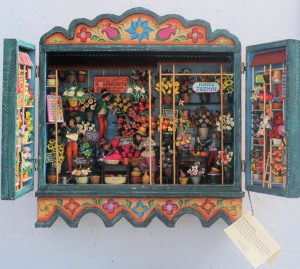 Jimenez, retablo is a family tradition. He is a third generation retablista from the Andean region of Ayacucho. His grandfather began by making the boxes of Saint Mark, and his father modernized the retablos to include folk themes. Nicario has taken the art form one step farther by addressing contemporary social issues through his work.
Jimenez, retablo is a family tradition. He is a third generation retablista from the Andean region of Ayacucho. His grandfather began by making the boxes of Saint Mark, and his father modernized the retablos to include folk themes. Nicario has taken the art form one step farther by addressing contemporary social issues through his work.
From the 16th to the 19th centuries, Spanish priests carried retablos through the mountains as portable religious shrines of Catholic saints. Later, they were 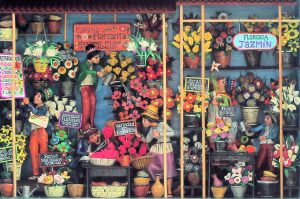 adapted by the indigenous people to include their own deities and mythologies. Nicario’s compositions depict religious, historical and everyday events important to the indigenous people of the highlands of Peru. His hands move quickly and with confidence to fashion people, animals and mythological figures as he creates poignant scenes from a doughy mixture of boiled potato and gypsum powder.
adapted by the indigenous people to include their own deities and mythologies. Nicario’s compositions depict religious, historical and everyday events important to the indigenous people of the highlands of Peru. His hands move quickly and with confidence to fashion people, animals and mythological figures as he creates poignant scenes from a doughy mixture of boiled potato and gypsum powder. 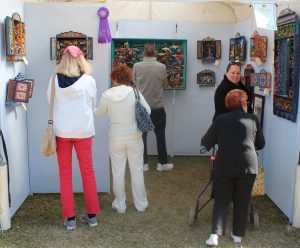 His only tool is a small piece of wood resembling an enlarged toothpick. That’s because the figurines are built up and molded. There is very little sculpting involved.
His only tool is a small piece of wood resembling an enlarged toothpick. That’s because the figurines are built up and molded. There is very little sculpting involved.
“Viewing his works, one can easily appreciate that they are equivalent to the best examples of politically aware ‘fine art’ being produced anywhere,” proclaims Prof. Robert I. Loescher, who holds the G. McComb Finn Endowed Chair for Art History at the Art Institute of Chicago. “His 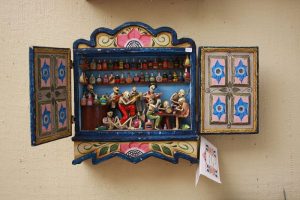 works speak … with unparalleled poignancy and virtuosity. Nicario Jimenez is as visually articulate in rendering socio-political images of the present, as he is in rendering traditional religious themes.”
works speak … with unparalleled poignancy and virtuosity. Nicario Jimenez is as visually articulate in rendering socio-political images of the present, as he is in rendering traditional religious themes.”
Since the 1980s, Jimenez has exhibited in his native Peru, as well as Ecuador, Venezuela, Canada and 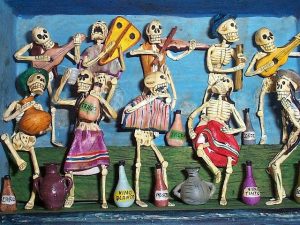 Korea, together with universities and museums throughout the United States. His one person exhibitions include the San Francisco Craft and Folk Art Museum, the Cleveland Institute of Art, the Museum of Man in San Diego, California, the North Dakota Museum of Art, and the Rhode Island School of Design. In 1992, he was commissioned to create a retablo for the Smithsonian Institution’s Quincentenary Exhibit “Seeds of Change.”
Korea, together with universities and museums throughout the United States. His one person exhibitions include the San Francisco Craft and Folk Art Museum, the Cleveland Institute of Art, the Museum of Man in San Diego, California, the North Dakota Museum of Art, and the Rhode Island School of Design. In 1992, he was commissioned to create a retablo for the Smithsonian Institution’s Quincentenary Exhibit “Seeds of Change.” 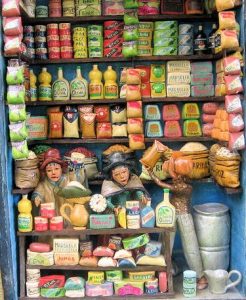 The Smithsonian subsequently purchased the retablo for its permanent collection.
The Smithsonian subsequently purchased the retablo for its permanent collection.
Born in a peasant community in the high Peruvian Andes, Jimenez studied sculpture at the Centro de Capacitacion Artesanal de Huamanaga and attended the Universidad Nacional San Cristobal de Huamanga in Ayacucho, Peru. He has taught and lectured at the University of Miami, the University of California, San Diego, Whittier College and American University. Jimenez’s work is included in numerous prestigious public, corporate, and private collections. The artist now lives in Naples, Florida.
_______________________________________
Spotlight on wood turner Ray Cannata (01-11-18)
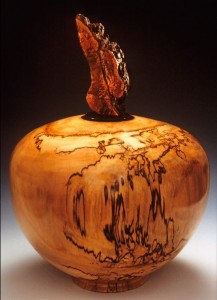 The next Bonita Springs National Art Festival opens January 13 in Riverside Park in historic old Bonita Springs. This boutique -style, two-day outdoor juried fine art and fine craft show attracts some of the country’s finest artists. Ray Cannata is among the artists participating in this year’s show.
The next Bonita Springs National Art Festival opens January 13 in Riverside Park in historic old Bonita Springs. This boutique -style, two-day outdoor juried fine art and fine craft show attracts some of the country’s finest artists. Ray Cannata is among the artists participating in this year’s show.
Cannata is a self-described wood turner. Like the potter’s wheel, the wood lathe is a simple mechanism that can generate a variety of forms limited only by the turner’s imagination. In Cannata’s case, his lathe turns out a variety of irregular abstract shapes as well as smooth, highly polished symmetrical open and closed bowls and platters.
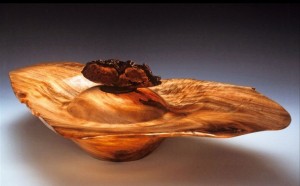 Ray hollows out his closed bowls through the hole in the top. The degree of difficulty associated with the finished work is a function of the diameter of the hole in the top and the height of the piece.
Ray hollows out his closed bowls through the hole in the top. The degree of difficulty associated with the finished work is a function of the diameter of the hole in the top and the height of the piece.
Cannata is attracted to the grain and features of the wood he chooses for each artwork. While he has an innate affinity for wood of all kinds, including spalted or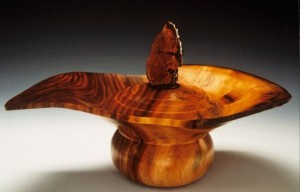 partially-rotten wood, he especially has developed a deep love of cherry wood from New England, which he turns into fantastic salad bowls of various sizes.
partially-rotten wood, he especially has developed a deep love of cherry wood from New England, which he turns into fantastic salad bowls of various sizes.
“I also find it very challenging to develop the inner beauty of burl and design asymmetrical artistic pieces,” Cannata adds.
T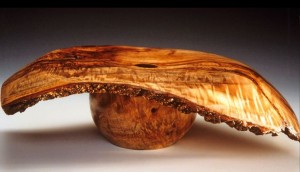 urning enables Cannata to indulge his passion for working with his hands. Cannata also relishes the tactile and visual qualities of the wood as well as the challenge of problem-solving associated with wood turning.
urning enables Cannata to indulge his passion for working with his hands. Cannata also relishes the tactile and visual qualities of the wood as well as the challenge of problem-solving associated with wood turning.
Cannata is a member of the American Association of Wood Turners, 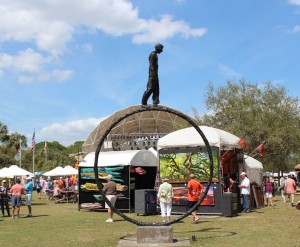 Spring Hill Art League, Hernando County Fine Arts Council, and Killington Vt. Art Guild. Ray moved to Spring Hill several years ago from Killington. Born in New York City, he earned his bachelor’s and master’s degrees before embarking on extensive travels throughout Europe to study ancient Greek and Roman art treasures and Renaissance works located in Italy, France and Spain.
Spring Hill Art League, Hernando County Fine Arts Council, and Killington Vt. Art Guild. Ray moved to Spring Hill several years ago from Killington. Born in New York City, he earned his bachelor’s and master’s degrees before embarking on extensive travels throughout Europe to study ancient Greek and Roman art treasures and Renaissance works located in Italy, France and Spain.
You can meet Ray and view his unique pieces at the Bonita Springs National Art Festival.
___________________________________________________
Spotlight on Award of Distinction winner John Costin (01-11-18)
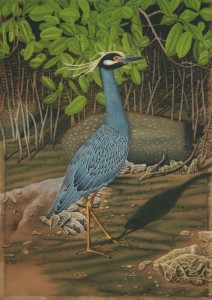 Local artist John Costin is a past Bonita Springs National Art Festival Award of Distinction recipient. You can see his latest work when John returns to Riverside Park this weekend for the January, 2018 edition of one of Southwest Florida’s top-ranked outdoor art shows.
Local artist John Costin is a past Bonita Springs National Art Festival Award of Distinction recipient. You can see his latest work when John returns to Riverside Park this weekend for the January, 2018 edition of one of Southwest Florida’s top-ranked outdoor art shows.
An Ybor City (Tampa) native, Costin showcases Florida’s wildlife with his unique, yet realistic etchings of bird life on copper. Costin’s work reflects a profound sensitivity toward his subject, which allows for his highly accurate portrayal with incredible detail. The artist uses a wide range of color, which stimulates the senses and enhances the authenticity of the viewing experience.
“Most of my subjects are depicted life size,” states John.” I go out in the field and take hundreds of photos of whatever bird I want to work on. The photos are taken back to my studio for me to study them and are then put away. I then draw from memory, creating the backgrounds and posing the subject. I never use photographs while drawing because I do not want my subjects to look photographic. That is extremely important to me.”
_____________________________________________________________________
Bonnie Shanas exhibiting at Bonita Springs National Art Festival in January (01-11-18)
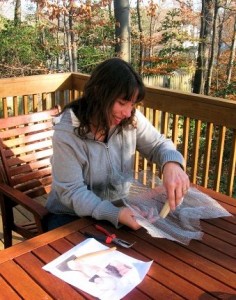 The Bonita Springs National Art Festival returns to Riverside Park in historic old Bonita Springs on Saturday and Sunday, January 13 and 14. Among the accomplished and highly-acclaimed exhibitors juried into this month’s show by organizer Center for the Arts of Bonita Springs is metal screen sculptor Bonnie Shanas.
The Bonita Springs National Art Festival returns to Riverside Park in historic old Bonita Springs on Saturday and Sunday, January 13 and 14. Among the accomplished and highly-acclaimed exhibitors juried into this month’s show by organizer Center for the Arts of Bonita Springs is metal screen sculptor Bonnie Shanas.
Shanas’ art was shaped by intensive study in the studio classes of Israeli artist No’am Douieb and through a mentorship by sculptor Shaulmit Hartal. From the former, Shanas developed a unerring eye for figurative studies. From Hartal, Bonnie acquired the skill to use mesh sculpting to capture the human 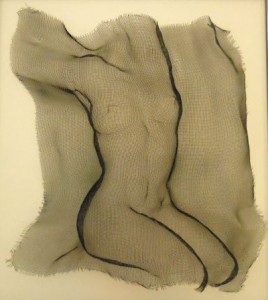 form.
form.
“As an artist, I find myself most intrigued by the study of the human form,” Shanas remarks. “I am as much inspired by dance and movement as I am by the subtleties and simplicity of unspoken gestures. Together these compose a universal language which I attempt to instill and imbue in my work.”
In fact, Shanas’ Dancers collection belies both a love of dance and fascination for bodies in movement. With titles such as The Dance Within, The Melody Within and Just a Small Dance Away, this body of 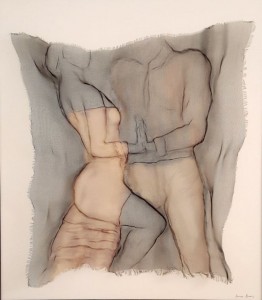 Shanas’ work expresses not just dance steps or poses, but the inner emotion that gives impetus to the flow, harmonic interdependence and kinesthesia that characterizes dancers at the moment when legato supersedes cognition.
Shanas’ work expresses not just dance steps or poses, but the inner emotion that gives impetus to the flow, harmonic interdependence and kinesthesia that characterizes dancers at the moment when legato supersedes cognition.
In her In Two’s series, Shanas finds ways to use metal and modeling to convey the subtle little ways that lovers connect, from the touch of their fingertips to the clench of their hands as their bodies align. The fact that these pieces are typically monotone adds to their focus and augments their mesmerizing allure.
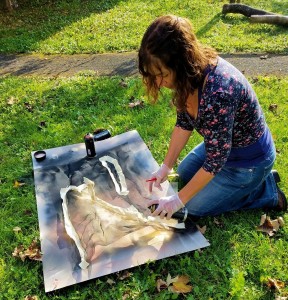 For Shanas, wire mesh is an obvious choice of medium because its translucence and transparency infuse an air of simplicity and lightness to gestures and movement she strives to capture in her sculptural work. But the metal’s durability also ensures its longevity. “The hardness of the metal promises that the moment captured continues well beyond its fragment of time,” Bonnie observes.
For Shanas, wire mesh is an obvious choice of medium because its translucence and transparency infuse an air of simplicity and lightness to gestures and movement she strives to capture in her sculptural work. But the metal’s durability also ensures its longevity. “The hardness of the metal promises that the moment captured continues well beyond its fragment of time,” Bonnie observes.
Most artists shy away from unforgiving media like wire mesh. That quality is another feature that attracts Shanas to the medium. “While most 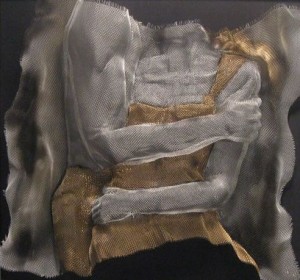 forms of sculpture are additive or reductive, I enjoy the challenge of breathing life into a sheet of steel wire mesh, where no material can be added or removed, and no crease erased.”
forms of sculpture are additive or reductive, I enjoy the challenge of breathing life into a sheet of steel wire mesh, where no material can be added or removed, and no crease erased.”
Bonnie’s path to a career in art was rather circuitous. A New Jersey native, her family relocated to Israel when she was still very young. In school, her studies carried her into a life in the corporate world. But she closed her office doors in 2006 to answer the call of artistic creativity, and since returning to the 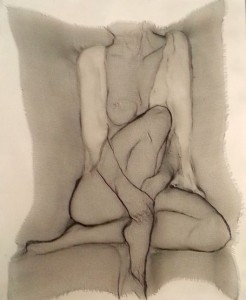 United States in 2009, she has continued to develop her talents and establish a reputation as an accomplished metal sculptor.
United States in 2009, she has continued to develop her talents and establish a reputation as an accomplished metal sculptor.
Today, Bonnie exhibits in both juried and invitational exhibits and national shows. Not surprisingly, she has won numerous awards and honorable mentions. Over the past five years, she has also participated in a number of art residencies in France and Poland, collaborating with internationally-acclaimed artists on themed exhibits.
Shanas’ work can be found in public installations in France, Poland and the United States as well as private collections here and in England and Australia.
____________________________________________________________________________________________
Best of show and award of distinction honorees named for March’s Bonita Springs National Art Festival (03-08-17)
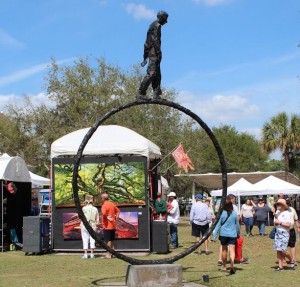 The third and final Bonita Springs National Art Festival of 2017 took place March 4 and 5, and Centers for the Arts Bonita Springs President Susan Bridges and Festival Directors Ehren Gerhard and Barry Witt have announced the Best of Show honorees and Award of Distinction recipients.
The third and final Bonita Springs National Art Festival of 2017 took place March 4 and 5, and Centers for the Arts Bonita Springs President Susan Bridges and Festival Directors Ehren Gerhard and Barry Witt have announced the Best of Show honorees and Award of Distinction recipients.
Fine art jeweler Tricia Young was the overall Best of Show honoree. Best of 2D was fine art photographer Igor Menaker with clay artist Debra Steidel being recognized as Best of 3D.
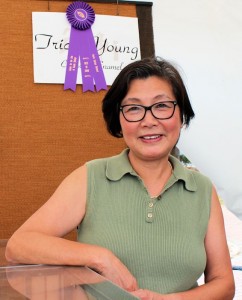 A dozen artists received Awards of Distinction:
A dozen artists received Awards of Distinction:
- Gustavo Castillo, oil/acrylic
- Stephan Ray, oil/acrylic
- Jeannie Maddox, oil/acrylic
- Lee Jones, metal
- Edward Loedding, digital
- Erika Mock, fiber
- Bruce Holmberg, jewelry
- Julie Jelman Melka, jewelry
- Julie Berndt, clay
- Reza Pishgahi, sculpture
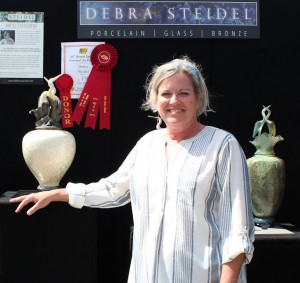 John Furches, graphics
John Furches, graphics- Kyle Wilson, photography
Bridges, Gerhard and Witt extended their thanks and appreciation to all the artists who participated in each of this year’s Bonita National Art Festivals. “You make the arts a reality for thousands of people of all ages throughout the year.”
_____________________________________________________________________________
Area fine art jeweler Kathleen Dennison exhibiting at this weekend’s Bonita National (03-03-17)
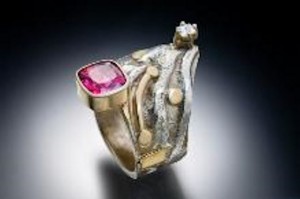 Kathleen Dennison is one of the area artists who is exhibiting work in this weekend’s Bonita Springs National Art Festival in Riverside Park.
Kathleen Dennison is one of the area artists who is exhibiting work in this weekend’s Bonita Springs National Art Festival in Riverside Park.
Dennison comes from an artistic heritage. A native of New York City, she spent her formative years being exposed not only to the culture of the city but being surrounded by the numerous artists her 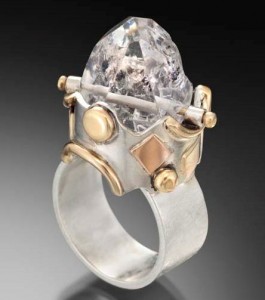 parents represented in their art business. Shortly after moving to Naples, she met renowned goldsmith Ruth Roach, who became Kathleen’s teacher, mentor and friend. Kathleen went on to study with metalsmiths Arline Fisch, Eleanor Moty, Marne Ryan and Deb Stoner, and she has been making handcrafted art jewelry now since 1972. Recent workshops in glass bead making have added a colorful new facet to her body of work.
parents represented in their art business. Shortly after moving to Naples, she met renowned goldsmith Ruth Roach, who became Kathleen’s teacher, mentor and friend. Kathleen went on to study with metalsmiths Arline Fisch, Eleanor Moty, Marne Ryan and Deb Stoner, and she has been making handcrafted art jewelry now since 1972. Recent workshops in glass bead making have added a colorful new facet to her body of work.
“From the very first piece of jewelry I made, I have been enchanted by the fluid nature of precious metals, how I am able to transform silver and gold with hammers, hands and a 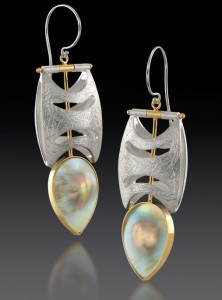 variety of tools into works of art,” says Kathleen.
variety of tools into works of art,” says Kathleen.
In addition to hammers, Dennison uses a medley of pliers, torches and precious metals to fashion unique pieces of art jewelry. “I work to create pieces that are well constructed, original in design and lacking in commercialism,” Kathleen expounds. “I find inspiration from all aspects of my life, from the materials themselves and the physical process of creating each piece. I believe people value the individualism and craftsmanship of handmade art jewelry.”
Kathleen has been a Niche Award finalist and her work has earned her awards of excellence from Polk Museum’s Mayfair Art Show and Florida Craftsman CraftArt 2004 exhibition. She shares a studio with husband, Robert, who is also a goldsmith.
____________________________________________________________________
Photographer Calli Hobgood wins Best of Show honors at Bonita National (02-14-17)
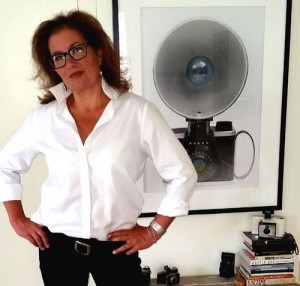 The February edition of the Bonita Springs National Art Festival took place last weekend and Calli Hobgood received top honors as Best of Show.
The February edition of the Bonita Springs National Art Festival took place last weekend and Calli Hobgood received top honors as Best of Show.
Hobgood is an award-winning, widely collected artist and is represented in public and private collections, galleries and museums around the country. Cali studied photography at the University of Illinois and lives in Urbana, Illinois with an emphasis on the theories of visual representation and art 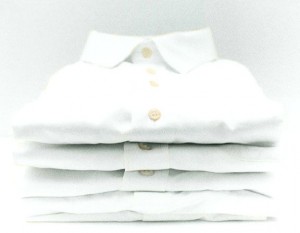 history. She’s been the proprietor of her art photography business since 1986. She has been exhibiting at outdoor art festivals for more than 25 years.
history. She’s been the proprietor of her art photography business since 1986. She has been exhibiting at outdoor art festivals for more than 25 years.
Cali produces hand-colored black and white photographs, which she prints in a silver-process darkroom and then paints with high-quality oils using techniques varying from brushwork to application with cotton swabs. She 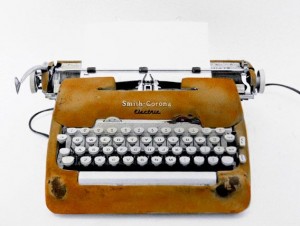 focuses on the simplicity of iconic images ranging from typewriters and umbrellas to men’s shirts and dresses. By combining her technique of developing the negatives of the film she shoots and then hand-coloring the photograph with her high-contrast printing style, Hobgood is able to produce gorgeous tones and textures that are in perfect union with her compelling subject matter. In this,
focuses on the simplicity of iconic images ranging from typewriters and umbrellas to men’s shirts and dresses. By combining her technique of developing the negatives of the film she shoots and then hand-coloring the photograph with her high-contrast printing style, Hobgood is able to produce gorgeous tones and textures that are in perfect union with her compelling subject matter. In this, 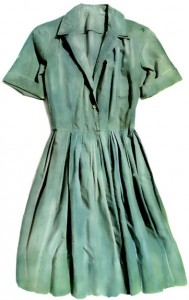 it is her goal and objective to move her viewers from the familiar to provoking a thought, to invoking a feeling or a memory associated with an object from their past of that of their parents.
it is her goal and objective to move her viewers from the familiar to provoking a thought, to invoking a feeling or a memory associated with an object from their past of that of their parents.
“Right now I think my pieces have the essence of a stage set – I can control the subject with my camera and make it more of what it is,” writes Calli. “Isolating these everyday items gives them an iconic nature that moves the images from the everyday to a moment from our lives.”
While Calli produces her images in editions of five to five hundred, each piece is unique because of the variability of printing the negative individually and then hand-coloring the photograph. So collectors enjoy the economy of a limited edition print with the originality of a hand-painted giclee.
_____________________________________________________________________
Artist Edward Park heads list of notable locals exhibiting at Bonita National (02-07-17)
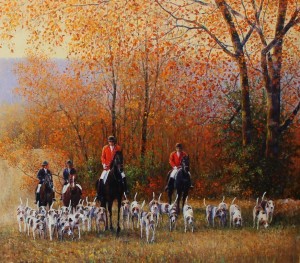 The Bonita Springs National Art Festival takes place in Riverside Park on February 11 & 12, 2017. Among the area artists exhibiting in the show is Naples artist Edward Park.
The Bonita Springs National Art Festival takes place in Riverside Park on February 11 & 12, 2017. Among the area artists exhibiting in the show is Naples artist Edward Park.
It is difficult enough to master one genre, but Park is accomplished in three. Take a jaunt around his booth this weekend and you will quickly find that he is equally adept at impressionism, realism and abstract art.
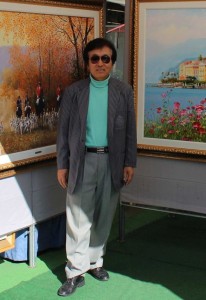 A graduate of the Ringling College of Art and Design who also studied at the Pont-Aven School of Contemporary Art in France, Park has been painting for half a century. Today, he is acclaimed internationally for brilliant color combinations and remarkable palette knife technique. Nowhere is that more evident than in his fall scenes, where he engrafts layer upon layer of oil on top of his linen support to fashion dazzling, dappled forest scenes in yellows, orange and red.
A graduate of the Ringling College of Art and Design who also studied at the Pont-Aven School of Contemporary Art in France, Park has been painting for half a century. Today, he is acclaimed internationally for brilliant color combinations and remarkable palette knife technique. Nowhere is that more evident than in his fall scenes, where he engrafts layer upon layer of oil on top of his linen support to fashion dazzling, dappled forest scenes in yellows, orange and red.
Park groups his paintings into several series: American landscapes, European scenery, modern impressionism, his road series and his Garden of Eden. “But my most popular paintings are my rowboats,” notes the artist. “They instill calm and serenity,” he explains with the 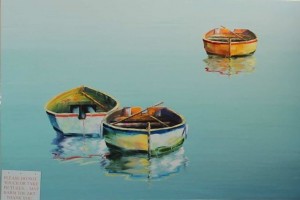 aura of a master in Zen or transcendental meditation. Without outboard motors, rudders or oars, they encourage viewers to reflect on the source of their own inner peace and direction.
aura of a master in Zen or transcendental meditation. Without outboard motors, rudders or oars, they encourage viewers to reflect on the source of their own inner peace and direction.
Park operates out of his 2,000 square-foot studio and gallery at 1719 Trade Center Way in Naples. “I have been at Naples Fine Arts Studio and Gallery 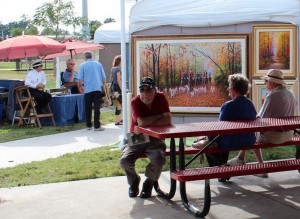 for 19 years,” he notes proudly of his stability and longevity in the notoriously volatile art market. His is a career decorated by an extensive list of awards, commissions and other honorariums.
for 19 years,” he notes proudly of his stability and longevity in the notoriously volatile art market. His is a career decorated by an extensive list of awards, commissions and other honorariums.
If you haven’t experienced Park’s works, you can view them at Bonita Springs National Art Festival.
_______________________________________________________________________
Bonita National provides glimpse into creative journey of magical realist Marcus Thomas (02-07-17)
 Marcus C. Thomas discovered the joy of painting after surviving a snow skiing accident in 1986 that left him paralyzed from the shoulders down. It would have been understandable if the young man had given in to self-pity. After all, at the time it happened he was an athletic and physically-active college grad with a brand new degree in commercial recreation who had just taken a job as the activities director at a vacation resort.
Marcus C. Thomas discovered the joy of painting after surviving a snow skiing accident in 1986 that left him paralyzed from the shoulders down. It would have been understandable if the young man had given in to self-pity. After all, at the time it happened he was an athletic and physically-active college grad with a brand new degree in commercial recreation who had just taken a job as the activities director at a vacation resort.
“That Christmas,” Marcus tells, “I received a set of 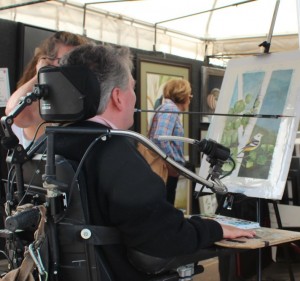 Crayola watercolors.” Although he had no background in art, he launched himself into a new adventure. He became not just a painter, but an artist whose works are so realistic, you’d swear you were looking at a photograph rather than an oil on canvas or panel.
Crayola watercolors.” Although he had no background in art, he launched himself into a new adventure. He became not just a painter, but an artist whose works are so realistic, you’d swear you were looking at a photograph rather than an oil on canvas or panel.
“I like realism and the edginess of surrealism,” Marcus notes, and toward that end, his paintings combine hyper-realistic technique with magical surrealism imagery.
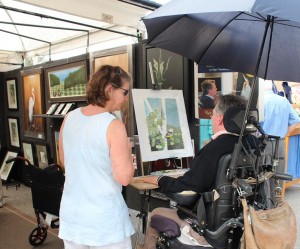 Dating as far back as van Eyck and Vermeer, artists have used various techniques including camera obscura in order to achieve a photographic quality in their finished work. But not Marcus Thomas. He paints free hand, except in his case, he uses a brush rigged to a mouthpiece that he clenches between his teeth. But as a result, he’s required to make adaptations in the process to which classically-trained artists religiously adhere.
Dating as far back as van Eyck and Vermeer, artists have used various techniques including camera obscura in order to achieve a photographic quality in their finished work. But not Marcus Thomas. He paints free hand, except in his case, he uses a brush rigged to a mouthpiece that he clenches between his teeth. But as a result, he’s required to make adaptations in the process to which classically-trained artists religiously adhere.
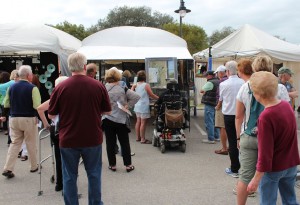 He cannot render a drawing of his motif or subject matter in pencil or charcoal. “I have to use a small, fine point brush instead.” And once he places the outline of his composition on canvas, he can’t hone the image with a Sharpie or magic marker. “I just start applying the paint,” he mentally shrugs.
He cannot render a drawing of his motif or subject matter in pencil or charcoal. “I have to use a small, fine point brush instead.” And once he places the outline of his composition on canvas, he can’t hone the image with a Sharpie or magic marker. “I just start applying the paint,” he mentally shrugs.
His results are spectacular. His paintings regularly 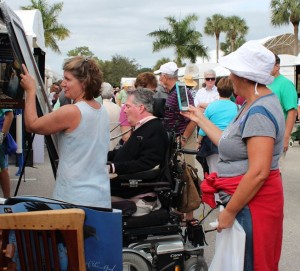 stop festival-goers dead in their tracks. Only then do they notice Marcus parked in his wheelchair, meticulously daubbing paint on a canvas and stroking it into place.
stop festival-goers dead in their tracks. Only then do they notice Marcus parked in his wheelchair, meticulously daubbing paint on a canvas and stroking it into place.
Not only are his works a true crowd pleaser, they have garnered him a number of Best of Shows. “I like art festivals,” says the artist. “They allow me to travel and be outdoors.”
Marcus is quick to give credit to the love of his life. 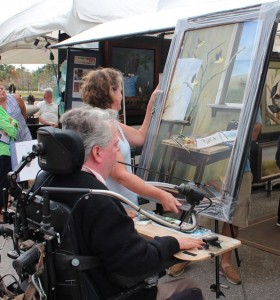 “Without my wife, Anne, this wouldn’t be possible. In fact, a new pictorial biography titled Flight of the Mind: A Painter’s Journey through Paralysis gives a compelling glimpse into how Anne and Marcus have established daily rituals that sustain their creative journey. The book also treats readers to more than 200 color-plate photographs of Thomas’ work from his early watercolor wildlife renderings to his recent magical realism oil narratives, underscoring how the themes of flight, adventure and the natural world have remained constants in Marcus’ life since his childhood.
“Without my wife, Anne, this wouldn’t be possible. In fact, a new pictorial biography titled Flight of the Mind: A Painter’s Journey through Paralysis gives a compelling glimpse into how Anne and Marcus have established daily rituals that sustain their creative journey. The book also treats readers to more than 200 color-plate photographs of Thomas’ work from his early watercolor wildlife renderings to his recent magical realism oil narratives, underscoring how the themes of flight, adventure and the natural world have remained constants in Marcus’ life since his childhood.
__________________________________________________________________
Bonita Springs National returns to Riverside Park on February 11 and 12 (02-06-17)
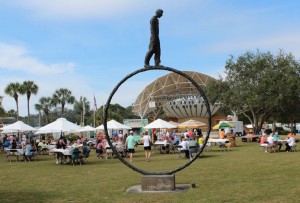 The Bonita Springs National Art Festival returns to Riverside Park in Bonita Springs on the weekend of February 11 and 12. Like its January and March editions, this festival places a heavy emphasis on quality and originality, with the 211 artists juried into the show from across the United States, Canada, South America and even Europe exhibiting and selling original paintings, drawings,
The Bonita Springs National Art Festival returns to Riverside Park in Bonita Springs on the weekend of February 11 and 12. Like its January and March editions, this festival places a heavy emphasis on quality and originality, with the 211 artists juried into the show from across the United States, Canada, South America and even Europe exhibiting and selling original paintings, drawings, 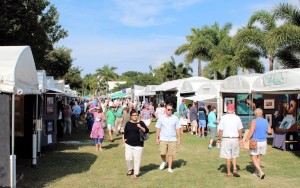 pastels, photography, handcrafted jewelry, clay works and ceramics, glass art, metal sculpture and more. Together with the festivals held in January and March, this show is a major fundraiser for the Center of the Arts of Bonita Springs.
pastels, photography, handcrafted jewelry, clay works and ceramics, glass art, metal sculpture and more. Together with the festivals held in January and March, this show is a major fundraiser for the Center of the Arts of Bonita Springs.
_________________________________________________________________________
Bonita National, Naples National and ArtFest Fort Myers in top 50 national art festivals (06-22-16)
 The votes are in, and according to the thousands who responded to ArtFairsCalendar.com’s annual nationwide survey, ArtFest Fort Myers, Bonita Springs National Art Festival and Naples National Art Festival landed in the top 50 of their “must attend” outdoor art festivals and fine craft shows year in and year out! These three local festivals join such renowned Florida shows as the Las Olas Art Fair in Fort Lauderdale, Mount Dora Art Festival in Mount Dora, Coconut Grove Arts Festival in Miami, Winter Park Sidewalk
The votes are in, and according to the thousands who responded to ArtFairsCalendar.com’s annual nationwide survey, ArtFest Fort Myers, Bonita Springs National Art Festival and Naples National Art Festival landed in the top 50 of their “must attend” outdoor art festivals and fine craft shows year in and year out! These three local festivals join such renowned Florida shows as the Las Olas Art Fair in Fort Lauderdale, Mount Dora Art Festival in Mount Dora, Coconut Grove Arts Festival in Miami, Winter Park Sidewalk 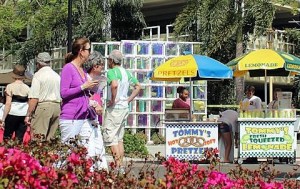 Art Festival outside Orlando, and Art Basel in Miami Beach. Naples National was the #2 “Best Southern Art Fair” with ArtFest Fort Myers garnering #5.
Art Festival outside Orlando, and Art Basel in Miami Beach. Naples National was the #2 “Best Southern Art Fair” with ArtFest Fort Myers garnering #5.
Among the criteria the respondents used to judge their finalists were quality of art (48%), venue setting & ambiance (12%), affordability/wide 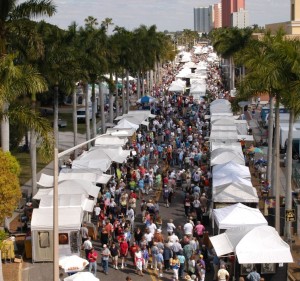 price range (10%), family friendly/kids activities (10%), number of exhibitors (8%), location, accessibility & parking (6%), variety of media (4%) and good food & music (4%).
price range (10%), family friendly/kids activities (10%), number of exhibitors (8%), location, accessibility & parking (6%), variety of media (4%) and good food & music (4%).
Nearly one-third of the survey-takers said they have attended between 11 and 25 art fairs over the last five years, with 26.59% having attended 6-10, 21.36% having attended 1-4, and 19.09% saying they’ve attended more than they can count over the five-year timeframe. The average age of the  respondents was 59, with 72% being female. Of additional interest, the average income of the respondents was $127,843 with 46% of the survey-takers having either a law or masters degree and 42% having some post-graduate education.
respondents was 59, with 72% being female. Of additional interest, the average income of the respondents was $127,843 with 46% of the survey-takers having either a law or masters degree and 42% having some post-graduate education.
ArtFairCalendar survey went out to over 50,000 e-newsletter subscribers and via Facebook last 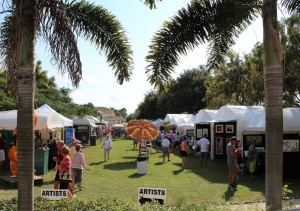 October with voting running into November. In all, ArtFairCalendar received completed surveys from nearly 2,000 voters. “Amazingly, 87% of the respondents completed the entire survey and followed all the prompts,” noted ArtFairCalendar Publisher Connie Mettler. “No ‘cat herding’ was necessary.” Voting was heaviest in the South and Mid-West.
October with voting running into November. In all, ArtFairCalendar received completed surveys from nearly 2,000 voters. “Amazingly, 87% of the respondents completed the entire survey and followed all the prompts,” noted ArtFairCalendar Publisher Connie Mettler. “No ‘cat herding’ was necessary.” Voting was heaviest in the South and Mid-West.
Kudos to Naples National, ArtFest Fort Myers and Bonita Springs National Art Festival.
_____________________________________________________________________________________________
Centers for the Arts Bonita Springs issues call for volunteers for final Bonita National Art Festival of 2016 (02-23-15)
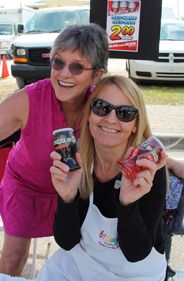 The final edition of this season’s Bonita Springs National Art Festival takes place in Riverside Park on March 5 & 6, and the Centers for the Arts Bonita Springs has issued a call for volunteers to work at the show. “Join us for 3 hours, enjoy beautiful art, meet new friends and help us provide art programming to our community,” states CFABS. “It’s easy and fun.”
The final edition of this season’s Bonita Springs National Art Festival takes place in Riverside Park on March 5 & 6, and the Centers for the Arts Bonita Springs has issued a call for volunteers to work at the show. “Join us for 3 hours, enjoy beautiful art, meet new friends and help us provide art programming to our community,” states CFABS. “It’s easy and fun.”
Volunteers can select the time that works best for them:
- Saturday 11:30 a.m. – 2:30 p.m.
- Saturday 2:00-5:00 p.m.
- Sunday 9:00 a.m. to noon
- Sunday 11:30 a.m. – 2:30 p.m.
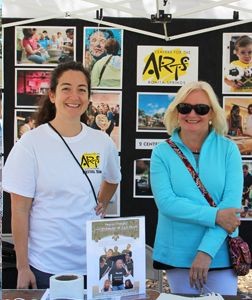 Sunday 2:00-5:00 p.m.
Sunday 2:00-5:00 p.m.
And they can select a task:
- Gate monitors 9-12, 11:30-2:30, or 2-5
- Beverage sellers 9-12, 11:30-2:30 or 2-5
- Booth-sitters 12:30-3:00
No experience is needed to volunteer. Please call 495-8989 or email help1@artsbonita.org with the day, time and job preference.
_____________________________________________________________________________
Fine art photographer Marius Moore captures Best of Show honors at Bonita National (01-31-16)
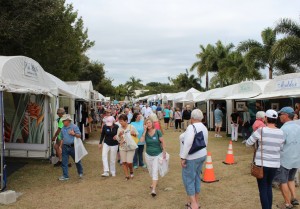 The Bonita Springs National Art Festival wraps up today, and the Centers for the Arts of Bonita Springs has announced that fine art photographer Marius Moore received its coveted Best of Show award.
The Bonita Springs National Art Festival wraps up today, and the Centers for the Arts of Bonita Springs has announced that fine art photographer Marius Moore received its coveted Best of Show award.
Moore has invested numerous weekends in his 10×10 foot booth since 1998, displaying his images and talking with the festival attendees who wander 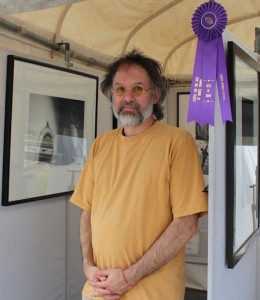 in for a closer look. “What you see in it now is my mind and eyeball’s (the left one’s) latest work,” Marius quips. “Before this incarnation, I traveled to the other side of the world off and on for seven years to create images in Asia. Before that I did Polaroid transfers, and there were a couple of other artistic periods as well.”
in for a closer look. “What you see in it now is my mind and eyeball’s (the left one’s) latest work,” Marius quips. “Before this incarnation, I traveled to the other side of the world off and on for seven years to create images in Asia. Before that I did Polaroid transfers, and there were a couple of other artistic periods as well.”
The work from those periods was predominately in color, but his newest series is shot entirely in black-and-white. “While in India and Japan in 2014, I dabbled in black and white photography for the first time in decades,” Marius explains. “It was good. I enjoyed it. I came home and 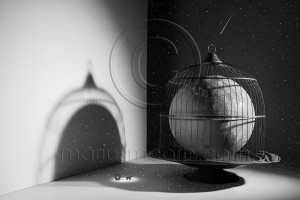 wanted to dabble more. So I did; in my studio. That was good too.”
wanted to dabble more. So I did; in my studio. That was good too.”
Rather than just capturing images of the world he found in his viewfinder, Moore discovered the endless fun and frustration associated with creating his own small worlds to photograph. “There is light to finesse, angles to ponder and 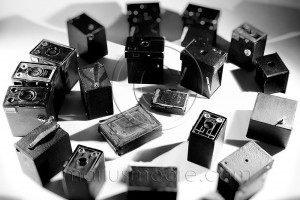 thoughts to deconstruct,” Marius expounds. “Sometimes a concept is preconceived, sometimes it just happens, and sometimes it takes time to evolve.”
thoughts to deconstruct,” Marius expounds. “Sometimes a concept is preconceived, sometimes it just happens, and sometimes it takes time to evolve.”
Moore employs a combination of old and new technology to create his images. “I use vintage lense on a modern camera. I print with a modern 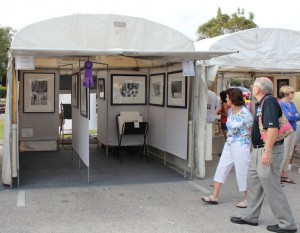 machine on classic darkroom-style paper.” And he uses a special viewfinder that filters out color, showing him what his subject looks like in black and white. “That shifts the focus to value and the interplay of light and shadows. It is very Yin and Yang,” he adds, acknowledging that his experiences in Asia will always influence the way he thinks and sees the world.
machine on classic darkroom-style paper.” And he uses a special viewfinder that filters out color, showing him what his subject looks like in black and white. “That shifts the focus to value and the interplay of light and shadows. It is very Yin and Yang,” he adds, acknowledging that his experiences in Asia will always influence the way he thinks and sees the world.
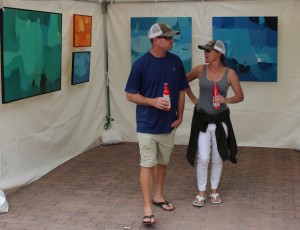 Moore received his B.A. in Fine Arts from USF with an emphasis in photography “many moons ago.”
Moore received his B.A. in Fine Arts from USF with an emphasis in photography “many moons ago.”
Best of 2D honors went oil/acrylic painter Mamuka Didebashvili.
Best of 3D was awarded to wood sculptor Steven Potts, who took Best of Show honors at the January 9/10 edition of Bonita Springs National 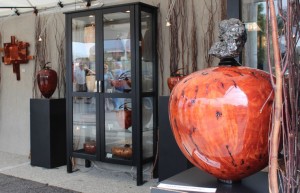 just three weeks ago.
just three weeks ago.
Awards of Distinction were conferred on:
- 3D mixed media artist Kimberly Wilcox
- Sculptor Antanas Ulevicius
- Jeweler Anton Kozlowski
- Oil/acrylic painter Jeanne Maddox
- Glass artist Ronnie Hughes
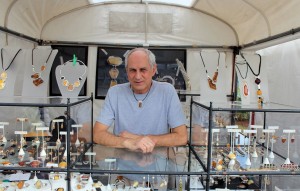 Fine art photographer Edward Loedding
Fine art photographer Edward Loedding- Metal sculptor Clayton Swartz
- Graphics/drawing artist Anne Wooster
- Fine art photographer John Granata
- Fine art photographer Cali Hobgood
- Oil/acrylic painter David Gordon
- Sculptor Ben Foster
Bonita Springs National returns once more this season, occupying Riverside Park on March 5 & 6, 2016.
____________________________________________________________________________________
Clearing skies, warmer temps to greet attendees at today’s Bonita Springs National Art Festival (01-31-16)
 Forecasters promise clearing skies and warmer temperatures for folks who turn out for Day 2 of this weekend’s Bonita Springs National Art Festival. The show features original, high-quality work by more than 200 artists, including paintings, drawings, pastels, photography, handcrafted jewelry, clay works and ceramics, glass art, metal sculpture and more.
Forecasters promise clearing skies and warmer temperatures for folks who turn out for Day 2 of this weekend’s Bonita Springs National Art Festival. The show features original, high-quality work by more than 200 artists, including paintings, drawings, pastels, photography, handcrafted jewelry, clay works and ceramics, glass art, metal sculpture and more.
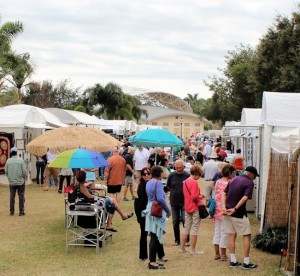 Together with the festivals held in earlier in January and March, this show is a major fundraiser for the Center of the Arts of Bonita Springs. Proceeds raised through the festivals from donations made at the gate and artist application and booth fees stay in Bonita Springs and are used by the Center for the Arts to provide scholarships, exhibitions, community events, and low-cost youth and adult art programming and classes. Specifically:
Together with the festivals held in earlier in January and March, this show is a major fundraiser for the Center of the Arts of Bonita Springs. Proceeds raised through the festivals from donations made at the gate and artist application and booth fees stay in Bonita Springs and are used by the Center for the Arts to provide scholarships, exhibitions, community events, and low-cost youth and adult art programming and classes. Specifically:
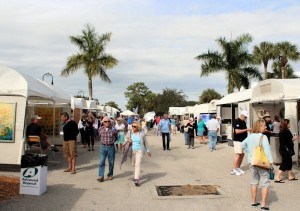 local elementary schools receive over $20,000 worth of visual and performing arts programming annually through free programs like “Art Goes to School” and “After School Express;”
local elementary schools receive over $20,000 worth of visual and performing arts programming annually through free programs like “Art Goes to School” and “After School Express;”- local youth and adults receive over $20,000 worth of free Community Theater Programs with full scale productions throughout the year;
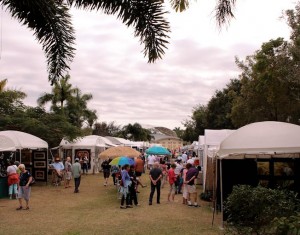 local high school students receive over $7,000 worth of free sculpture and painting classes annually through the Center’s High School Mentor Program;
local high school students receive over $7,000 worth of free sculpture and painting classes annually through the Center’s High School Mentor Program;- local high school, middle and elementary school students receive over $6,500 in free exhibitions, receptions and award programs annually;
- local youth receive over $60,000 in scholarships annually to participate in visual and performing
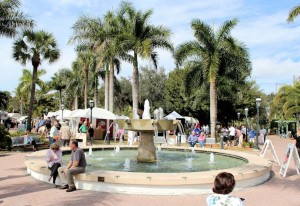 arts programming;
arts programming; - local families receive over $5,000 worth of free Saturday Family Activity Days annually, featuring docent tours, hands‐on art projects, and a film series; and
- free annual “Arts WorldWide” festival featuring visual and performing arts by artists from countries and cultures around the world. ith a
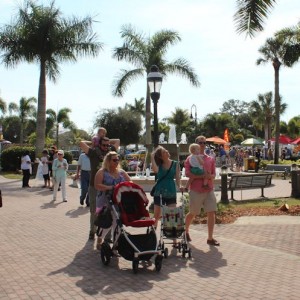 budget of over $10,000, the Arts Worldwide festival fosters understanding, literacy, and sensitivity to the many cultures that make up our diverse community
budget of over $10,000, the Arts Worldwide festival fosters understanding, literacy, and sensitivity to the many cultures that make up our diverse community
With a budget of more than $10,000, the “Arts Worldwide festival fosters understanding, literacy and sensitivity to the many cultures that make up our diverse community. The Center for the Arts offers one of the only free youth theater programs in the area. It remains free because of proceeds from the festival.
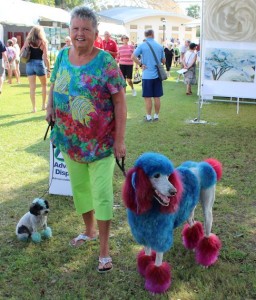 “We never thought of ourselves as creating a local legacy until our 50th anniversary, when we celebrated our service to our community,” says Center for the Arts President Susan Bridges. “At our celebration, Mayor Ben Nelson, spoke about all we’ve accomplished, including our festivals. We realized just how remarkable our legacy is and what the festivals and our organization have given to our community.” The Bonita Springs National Art Festivals have given identity and brought recognition to Bonita Springs and Southwest Florida, giving the City of Bonita Springs its largest cultural events. “‘A community’s sense of
“We never thought of ourselves as creating a local legacy until our 50th anniversary, when we celebrated our service to our community,” says Center for the Arts President Susan Bridges. “At our celebration, Mayor Ben Nelson, spoke about all we’ve accomplished, including our festivals. We realized just how remarkable our legacy is and what the festivals and our organization have given to our community.” The Bonita Springs National Art Festivals have given identity and brought recognition to Bonita Springs and Southwest Florida, giving the City of Bonita Springs its largest cultural events. “‘A community’s sense of 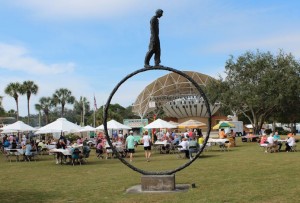 place, its unique ‘fabric’ is not a static concept; it evolves and develops over time,” notes Operations Director Kathy Saldivar. “The festivals help shape, reveal and enhance our identity, the unique meaning, value and character of our community.”
place, its unique ‘fabric’ is not a static concept; it evolves and develops over time,” notes Operations Director Kathy Saldivar. “The festivals help shape, reveal and enhance our identity, the unique meaning, value and character of our community.”
The Bonita Springs National Art Festival is an entirely volunteer effort, which enables the Center for the Arts to keep the cost of the festivals extremely low.
The festival opens today at 10 a.m. and runs through 5 p.m.
______________________________________________________________
Bonita Springs National Art Festival opens today in Riverside Park (01-30-16)
 Bonita Springs National Art Festival opens at 10 a.m. today in Riverside Park in Bonita Springs. Like its January 9/10 and March 5/6 editions, this festival places a heavy emphasis on quality and originality, with more than 200 artists juried into the show from across the United States, Canada, South America and even Europe exhibiting and selling original paintings, drawings,
Bonita Springs National Art Festival opens at 10 a.m. today in Riverside Park in Bonita Springs. Like its January 9/10 and March 5/6 editions, this festival places a heavy emphasis on quality and originality, with more than 200 artists juried into the show from across the United States, Canada, South America and even Europe exhibiting and selling original paintings, drawings, 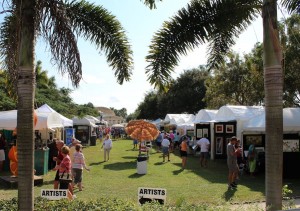 pastels, photography, handcrafted jewelry, clay works and ceramics, glass art, metal sculpture and more. Together with the festivals held in earlier in January and March, this show is a major fundraiser for the Center of the Arts of Bonita Springs.
pastels, photography, handcrafted jewelry, clay works and ceramics, glass art, metal sculpture and more. Together with the festivals held in earlier in January and March, this show is a major fundraiser for the Center of the Arts of Bonita Springs.
__________________________________________________________________________
Digital art pioneer Eddie Myers to exhibit cutting edge works at this weekend’s Bonita Springs National (01-27-16)
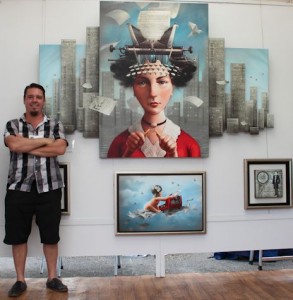 This weekend, Bonita Springs National Art Festival takes over picturesque Riverside Park. The January 30/31 show will feature work in numerous media, genres and motifs by artists from across the country. Artist Eddie Myers represents an emerging media, that of digital photography.
This weekend, Bonita Springs National Art Festival takes over picturesque Riverside Park. The January 30/31 show will feature work in numerous media, genres and motifs by artists from across the country. Artist Eddie Myers represents an emerging media, that of digital photography.
Myers likens to the strides made by digital art to what the world experienced in the years following the introduction of the typewriter. “The typewriter changed everything,” muses Myers. “It drastically improved communication, modernized cities and  even opened doors to the pursuit of creating career equality. Women were entering the workforce at a perfect time, when our world faced rapid change.” And typewriter technology has paved the way for even more rapid and pervasive change in the form of word processing and personal computing.
even opened doors to the pursuit of creating career equality. Women were entering the workforce at a perfect time, when our world faced rapid change.” And typewriter technology has paved the way for even more rapid and pervasive change in the form of word processing and personal computing.
Advances in digital art have similarly progressed at an exponential rate, particularly in terms of ease of use and the ability to produce truly world-class work. “Without the efforts of early pioneers like Eddie Myers, though, applying a sharp instrument 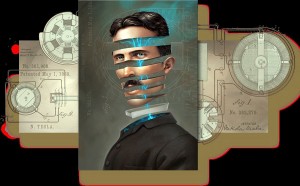 to the nearest cave wall might still be a more viable means of creating images than booting up a computer,” states Sunshine Artist Magazine, which featured Myers in its March, 2014 edition.
to the nearest cave wall might still be a more viable means of creating images than booting up a computer,” states Sunshine Artist Magazine, which featured Myers in its March, 2014 edition.
“When digital tools were first introduced, there were major differences between [them and their physical counterparts],” Myers told Sunshine 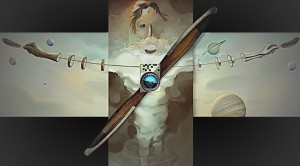 Artist Managing Editor Nate Shelton. “Trying to create a painting in the first Photoshop with a mouse was like trying to paint with a rock. You could do it, but it would take you a really long time. Now, with the combined advancements in software and hardware, digital tools have come closer to a natural feel.”
Artist Managing Editor Nate Shelton. “Trying to create a painting in the first Photoshop with a mouse was like trying to paint with a rock. You could do it, but it would take you a really long time. Now, with the combined advancements in software and hardware, digital tools have come closer to a natural feel.”
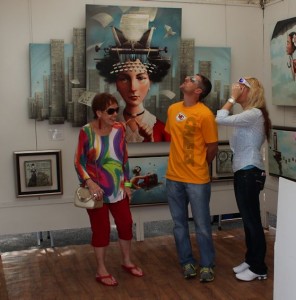 Acceptance of digital by art professionals and collectors has not kept pace with the advancements in digital technology, however. . “Being a digital artist in a fine-art market has been an uphill battle to say the least,” Myers told Shelton for the Sunshine Artist article. “Some get it and some don’t. Some think you are cheating, and some think you are brilliant. I think when you create something out of nothing, it doesn’t matter which tools you use.”
Acceptance of digital by art professionals and collectors has not kept pace with the advancements in digital technology, however. . “Being a digital artist in a fine-art market has been an uphill battle to say the least,” Myers told Shelton for the Sunshine Artist article. “Some get it and some don’t. Some think you are cheating, and some think you are brilliant. I think when you create something out of nothing, it doesn’t matter which tools you use.”
In 2010, Myers decided that more needed to 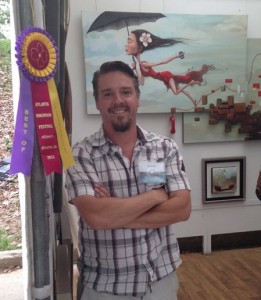 be done to win acceptance of digital as a true fine art medium. So he began displaying his work at nationally-ranked outdoor art fairs and festivals around the country. Back then, digital was rarely recognized as a legitimate, stand-alone category. That has changed now, for the most part, and Myers has won a number of awards for his body of digital work in recent years, including Best of Show at the 2016 Estero Fine Art Show, Best of Category (Digital) at the 2013 Disney’s Festival of the Masters, the Judges Selection at the 2013 Winter Park Autumn Art Festival, and Best of Show at the 2014 St. Stephens Miami Art Show.
be done to win acceptance of digital as a true fine art medium. So he began displaying his work at nationally-ranked outdoor art fairs and festivals around the country. Back then, digital was rarely recognized as a legitimate, stand-alone category. That has changed now, for the most part, and Myers has won a number of awards for his body of digital work in recent years, including Best of Show at the 2016 Estero Fine Art Show, Best of Category (Digital) at the 2013 Disney’s Festival of the Masters, the Judges Selection at the 2013 Winter Park Autumn Art Festival, and Best of Show at the 2014 St. Stephens Miami Art Show.
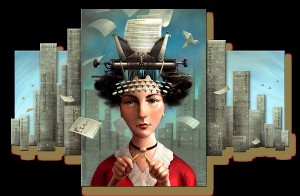 “[But] the best [experience] by far is seeing people’s reaction when they ask me if this is acrylic or oils. When I say, ‘It’s digital,’ you can see the shock [and] confusion in their faces. That’s the fun part.”
“[But] the best [experience] by far is seeing people’s reaction when they ask me if this is acrylic or oils. When I say, ‘It’s digital,’ you can see the shock [and] confusion in their faces. That’s the fun part.”
One such work is his painting The Writing Machine, which metaphorically represents the 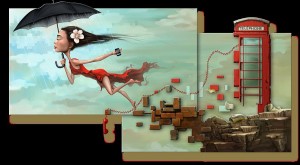 technological advances that are occurring at such a rapid pace. Another is The App-aratus, which depicts a girl who has dropped the telephone call and embraced a new device that can not only make phone calls, but can take photos, send messages and even find your way home if you get lost. “She
technological advances that are occurring at such a rapid pace. Another is The App-aratus, which depicts a girl who has dropped the telephone call and embraced a new device that can not only make phone calls, but can take photos, send messages and even find your way home if you get lost. “She  is stepping off the cliff with her eyes shut, trusting where she is going but not fully understanding how this small communication device will transform mankind,” Myers tells.
is stepping off the cliff with her eyes shut, trusting where she is going but not fully understanding how this small communication device will transform mankind,” Myers tells.
You can see these paintings and Myers’ other digital offerings this weekend at the Bonita Springs National Art Festival. The festival opens at 10 a.m. and runs until 5 p.m. both days.
__________________________________________________________________________________________
Ohio glass artist Italian caning methods and modern color palette to create dramatic glass sculptures (01-25-16)
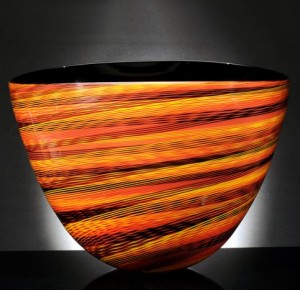 One of the artists traveling to Bonita Springs for this weekend’s Bonita Springs Nationa Art Festival is Ohio glass artist Brian Becher.
One of the artists traveling to Bonita Springs for this weekend’s Bonita Springs Nationa Art Festival is Ohio glass artist Brian Becher.
Becher has been working with glass for the last twelve years. In that time, he has explored many directions and methodologies, including Venetian and Italian cane working techniques. In his pieces, he tries to forge a synthesis between these age-old traditions and modern appeal. Using a color palette that is primarily modern, Becher creates 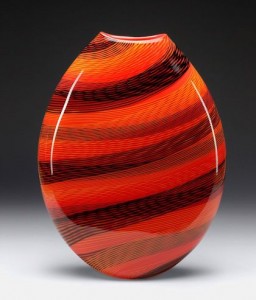 forms that are classical in nature and achieve a balance between line, form, and color with an eye toward portraying a universal sense of beauty. One of Brian’s primary interests is the investigation of pattern, such as the patterns found on textiles or in baskets. In his Color Weave Series, Becher builds up the color layer by layer with the use of glass rods. Each layer is manipulated as it is built. Subsequent layers are added and treated in a similar way, thus creating an inner woven network of lines and color. This allows an infinite number of designs to be created and an extremely dramatic finished work.
forms that are classical in nature and achieve a balance between line, form, and color with an eye toward portraying a universal sense of beauty. One of Brian’s primary interests is the investigation of pattern, such as the patterns found on textiles or in baskets. In his Color Weave Series, Becher builds up the color layer by layer with the use of glass rods. Each layer is manipulated as it is built. Subsequent layers are added and treated in a similar way, thus creating an inner woven network of lines and color. This allows an infinite number of designs to be created and an extremely dramatic finished work.
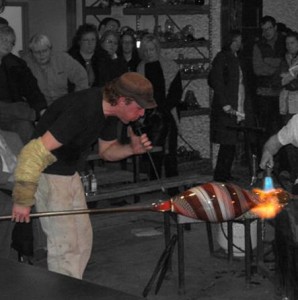 Becher received a BFA from The Ohio State University. He has studied five times at the Pilchuck Glass School in Stanwood, Washington, as well as Penland School of Crafts in North Carolina, and the Corning Museum of Glass. Brian has studied and worked with a multitude of artists, which has allowed him to cultivate and round out his personal aesthetic. He is a member of the Ohio State Glass Club, Glass Arts Society and The Ohio Art League
Becher received a BFA from The Ohio State University. He has studied five times at the Pilchuck Glass School in Stanwood, Washington, as well as Penland School of Crafts in North Carolina, and the Corning Museum of Glass. Brian has studied and worked with a multitude of artists, which has allowed him to cultivate and round out his personal aesthetic. He is a member of the Ohio State Glass Club, Glass Arts Society and The Ohio Art League
Becher’s work will be on display at the Bonita Springs National Art Festival in Riverside Park on January 30 & 31. The show opens at 10 a.m. and closes at 5 p.m. each day. In addition to fine art, there is great food and free live entertainment from world-class favorites.
_______________________________________________________________________
Bonita Springs National Art Festival returns to Riverside Park January 30 & 31 (01-24-16)
 On the weekend of January 3o-31, the Bonita Springs National Art Festival returns to Riverside Park in Bonita Springs. Like its January 9/10 and March 5/6 editions, this festival places a heavy emphasis on quality and originality, with the 211 artists juried into the show from across the United States, Canada, South America and even Europe exhibiting and selling original paintings, drawings,
On the weekend of January 3o-31, the Bonita Springs National Art Festival returns to Riverside Park in Bonita Springs. Like its January 9/10 and March 5/6 editions, this festival places a heavy emphasis on quality and originality, with the 211 artists juried into the show from across the United States, Canada, South America and even Europe exhibiting and selling original paintings, drawings,  pastels, photography, handcrafted jewelry, clay works and ceramics, glass art, metal sculpture and more. Together with the festivals held in earlier in January and March, this show is a major fundraiser for the Center of the Arts of Bonita Springs.
pastels, photography, handcrafted jewelry, clay works and ceramics, glass art, metal sculpture and more. Together with the festivals held in earlier in January and March, this show is a major fundraiser for the Center of the Arts of Bonita Springs.
Please click here for articles, stories, news and reviews about this art festival.
______________________________________________________________________
Wood sculptor Steven Potts awarded Best of Show honors at Bonita National (01-10-16)
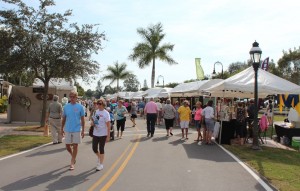 The first of three Bonita Springs National Art Festivals took place over the weekend, and from the more than 200 artists participating in the show, Steven Potts was chosen as Best of Show. Potts creates lathe turned wood vessels with hand tooled designs, inlays, tints and organic elements (images 2 & 3). “I use unusual, rare domestic and exotic woods to
The first of three Bonita Springs National Art Festivals took place over the weekend, and from the more than 200 artists participating in the show, Steven Potts was chosen as Best of Show. Potts creates lathe turned wood vessels with hand tooled designs, inlays, tints and organic elements (images 2 & 3). “I use unusual, rare domestic and exotic woods to 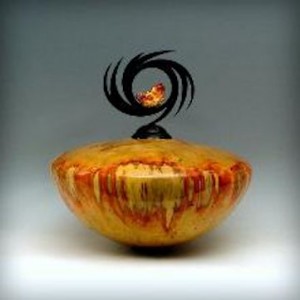 make my unique vessels,” says Potts. “I incorporate classical shapes, inlays, sculptural designs, and the natural inclusions and formations of the wood into my sculpted pieces. I also like to use a variety of natural ornamentation with my artwork. Exotic wood finials, fossils, minerals, gems, and unusual organic elements that were collected from all over the world are used to crown many of my pieces and also used as an avenue for expression. These two seemingly different influences explore the concept of wood given to
make my unique vessels,” says Potts. “I incorporate classical shapes, inlays, sculptural designs, and the natural inclusions and formations of the wood into my sculpted pieces. I also like to use a variety of natural ornamentation with my artwork. Exotic wood finials, fossils, minerals, gems, and unusual organic elements that were collected from all over the world are used to crown many of my pieces and also used as an avenue for expression. These two seemingly different influences explore the concept of wood given to 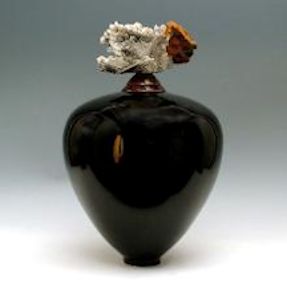 movement and new art form. They also make each piece very expressive, unpredictable, special and individualized. The glasslike finishes on my pieces are made by using a special lacquer mixture. This finish will not crack, but move as the wood moves, insuring that the sculpture will last a lifetime.”
movement and new art form. They also make each piece very expressive, unpredictable, special and individualized. The glasslike finishes on my pieces are made by using a special lacquer mixture. This finish will not crack, but move as the wood moves, insuring that the sculpture will last a lifetime.”
Nancy Strailey received Best of 2D honors for her color pencil drawings of African wildlife on handmade paper which continue a 35,000 year tradition of animal image making through the use of 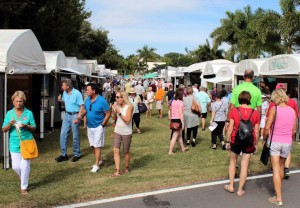 materials as close as possible to their natural state. Nancy strives to awaken the viewer to share the sacred nature of this ancient tradition.
materials as close as possible to their natural state. Nancy strives to awaken the viewer to share the sacred nature of this ancient tradition.
Best of 3D honors went to William Kidd for his organic earthenware forms.
Awards of Distinction were conferred on a dozen other artists:
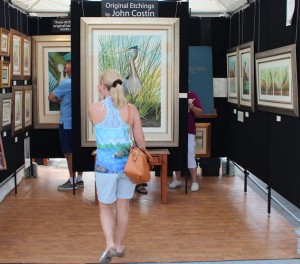 Debra Streidel, 3D, hand-thrown porcelain vessels with sculpted lids
Debra Streidel, 3D, hand-thrown porcelain vessels with sculpted lids- John Costin, 2D, etchings on rag paper
- Vicki Ferguson, 2D, pencil and pastel drawings
- Alex Marksz, 3D, hand-fabricated gold and silver jewelry encrusted with gemstones
- Yorum Gal, 2D, mixed media work consisting of acrylic, ink, gouache and pen on canvas and paper
- Nicario Jimenez, 3D, boxes filled boiled potato
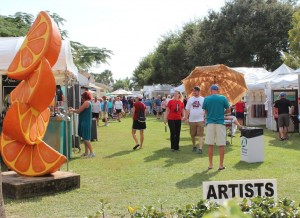 and plaster figurines
and plaster figurines - Estella Fransbergen, 3D, clay and bronze sculpted torsos with skirts made of crocheted wire or semi-precious gems
- David Bryce, 3D, ceramic sculpture
- Nnamdi Okonkwo, 3D, bronze sculpture
- Charles Greenholdt, 2D, watercolor
- Gregory Strachov, 2D, watercolor
 Dennis Stuart, 2d, oil on canvas
Dennis Stuart, 2d, oil on canvas
The Bonita Springs National Art Festival returns to Riverside Park during the last weekend in January, vis: January 30 & 31, 2016.
______________________________________
Day 1 of Bonita National in the books (01-09-16)
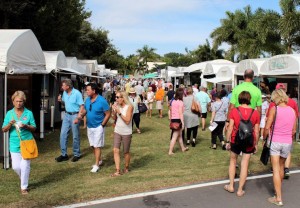 The Bonita Springs National Art Festival opened today in Riverside Park in historic downtown Bonita Springs. Stressing quality and originality in painting, drawing, pastels, photography, handcrafted jewelry, clay works and ceramics, glass art, metal sculpture and more, the festival draw the very best artists from across the United States, Canada, South America and
The Bonita Springs National Art Festival opened today in Riverside Park in historic downtown Bonita Springs. Stressing quality and originality in painting, drawing, pastels, photography, handcrafted jewelry, clay works and ceramics, glass art, metal sculpture and more, the festival draw the very best artists from across the United States, Canada, South America and  Europe each year. So it is no surprise that in 2011, Bonita Springs National was ranked the #10 art festival in the nation by The Art Fair SourceBook and #11 by Sunshine Artist Magazine, and the show continues to impress participating artists and festival-goers alike.
Europe each year. So it is no surprise that in 2011, Bonita Springs National was ranked the #10 art festival in the nation by The Art Fair SourceBook and #11 by Sunshine Artist Magazine, and the show continues to impress participating artists and festival-goers alike.
This year, the festival has overgrown its home in 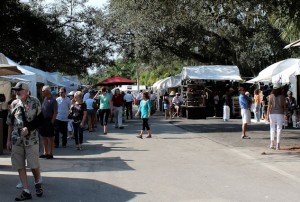 Riverside Park, with a number of artists’ tents and booths straddling Old 41, which is undergoing an upgrade in underground utilities and surfacing. The result is a sprawling, casual environment that encourages attendees to take their time viewing the exhibited artworks and engaging the artists in lively conversation about their process and inspiration. And while all art festivals have some
Riverside Park, with a number of artists’ tents and booths straddling Old 41, which is undergoing an upgrade in underground utilities and surfacing. The result is a sprawling, casual environment that encourages attendees to take their time viewing the exhibited artworks and engaging the artists in lively conversation about their process and inspiration. And while all art festivals have some  carnival-type eating options, Bonita National offers a whole food court with tabletop seating amiably set on the lawn that stretches between the band shell and Jane DeDecker’s Setting the Pace, which has come to symbolize Bonita National since it relocated a handful of years ago from its previous venue in the cramped parking lot of the Promenade at Bonita Bay. But in Riverside Park,
carnival-type eating options, Bonita National offers a whole food court with tabletop seating amiably set on the lawn that stretches between the band shell and Jane DeDecker’s Setting the Pace, which has come to symbolize Bonita National since it relocated a handful of years ago from its previous venue in the cramped parking lot of the Promenade at Bonita Bay. But in Riverside Park, 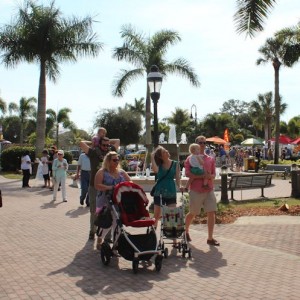 festival goers are not only treated to top notch art by world-renowned artists, but pieces from the City of Bonita Springs’ public art collection, including DeDecker’s Setting the Pace, Lords of the Forest and The Ties that Bind, Lea Vivot’s Secret Bench of Knowledge, Alejandro Nunez’s Mi Pueblo Bonito mural and Dale Rogers’ Away. In fact, Rogers is at Bonita National with a whole new group of metal sculptures. You’ll find him set up next to the fountain in the long shadow of the historic Liles Hotel.
festival goers are not only treated to top notch art by world-renowned artists, but pieces from the City of Bonita Springs’ public art collection, including DeDecker’s Setting the Pace, Lords of the Forest and The Ties that Bind, Lea Vivot’s Secret Bench of Knowledge, Alejandro Nunez’s Mi Pueblo Bonito mural and Dale Rogers’ Away. In fact, Rogers is at Bonita National with a whole new group of metal sculptures. You’ll find him set up next to the fountain in the long shadow of the historic Liles Hotel.
So if you missed Day 1, come out to see the show tomorrow. Bonita Springs National opens at 10 a.m. on Sunday, January 10, and runs until 5 p.m.
____________________________________________________________________________________
With a little help from his friends, Wyoming sculptor Ben Foster to exhibit at Bonita National (01-08-16)
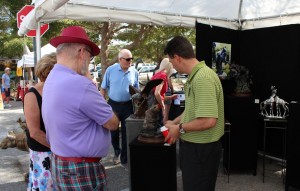 In the dark days preceding and following Christmas, it didn’t look like Wyoming sculptor Ben Foster was going to be able to exhibit his work at this season’s Southwest Florida outdoor art fairs and festivals, including this weekend’s Bonita Springs National Art Festival. It wasn’t due to ill health, a family emergency or scheduling conflict.
In the dark days preceding and following Christmas, it didn’t look like Wyoming sculptor Ben Foster was going to be able to exhibit his work at this season’s Southwest Florida outdoor art fairs and festivals, including this weekend’s Bonita Springs National Art Festival. It wasn’t due to ill health, a family emergency or scheduling conflict. 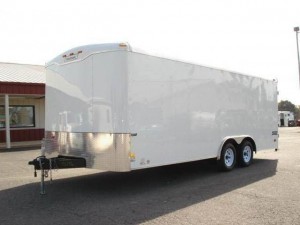 Worse, all of the bronze sculptures he’d brought to Southwest Florida to exhibit and sell were stolen three days before Christmas from a Naples storage facility off Collier Boulevard.
Worse, all of the bronze sculptures he’d brought to Southwest Florida to exhibit and sell were stolen three days before Christmas from a Naples storage facility off Collier Boulevard.
The sculptures were inside a 20-foot white trailer with Wyoming tags (the license number is 10-12049), along with everything Foster and his wife needed to set up their booth at each show,  including his pop-up tent, pedestals, wall coverings and signs. It’s not clear whether the thief or thieves were after the trailer or the 45 sculptures inside. The latter have an estimated value of $230,000 and will take years to replace if they are not returned or recovered by the Collier County Sheriff’s Office, the FBI Art Crimes Team or some other stolen art agency, such as Interpol or the Art Loss Register.
including his pop-up tent, pedestals, wall coverings and signs. It’s not clear whether the thief or thieves were after the trailer or the 45 sculptures inside. The latter have an estimated value of $230,000 and will take years to replace if they are not returned or recovered by the Collier County Sheriff’s Office, the FBI Art Crimes Team or some other stolen art agency, such as Interpol or the Art Loss Register.
As soon as she heard the news of the theft, Estero Fine Art Show Festival Director Patty Narozny leapt into action. She immediately put out the word about Foster’s 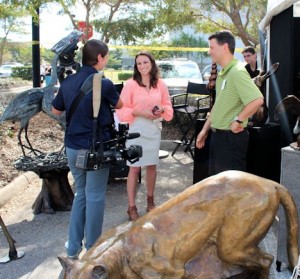 predicament on Facebook, via email and to her contacts in the media (such as Four in Your Corner’s Lisa Greenberg, pictured with Foster in photos 4 & 5). Within hours, collectors from around the country began calling the artist with an offer he couldn’t refuse.
predicament on Facebook, via email and to her contacts in the media (such as Four in Your Corner’s Lisa Greenberg, pictured with Foster in photos 4 & 5). Within hours, collectors from around the country began calling the artist with an offer he couldn’t refuse.
“Our collectors are like family,” said Ben at last weekend’s Estero Fine Art Show at the Miromar Design Center. “They told me I could borrow their pieces and display them at the show, so I spent the 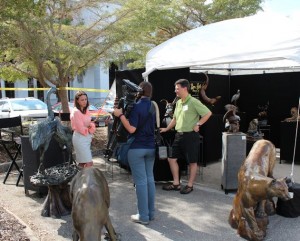 last ten days driving around Florida and up to Georgia picking up many of the bronzes that you see here in my booth.” A half a dozen others were inside the storage facility’s office. “They weren’t ready when I left Wyoming and the foundry shipped them to me. Since I wasn’t around, the storage facility kept them inside until I returned.”
last ten days driving around Florida and up to Georgia picking up many of the bronzes that you see here in my booth.” A half a dozen others were inside the storage facility’s office. “They weren’t ready when I left Wyoming and the foundry shipped them to me. Since I wasn’t around, the storage facility kept them inside until I returned.”
So Foster was able to put together a collection of pieces for sale and to entice commissions, but now he 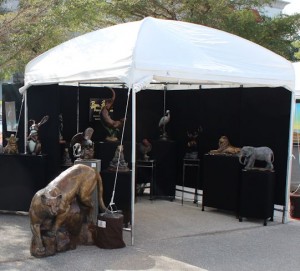 needed a way to display them at the show. That’s when the other artists in the show stepped forward, providing Foster and his wife with pedestals, displays and everything else they needed to set up their booth.
needed a way to display them at the show. That’s when the other artists in the show stepped forward, providing Foster and his wife with pedestals, displays and everything else they needed to set up their booth.
While every artist welcomes commissions, it will take years to replace the 45 artworks that were inside the stolen trailer. Some of Foster’s larger bronzes take more than nine months to complete from inception to cast to fabrication at the  foundry. “There are a limited number of foundries, and they are all really busy. Most can only handle six to nine pieces a year, so there’s a limit to how many bronzes I can create each year,” Foster concedes.
foundry. “There are a limited number of foundries, and they are all really busy. Most can only handle six to nine pieces a year, so there’s a limit to how many bronzes I can create each year,” Foster concedes.
“The trailer also contained hundreds of the tools I use to make the casts I send to the foundries,” Foster noted.
“While I have a list of all the sculptures that were  inside the trailer,” Foster’s wife, Andrea, said at the Estero show, “we have no inventory of the displays or the tools that were inside the trailer. I’m sure that for months we’ll be saying ‘Oh, that was in the trailer too’ every time Ben goes to get a tool he needs.”
inside the trailer,” Foster’s wife, Andrea, said at the Estero show, “we have no inventory of the displays or the tools that were inside the trailer. I’m sure that for months we’ll be saying ‘Oh, that was in the trailer too’ every time Ben goes to get a tool he needs.”
Even if he sells every piece he has available for sale, Foster and his family are looking at a serious disruption of the income stream they count on to stay in business and pay all their bills, including the hefty travel expenses associated with spending months on the road to exhibit at outdoor art fairs 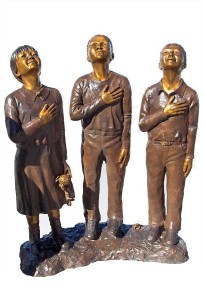 and festivals like this weekend’s Estero Fine Art Show.
and festivals like this weekend’s Estero Fine Art Show.
And so Ben, Andrea and the entire Foster clan hope that the artworks will be found or returned, and toward that end, he is offering a cash reward for information that leads to their recovery. The Collier County Sheriff’s Office is investigating, and anyone with information is asked to call the Collier County Sheriff’s Office at 239-775-8477 or 239-252-9300. You may also contact the FBI’s Art Crimes Team in Miramar, Florida by calling 754-703-2000 or you can submit a tip anonymously at https://tips.fbi.gov/. Since its inception, the Art Crimes Team has recovered more than 2,650 items valued at over $150 million, including approximately 100 paintings from a Florida family’s art 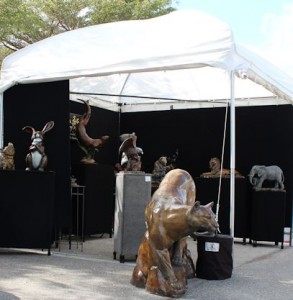 collection that were stolen from a fine art storage facility. That collection included works by Picasso, Rothko, Matisse and others, and the FBI eventually recovered them from locations in Chicago, New York and Tokyo.
collection that were stolen from a fine art storage facility. That collection included works by Picasso, Rothko, Matisse and others, and the FBI eventually recovered them from locations in Chicago, New York and Tokyo.
Foster’s bronze sculptures are collected internationally, and the artist has designed and installed monumental works at universities, schools, municipalities, parks and corporations throughout the United States. He has been featured in numerous one-man shows, group exhibitions, and select juried exhibitions across the nation, as well as magazines such as Southwest Art, Wildlife Art, Sporting Classics, Private Air, Fly Rod and Reel and The Dupont Registry.
___________________________________________________________________
Reichow brings wildlife and floral watercolors to Bonita Springs National (01-06-16)
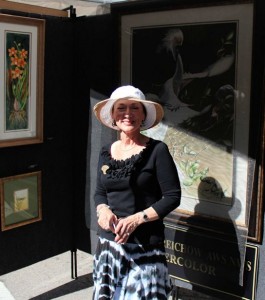 One of the artists participating in this weedend’s Bonita Springs National Art Festival in Riverside Park is watercolorist Christine Reichow.
One of the artists participating in this weedend’s Bonita Springs National Art Festival in Riverside Park is watercolorist Christine Reichow.
Reichow is known both nationally and abroad for floral and wildlife compositions that convey her intimate and deeply-felt love for the delicacy and serenity of the natural world that surrounds her. Reichow credits her father with inspiring her Zen-like respect for nature. Her dad taught her from an early age to quietly observe nesting birds and to listen to the way they communicate with each other through melodic warbling. Her lexicon growing up 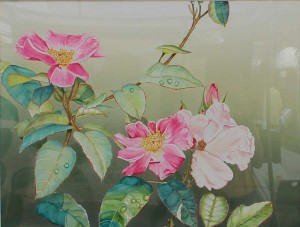 became the names of the trees, plants and flowers that she and her dad encountered as they roamed the Michigan countryside. That vocabulary informs the motifs she selects for her work today.
became the names of the trees, plants and flowers that she and her dad encountered as they roamed the Michigan countryside. That vocabulary informs the motifs she selects for her work today.
Mom was a major influence as well. A lifelong artist, Christine’s mother inspired her to study art and design. Christine majored in textiles and clothing at Michigan State, where she began 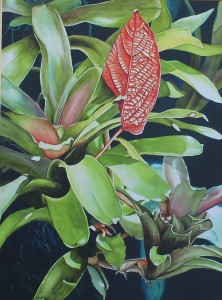 creating hand-dyed and hand-woven pieces using natural fabrics. Following graduation, she began painting on silk to make wearable art that was ultimately displayed in prestigious galleries from Detroit to New York. But it wasn’t until she moved to Florida that she took up painting in watercolors. It is a medium that uniquely enables her to create leaves, petals and anthers that are as luminous as they are transparent.
creating hand-dyed and hand-woven pieces using natural fabrics. Following graduation, she began painting on silk to make wearable art that was ultimately displayed in prestigious galleries from Detroit to New York. But it wasn’t until she moved to Florida that she took up painting in watercolors. It is a medium that uniquely enables her to create leaves, petals and anthers that are as luminous as they are transparent.
“Art is funny,” says Christine, waxing philosophic. “I can spend weeks on a painting and never feel it was quite what I had in mind. Then another painting just flows easily and quickly.”
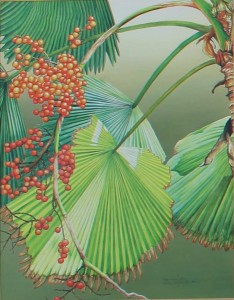 Both her floral and naturalist paintings have appeared on the cover of Watercolor Magic, Sunshine Artist Magazine, Florida Women’s Digest and Natural Awakenings and been featured in The Artists Magazine, Wildlife Art Magazine and Bonita Living. Her prints and original watercolors are showcased in collections at Shadow Wood Preserve Clubhouse in Fort Myers, Florida Bear’s Paw Clubhouse in Naples, Audubon’s Corkscrew Swamp Sanctuary, and Monarch Beach Hotel in Santa Monica, California.
Both her floral and naturalist paintings have appeared on the cover of Watercolor Magic, Sunshine Artist Magazine, Florida Women’s Digest and Natural Awakenings and been featured in The Artists Magazine, Wildlife Art Magazine and Bonita Living. Her prints and original watercolors are showcased in collections at Shadow Wood Preserve Clubhouse in Fort Myers, Florida Bear’s Paw Clubhouse in Naples, Audubon’s Corkscrew Swamp Sanctuary, and Monarch Beach Hotel in Santa Monica, California.
Christine is a member of the American Watercolor Society, Florida Watercolor Society, Watercolor West, and Transparent 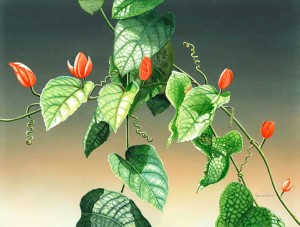 Watercolor Society, as well as a signature member of the National Watercolor Society. Locally, she exhibits her work in more than a dozen outdoor art fairs and festivals each year. Her work is a perennial favorite at Abuse Counseling & Treatment, Inc.’s annual fundraiser, the Art for ACT Fine Art Auction. In fact, one of Reichow’s florals was chosen as the poster art for Art for ACT’s 2012 fine art auction and gala. (Abuse Counseling & Treatment, Inc. (ACT) provides safe shelter and counseling services to victims of domestic violence (and their children), survivors of sexual assault (and their families) and the new and temporarily homeless.)
Watercolor Society, as well as a signature member of the National Watercolor Society. Locally, she exhibits her work in more than a dozen outdoor art fairs and festivals each year. Her work is a perennial favorite at Abuse Counseling & Treatment, Inc.’s annual fundraiser, the Art for ACT Fine Art Auction. In fact, one of Reichow’s florals was chosen as the poster art for Art for ACT’s 2012 fine art auction and gala. (Abuse Counseling & Treatment, Inc. (ACT) provides safe shelter and counseling services to victims of domestic violence (and their children), survivors of sexual assault (and their families) and the new and temporarily homeless.)
_____________________________________________________________________________
Vibrant hues characterize contemporary paintings of Naples artist Belisario Manrique (01-05-16)
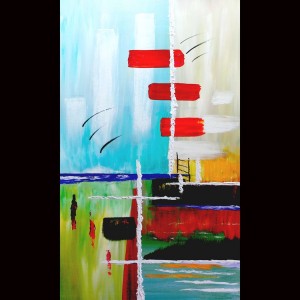 The Bonita Springs National Art Festival returns to Riverside Park on January 9 & 10. One of the artists taking part in the 2-day outdoor art festival is Naples painter Belisario Manrique.
The Bonita Springs National Art Festival returns to Riverside Park on January 9 & 10. One of the artists taking part in the 2-day outdoor art festival is Naples painter Belisario Manrique.
Vivid color is an unmistakable aspect of Manrique’s artistic style. He draws upon his Peruvian background to infuse his contemporary and abstract paintings with vivid and vibrant hues. Belisario utilizes various media to achieve his final works, including acrylic on wood panels applied using brushes, sponges, palette knives and other 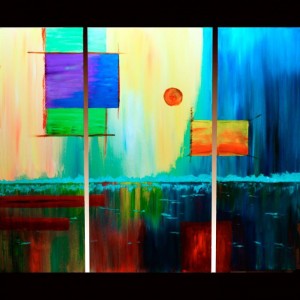 means, and he finishes each one with a clear resin coat. Manrique was one of ten artists receiving Awards of Distinction at this past November’s Estero Fine Art Show, and he was on hand at the Estero Fine Art Show this past weekend for an encore exhibition.
means, and he finishes each one with a clear resin coat. Manrique was one of ten artists receiving Awards of Distinction at this past November’s Estero Fine Art Show, and he was on hand at the Estero Fine Art Show this past weekend for an encore exhibition.
You can view Manrique’s latest offerings this weekend. The Bonita Springs National Art Festival opens each day at 10 a.m. and closes at 5 p.m. For more information about the show and its participating artists, please continue reading.
_________________________________________________________________________
Teresa Hansen children’s sculptures capture spirit and likeness at a moment in time (01-03-16)
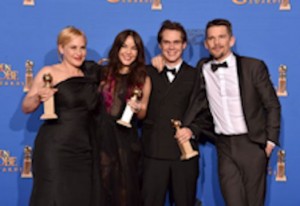 At last year’s Golden Globe Awards, a film by the name of Boyhood won best motion picture, with Richard Linklater receiving accolades as best director and Patricia Arquette taking best supporting actress. Among the factors that made Boyhood so special is the fact that it was filmed over the course of 12 years. Its two child stars literally grow up and Arquette and co-star Ethan
At last year’s Golden Globe Awards, a film by the name of Boyhood won best motion picture, with Richard Linklater receiving accolades as best director and Patricia Arquette taking best supporting actress. Among the factors that made Boyhood so special is the fact that it was filmed over the course of 12 years. Its two child stars literally grow up and Arquette and co-star Ethan 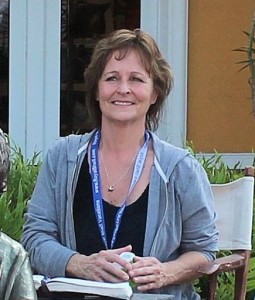 Hawke age right before the audience’s eyes. There may be no one who can better appreciate what Linklater achieved in that film than Loveland, Colorado sculptor Teresa Hansen. Because she casts bronzes of children, her subjects often grow, age and change between the time she starts and completes her commissions.
Hawke age right before the audience’s eyes. There may be no one who can better appreciate what Linklater achieved in that film than Loveland, Colorado sculptor Teresa Hansen. Because she casts bronzes of children, her subjects often grow, age and change between the time she starts and completes her commissions.
“I did a commission of three children for a couple in North Carolina that took me a little more than a year to finish,” Hansen recounted at the Downtown Naples New Year’s Art Fair in 2015. “By the time I delivered them, the children’s faces, bodies and even their personalities had 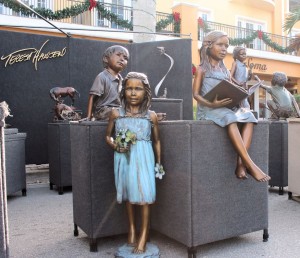 changed quite a bit. But the kids and their grandparents were happy anyway. They’ll always have enduring 3-dimensional images of what they were like at that moment in their development.”
changed quite a bit. But the kids and their grandparents were happy anyway. They’ll always have enduring 3-dimensional images of what they were like at that moment in their development.”
That is especially true with Hansen’s sculptures because she assiduously endeavors to capture not just the likeness of each subject’s face and figure, but their spirit and personality as well. Her overarching intent is to communicate true, 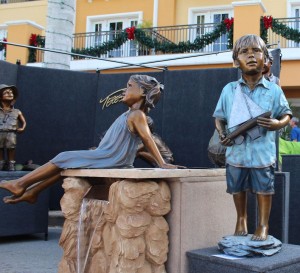 universal feelings expressed within a fleeting, ephemeral moment in time. The admiration of her work along with her acknowledgements and awards reflect this ability.
universal feelings expressed within a fleeting, ephemeral moment in time. The admiration of her work along with her acknowledgements and awards reflect this ability.
Her process is time-intensive. While Teresa often works from photographs, she prefers to visit her clients and subjects so that she can observe them in their natural surroundings and view the place where the sculpture is to be installed. She then creates an oil-based clay model for the client and 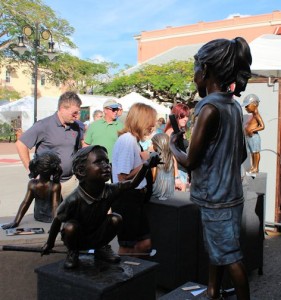 subject to review, which she tweaks and modifies based on the feedback they provide. At this point, she encases the original sculpture in layers of rubber supported by plaster. Most sculptures are rendered in multiple parts, with the head being one part of the mold, an arm another, and so forth. The original is now removed from the mold leaving the negative space inside.
subject to review, which she tweaks and modifies based on the feedback they provide. At this point, she encases the original sculpture in layers of rubber supported by plaster. Most sculptures are rendered in multiple parts, with the head being one part of the mold, an arm another, and so forth. The original is now removed from the mold leaving the negative space inside.
“Wax is poured into the mold and then poured out evenly coating the interior walls of the mold,” Teresa explains. “About three coats of wax are needed in 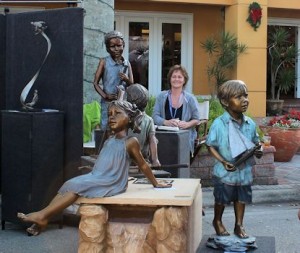 order to make a hollow wax replica of the original sculpture. After cooling, this hollow wax replica is removed from the mold and any surface imperfections in the wax are corrected. This part of the process is referred to as ‘wax chasing.’ And once that’s done, wax rods or ‘sprues’ are added to guide molten metal into the piece, as are vents to release air when the metal is poured. The piece is then dipped into a heat resistant liquid or ‘slurry,’ and coated with a heat resistant sand or stucco. Six
order to make a hollow wax replica of the original sculpture. After cooling, this hollow wax replica is removed from the mold and any surface imperfections in the wax are corrected. This part of the process is referred to as ‘wax chasing.’ And once that’s done, wax rods or ‘sprues’ are added to guide molten metal into the piece, as are vents to release air when the metal is poured. The piece is then dipped into a heat resistant liquid or ‘slurry,’ and coated with a heat resistant sand or stucco. Six 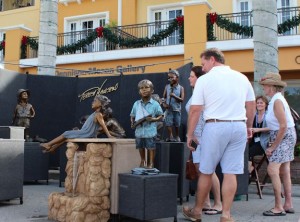 to twelve coats are required, and each has to be completely dry before the next coat can be applied.”
to twelve coats are required, and each has to be completely dry before the next coat can be applied.”
But Teresa is far from finished. After the ceramic shell is fully dry, the piece is inverted and placed in a kiln at 1800 degrees, which hardens the shell. The wax melts and pours out of the ceramic shell. This empty ceramic shell is placed in a sand pit 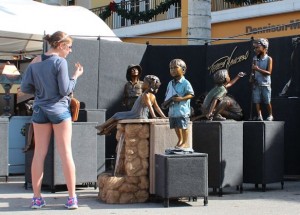 with the pouring cup at the top. Molten bronze heated to 2200 degrees is poured into the cup and down through the “sprues” into the cavities of the shell. After a cooling period the shell is broken away revealing the bronze casting. The next stage is metal chasing out any imperfections. The sprues are cut off, the sculpture is sand blasted, and any parts that were separately cast are welded back
with the pouring cup at the top. Molten bronze heated to 2200 degrees is poured into the cup and down through the “sprues” into the cavities of the shell. After a cooling period the shell is broken away revealing the bronze casting. The next stage is metal chasing out any imperfections. The sprues are cut off, the sculpture is sand blasted, and any parts that were separately cast are welded back 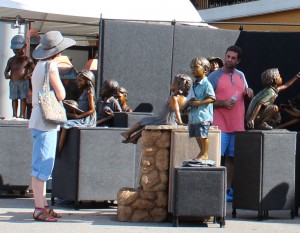 together. Then, finally, various compounds are brushed or sprayed onto the metal to create the “patina.” Using hot and cold techniques, different formulations are applied to create a variety of colors.
together. Then, finally, various compounds are brushed or sprayed onto the metal to create the “patina.” Using hot and cold techniques, different formulations are applied to create a variety of colors.
“It’s a 4,000-year-old process known as cire perdue or lost-wax metal casting,” Teresa points out. “Although materials have improved and new 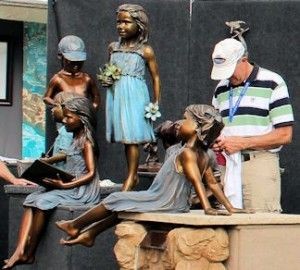 technology is employed, each step of the process of casting bronze today is the same as that used thousands of years ago.”
technology is employed, each step of the process of casting bronze today is the same as that used thousands of years ago.”
And it’s also why commissions can take a year or more to complete.
But the effort is well worth the time.
Among Teresa’s most recognized commissions are Healing Touch at McKee Hospital in Loveland, Colorado, Lil’ Bo Peep and Lil’ Red Riding Hood at 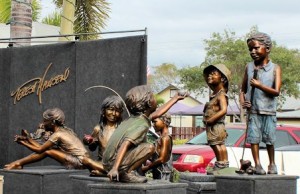 R. W. Norton Art Gallery and Museum in Shreveport, Louisiana, Star Struck at University of South Alabama Children’s and Women’s Hospital in Mobile, Alabama, Hunter at Memphis Botanic Gardens in Memphis, Tennessee, and Turning Point installed to honor the inventor of snowboarding, Sherman Poppen.
R. W. Norton Art Gallery and Museum in Shreveport, Louisiana, Star Struck at University of South Alabama Children’s and Women’s Hospital in Mobile, Alabama, Hunter at Memphis Botanic Gardens in Memphis, Tennessee, and Turning Point installed to honor the inventor of snowboarding, Sherman Poppen.
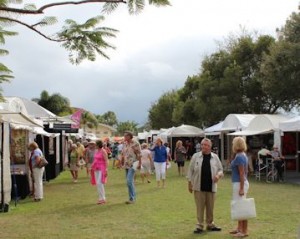 “Each piece of art is a learning opportunity and a new discovery,” Hansen states expansively. “ I am inspired by my diverse life experiences, most precious memories and my vision of the future. As our lives can change in seconds, an expression, feeling, or emotion can change with the slightest movement of clay, pencil, or brush leaving a lasting impression. My desire is to capture the genuine emotion of each moment and to evoke
“Each piece of art is a learning opportunity and a new discovery,” Hansen states expansively. “ I am inspired by my diverse life experiences, most precious memories and my vision of the future. As our lives can change in seconds, an expression, feeling, or emotion can change with the slightest movement of clay, pencil, or brush leaving a lasting impression. My desire is to capture the genuine emotion of each moment and to evoke 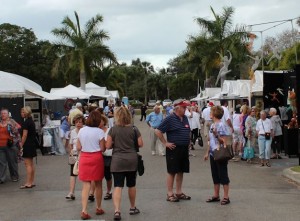 a smile and a feeling of joy in all those who see my sculpture.”
a smile and a feeling of joy in all those who see my sculpture.”
Teresa realized that art was her calling early on, and memories of time spent in front of her grandparents’ fireplace on cool rainy days fueled her desire to be a full-time artist. She followed this path by taking classes in various media, and while she became skilled in pewter, pencil, 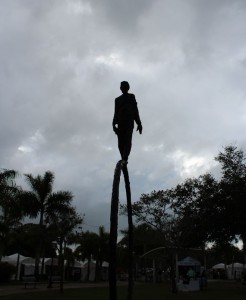 paper cast, watercolor and oil, her media of choice is and has always been three-dimensional and relief bronze.
paper cast, watercolor and oil, her media of choice is and has always been three-dimensional and relief bronze.
To perfect her craft, she moved to Loveland, Colorado to work with several renowned sculptors who helped her take her abilities to the next level. (Bonita Springs residents and visitors may recall that Loveland is also home to monumental sculptor Jane D. Decker, who created Setting the Pace, Lords of the Forest and The Ties That Bind, three bronze sculptures that the City of Bonita Springs’ Art in Public Places Board purchased in 2007.) It didn’t take long for Loveland to 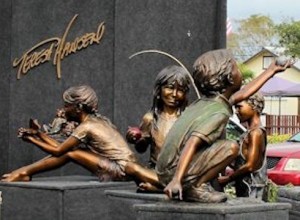 recognize Hansen’s unique ability to work in fine detail and capture likeness in stylized realism and figurative sculpture. Today, Teresa dedicates herself fully to her work, often conscripting her children and grandchildren as muses and hand models for specific pieces. In fact, her son Jason became so enamored of his mother’s talent and process over the years that he has followed in her
recognize Hansen’s unique ability to work in fine detail and capture likeness in stylized realism and figurative sculpture. Today, Teresa dedicates herself fully to her work, often conscripting her children and grandchildren as muses and hand models for specific pieces. In fact, her son Jason became so enamored of his mother’s talent and process over the years that he has followed in her 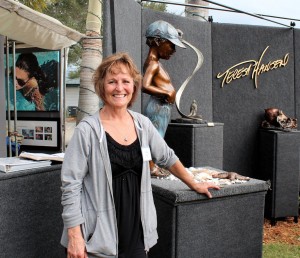 footsteps, something that gives Teresa even greater pride than the numerous awards and accolades she has received over the course of her career.
footsteps, something that gives Teresa even greater pride than the numerous awards and accolades she has received over the course of her career.
Hansen credits her success on her ability to see things in people, nature and the objects that surround her that the rest of us miss. She notices the energy in every movement and sees the detail of every feature. She intently studies her environment to be more precise and accurate in 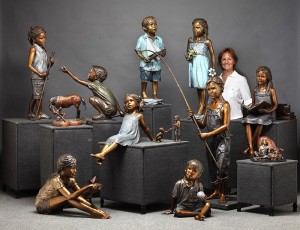 her work. That is why if you were to ask Teresa how much time she spent on a particular piece, her answer would inevitably be: “My whole life.” While each piece is uniquely different, each shows her natural talent and the depth of her experience.
her work. That is why if you were to ask Teresa how much time she spent on a particular piece, her answer would inevitably be: “My whole life.” While each piece is uniquely different, each shows her natural talent and the depth of her experience.
The Bonita Springs National Art Festival opens at 10 a.m. and closes at 5 p.m. both days. The festival is free, although a $5 donation is requested at the gate. All funds raised from and artist application and booth fees are used by the Center for the Arts to provide scholarships, exhibitions, community events, and low-cost youth and adult art programming and classes.
___________________________________________________________________________________
Glass artist Scott Amrhein one of artists participating in Bonita Springs National Art Festival (01-03-16)
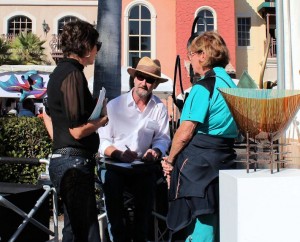 The Bonita Springs National Art Festival takes place in historic Riverside Park on January 9 & 10. Among the more than 200 talented artists participating in the two-day show is Wisconsin glass artist Scott Amrhein.
The Bonita Springs National Art Festival takes place in historic Riverside Park on January 9 & 10. Among the more than 200 talented artists participating in the two-day show is Wisconsin glass artist Scott Amrhein.
Amrhein characterizes his creations as evolutionary art glass, a term he uses to signify that he continually refines the process he developed to fire the glass at his Sherwood atelier, 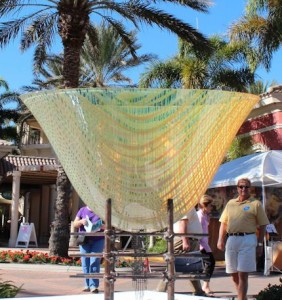 High Cliff Studio. To produce the mesmerizing organic patterns that have become his signature, Scott applies a metallic glaze before he heats and stretches the glass in his kiln. But the glaze resists stretching, resulting in markings as unique as a fingerprint or the iris of the human eye. No two are ever the same, and not even Amhrein can predict the outcome of a particular firing.
High Cliff Studio. To produce the mesmerizing organic patterns that have become his signature, Scott applies a metallic glaze before he heats and stretches the glass in his kiln. But the glaze resists stretching, resulting in markings as unique as a fingerprint or the iris of the human eye. No two are ever the same, and not even Amhrein can predict the outcome of a particular firing.
Even the elliptical design of many of Amrhein’s bowls come about as the result of trial and error. “I was trimming the glass on a bowl one day,” Scott explained at a break during the Bonita Springs National Art 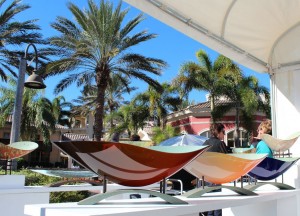 Festival in January of 2012,” and one side cracked in an arc. I loved the pattern I’d gotten and didn’t really want to throw away the glass, so I decided to cut the other side to match.” The elliptical design became so popular, it is now a trademark of Amrhein’s lumen bowls.
Festival in January of 2012,” and one side cracked in an arc. I loved the pattern I’d gotten and didn’t really want to throw away the glass, so I decided to cut the other side to match.” The elliptical design became so popular, it is now a trademark of Amrhein’s lumen bowls.
“To complement the lumen bowls,” says Scott, “we have designed and fabricated a variety of primitive 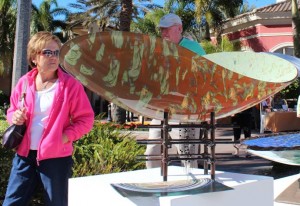 pedestals from charred wood and patinaed copper resulting in a striking presentation and a soothing blend of textures. Simplicity of design and the absence of primary color is beneficial when displaying this art in various settings.” The striking pedestals are yet another example of Scott’s unique and exceptional hand-crafted artwork.
pedestals from charred wood and patinaed copper resulting in a striking presentation and a soothing blend of textures. Simplicity of design and the absence of primary color is beneficial when displaying this art in various settings.” The striking pedestals are yet another example of Scott’s unique and exceptional hand-crafted artwork.
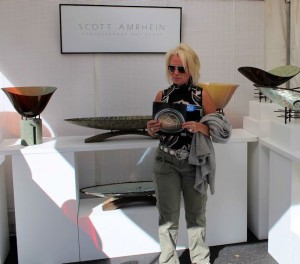 Amrhein’s art glass has garnered numerous awards. In 2015, he received First Place Best of Category at the Port Clinton Art Festival in Highland Park, Illinois, an Award of Excellence – Glass at the Art Fair on the Square at Lake Forest, Illinois, and Second Place at the St. Louis Art Fair. In 2014, the accolades her received included Best in Shows at the Port Clinton Art Festival in Highland Park, Illinois and New Orleans Jazz and Heritage Festival, an Award of Excellence at the
Amrhein’s art glass has garnered numerous awards. In 2015, he received First Place Best of Category at the Port Clinton Art Festival in Highland Park, Illinois, an Award of Excellence – Glass at the Art Fair on the Square at Lake Forest, Illinois, and Second Place at the St. Louis Art Fair. In 2014, the accolades her received included Best in Shows at the Port Clinton Art Festival in Highland Park, Illinois and New Orleans Jazz and Heritage Festival, an Award of Excellence at the 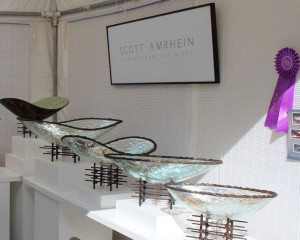 Lakefront Festival of Art in Milwaukee, and Awards of Distinction in Art on the Square South Lake, Texas and Naples National Art Festival. As expected, his lumen bowls are coveted both by collectors and galleries and museums nationwide. Because they complement most architectural styles and home decor motifs, they work as well in showcase homes in Palm Beach as they do in rustic weekend retreats in Colorado and Wyoming. Today over 90 galleries in the United States, Canada and Puerto Rico display the lumen bowls, including the Corning Museum of Glass in New York and the Los Angeles Museum of Art.
Lakefront Festival of Art in Milwaukee, and Awards of Distinction in Art on the Square South Lake, Texas and Naples National Art Festival. As expected, his lumen bowls are coveted both by collectors and galleries and museums nationwide. Because they complement most architectural styles and home decor motifs, they work as well in showcase homes in Palm Beach as they do in rustic weekend retreats in Colorado and Wyoming. Today over 90 galleries in the United States, Canada and Puerto Rico display the lumen bowls, including the Corning Museum of Glass in New York and the Los Angeles Museum of Art.
The Bonita Springs National Art Festival opens at 10 a.m. and closes at 5 p.m. both days.














 Tom Hall is both an amateur artist and aspiring novelist who writes art quest thrillers. He is in the final stages of completing his debut novel titled "Art Detective," a story that fictionalizes the discovery of the fabled billion-dollar Impressionist collection of Parisian art dealer Josse Bernheim-Jeune, thought by many to have perished during World War II when the collection's hiding place, Castle de Rastignac in southern France, was destroyed by the Wehrmacht in reprisal for attacks made by members of the Resistance operating in the area. A former tax attorney, Tom holds a bachelor's degree as well as both a juris doctorate and masters of laws in taxation from the University of Florida. Tom lives in Estero, Florida with his fiancee, Connie, and their four cats.
Tom Hall is both an amateur artist and aspiring novelist who writes art quest thrillers. He is in the final stages of completing his debut novel titled "Art Detective," a story that fictionalizes the discovery of the fabled billion-dollar Impressionist collection of Parisian art dealer Josse Bernheim-Jeune, thought by many to have perished during World War II when the collection's hiding place, Castle de Rastignac in southern France, was destroyed by the Wehrmacht in reprisal for attacks made by members of the Resistance operating in the area. A former tax attorney, Tom holds a bachelor's degree as well as both a juris doctorate and masters of laws in taxation from the University of Florida. Tom lives in Estero, Florida with his fiancee, Connie, and their four cats.